How to test user journeys
In this final lesson, we are going to introduce you to the concept of “user journeys” and how to write tests for them.

What are user journeys?
User journeys are the essential paths a user of your application takes.
In a future lesson , we go into greater detail about what a user journey is, but we wanted to introduce you to this concept right from the start since it is incredibly valuable for testing.
For example, in the context of our course application:
- A user lands on the home page and finds one of the courses.
- They click on the “Get started” button and are taken to the course landing page.
- They click on the “Start Course” button and are taken to the first lesson of that course.
- They read the lesson and complete the quiz at the bottom.
- After answering the quiz correctly, they click on the “Next Lesson” button and are taken to the next lesson.
Now that we understand what a user journey is, and how a user of our course application might behave, we can now write a single test that verifies that all of these steps are working correctly.
What makes a user journey test so valuable is the fact that you are testing every aspect of your system and application within a single test.
Writing our user journey test
First, let's create a new test called cypress/e2e/user-journey.cy.ts
First, we need to visit the home page of our application.
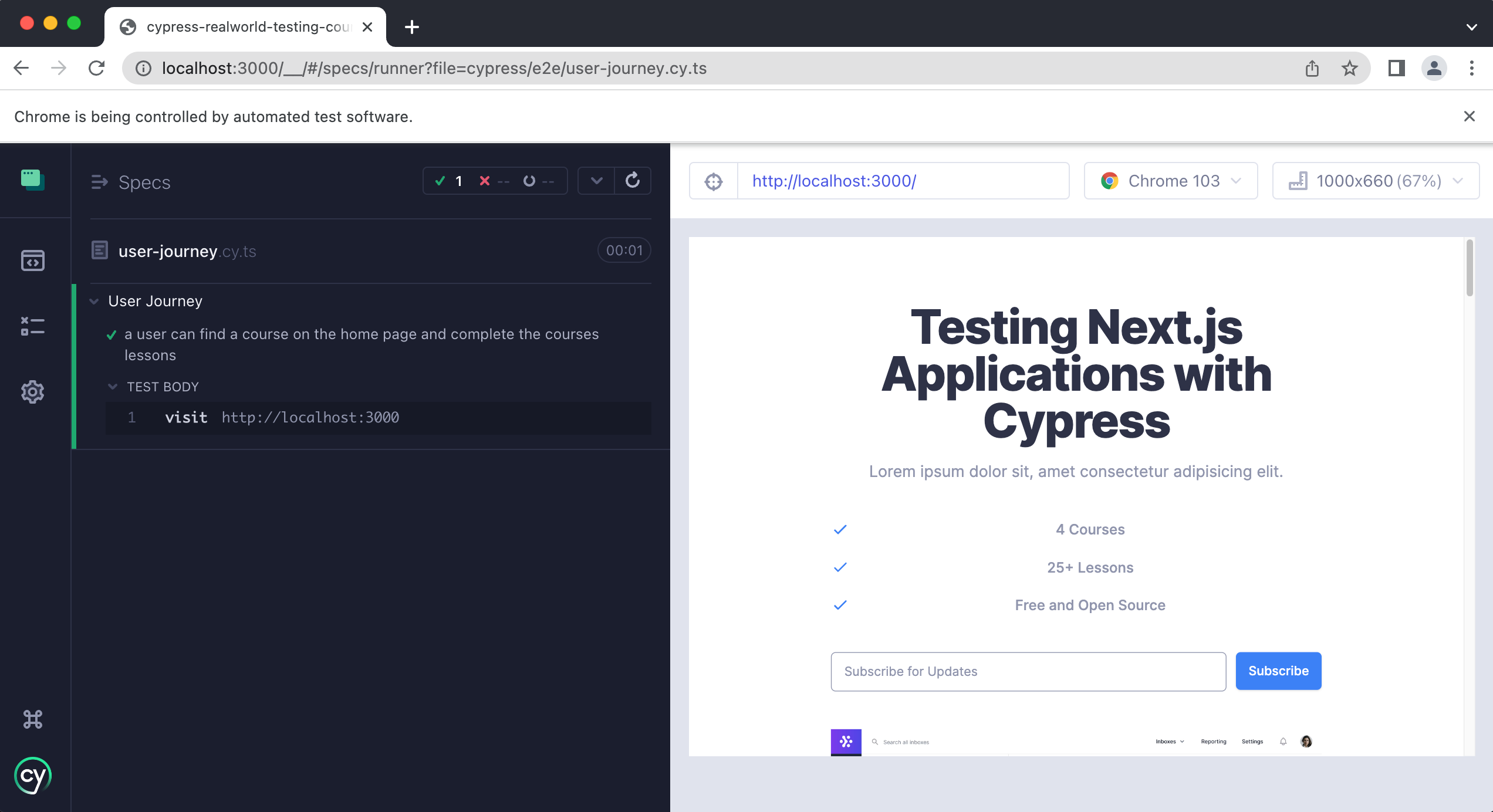
You can click on the images to enlarge them.
Next, we need to get the “Get started” button of one of our courses
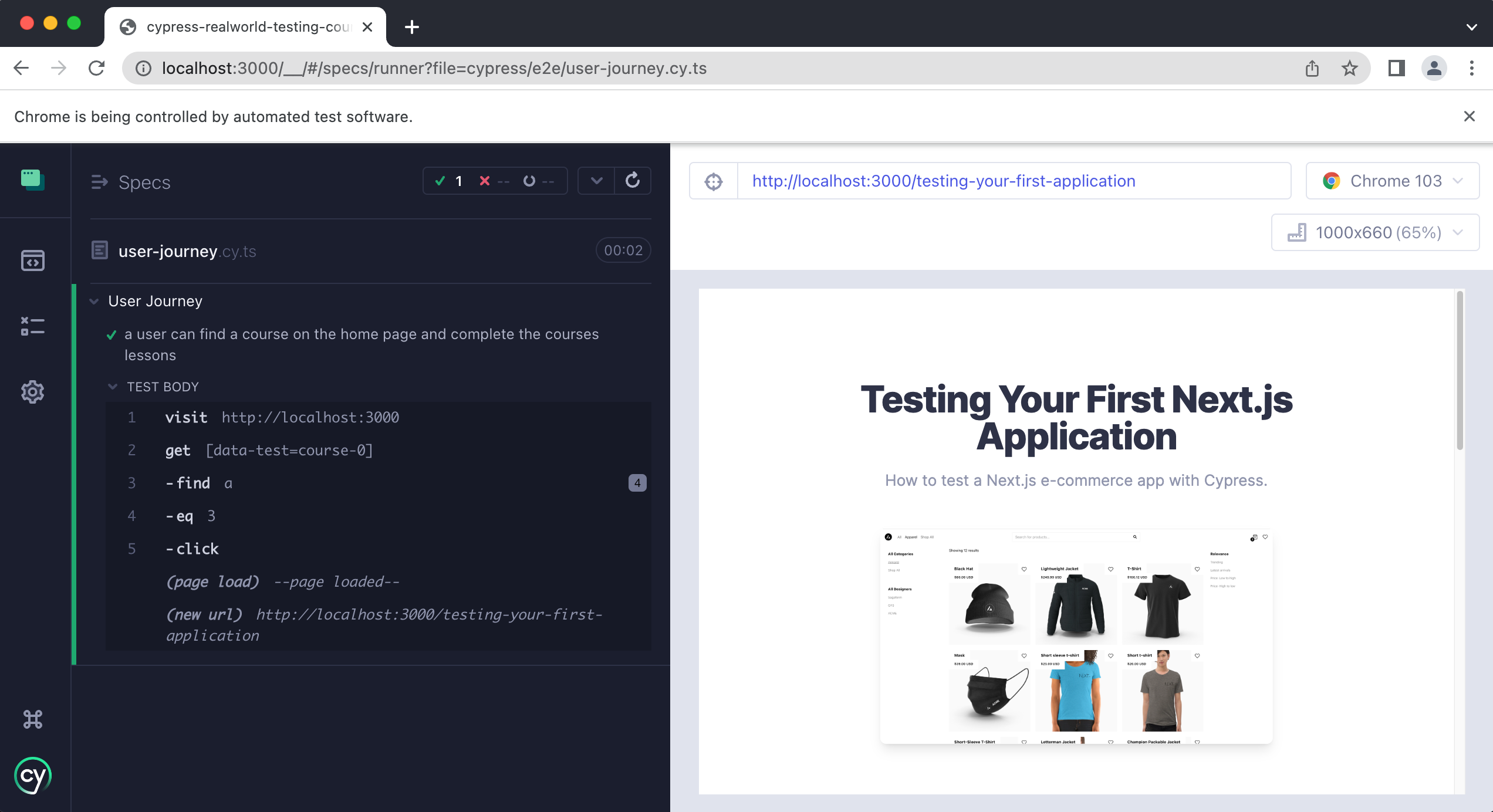
Then we will write an assertion that the “Get started” button has navigated the user to the correct course page.
Next, we need to get the “Start Course” button and click on it.

We will then write another assertion to verify that the “Start Course” button has navigated our user to the correct lesson page.
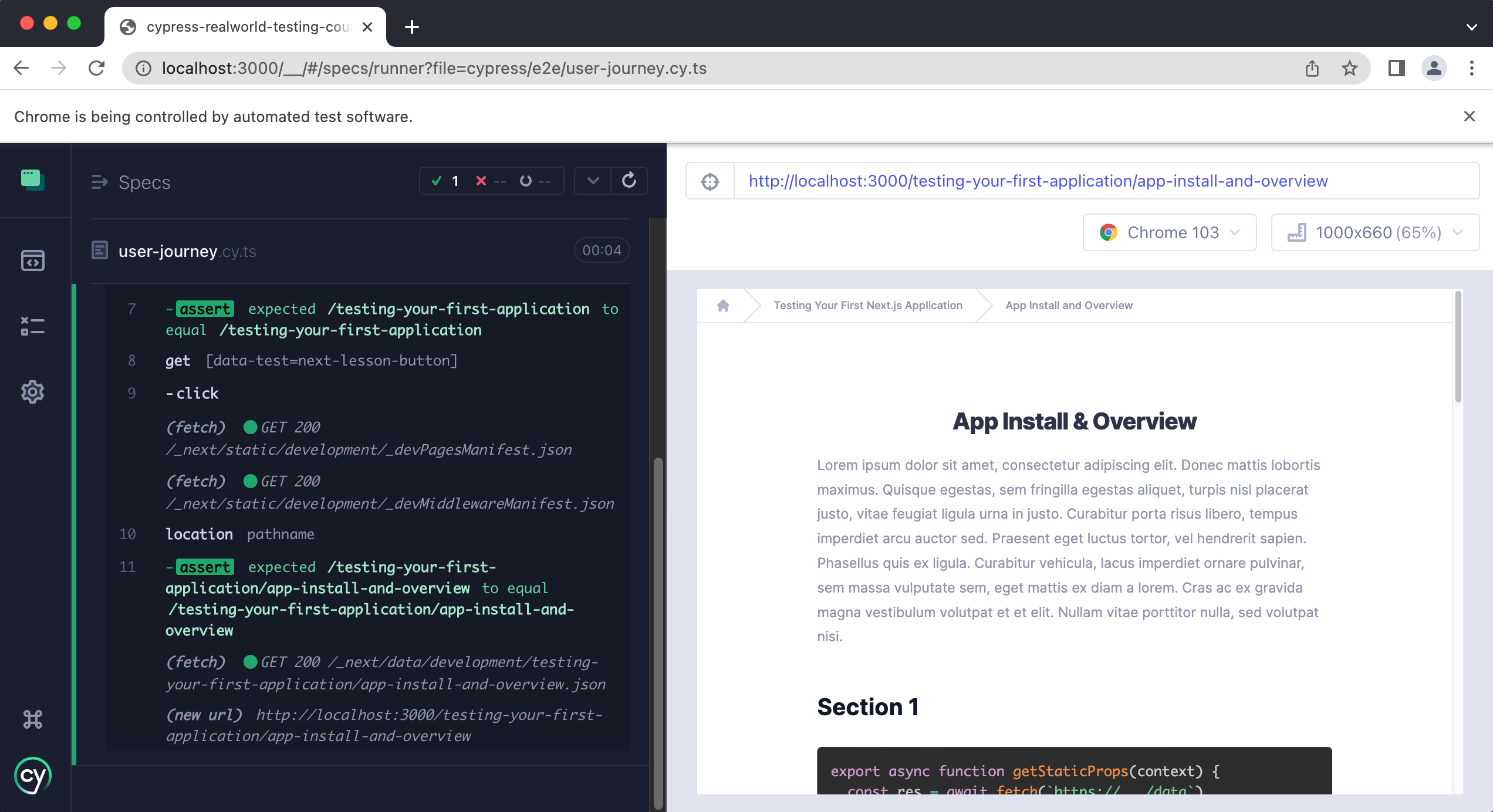
Then we need to complete the quiz at the bottom of the page.
In this demo application, all of the answers are true.
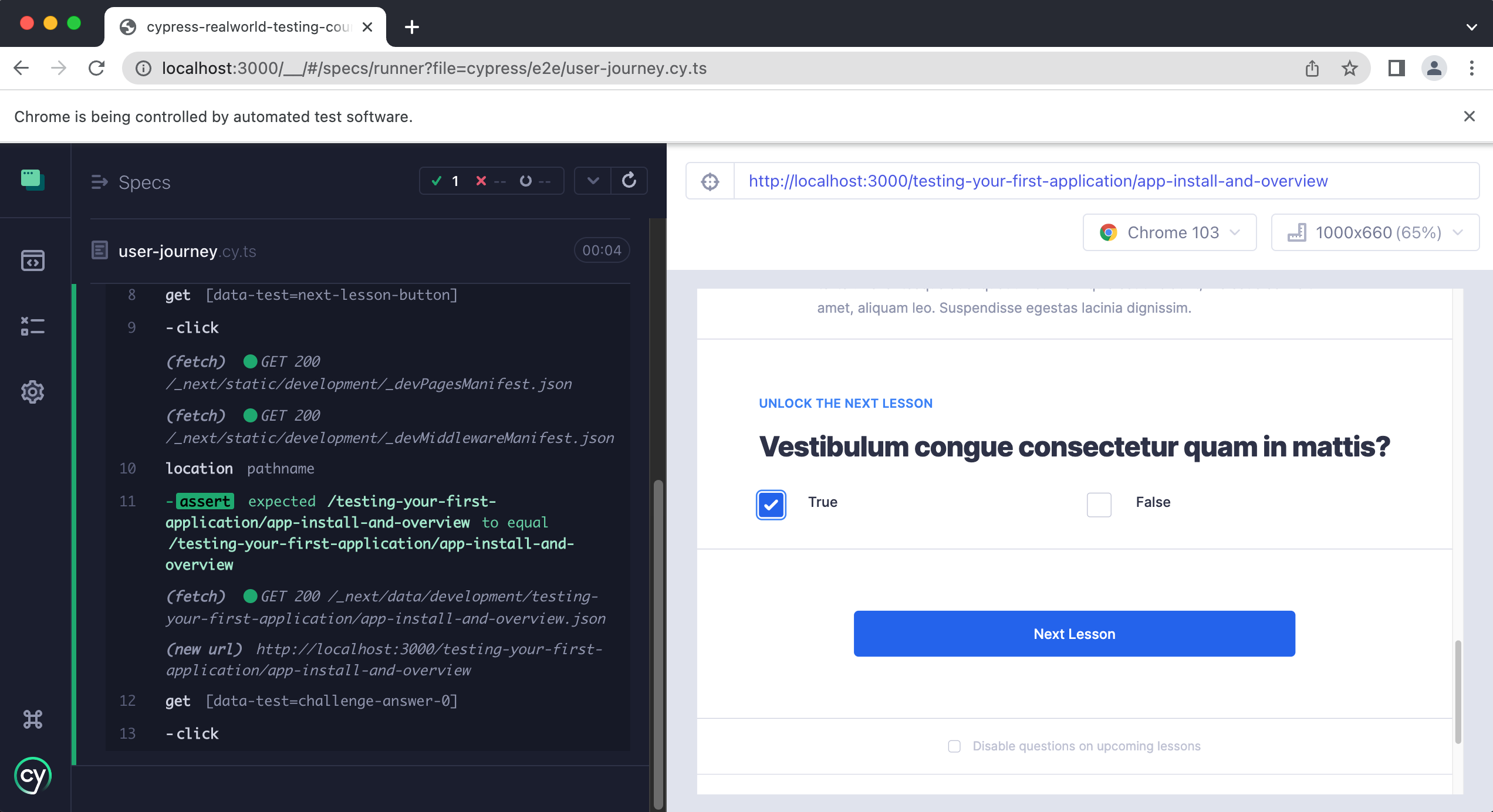
We then want to assert that the “Next Lesson” button has appeared on the page and then click it.
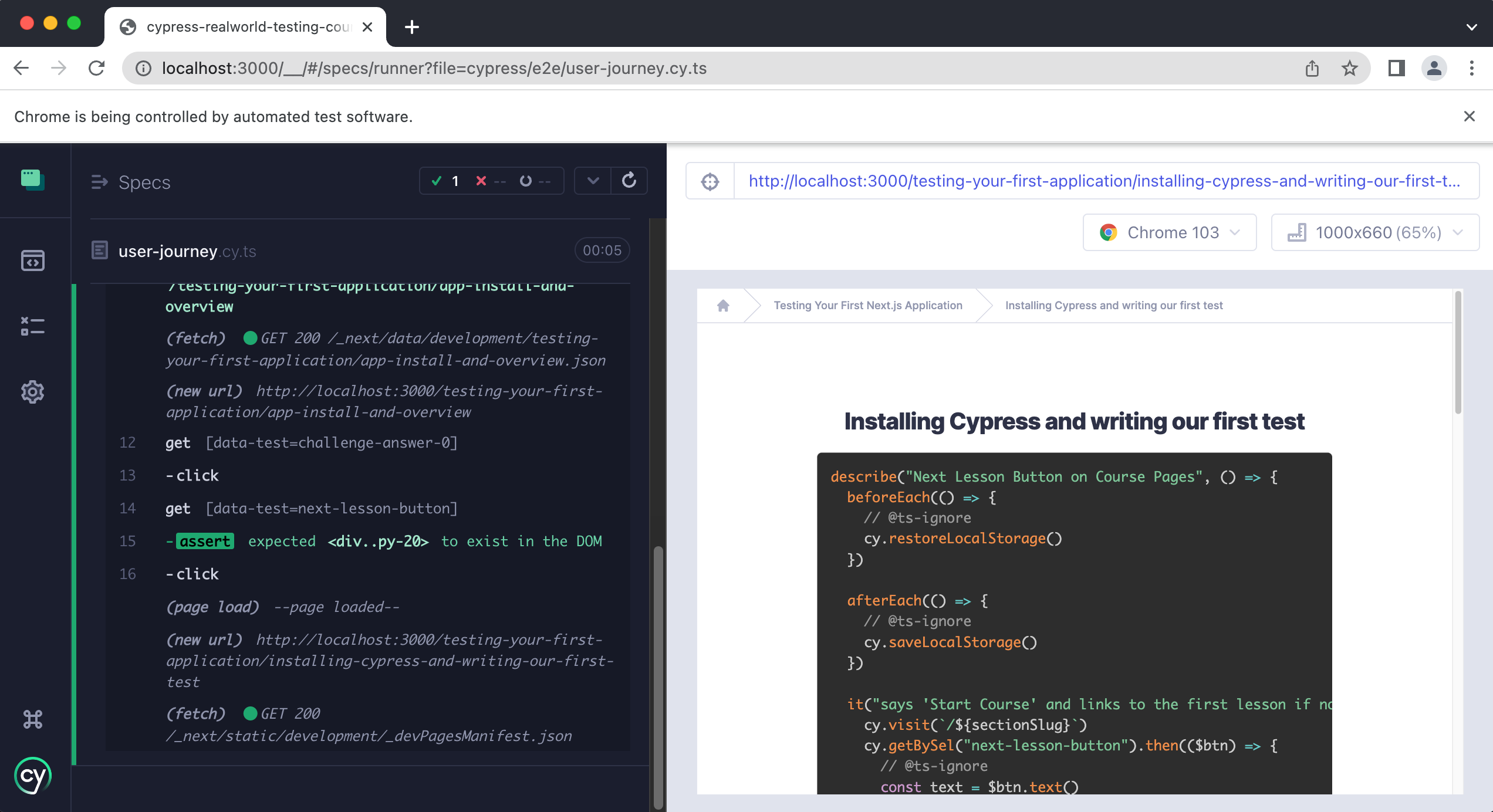
Finally, we write our final assertion that verifies that the “Next Lesson” takes the user to the correct lesson page.
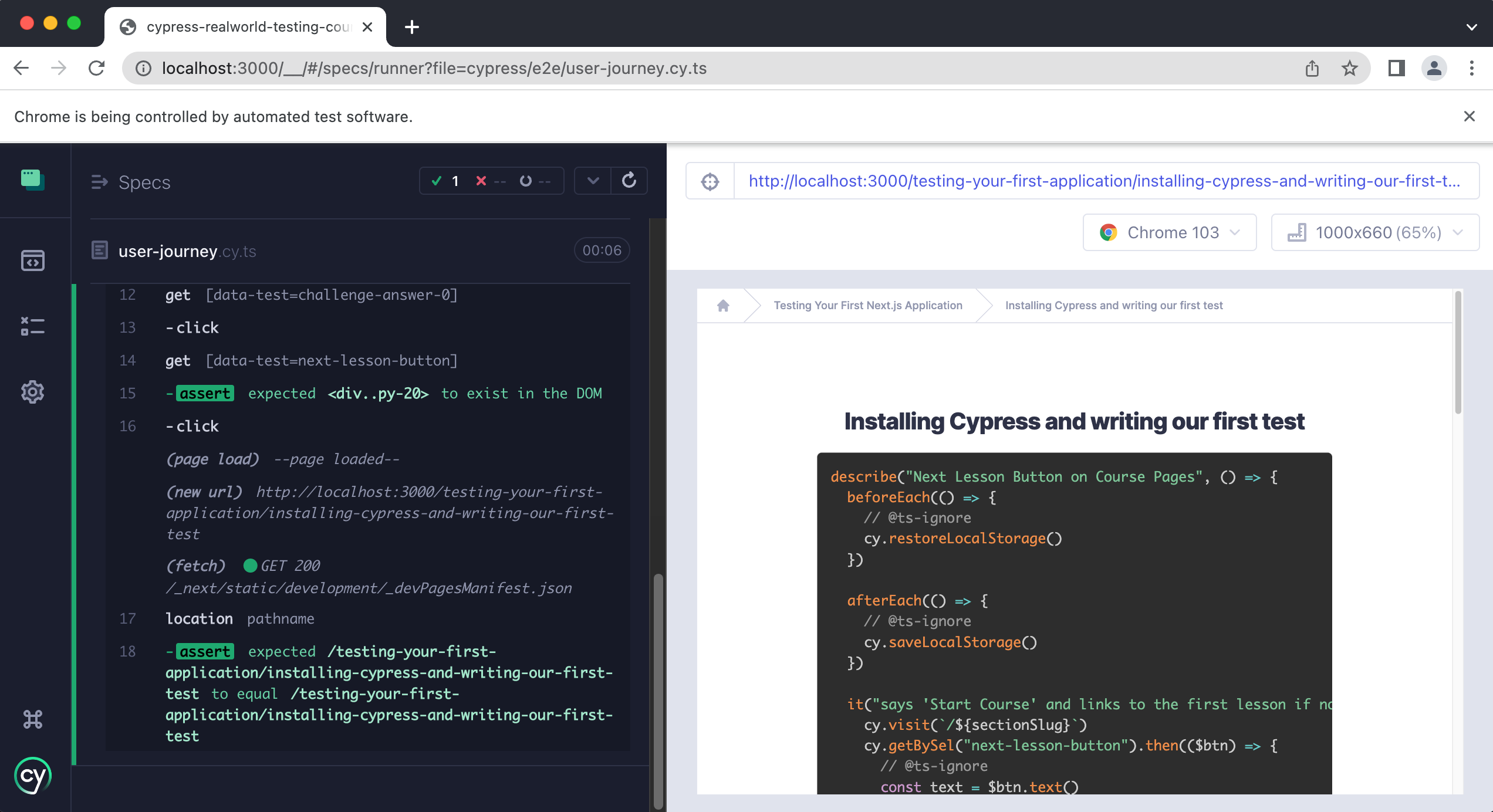
Now it is time for you to put what you have just learned into practice. Finish writing this user journey test so that the user completes all of the lessons in the first course.
Once they have, the next lesson button that appears after completing the final quiz should say "Complete course" and then take them to the home page.
If you get stuck the answers are provided below.
Practice Answers
In this lesson, you learned what a user journey is and why they are so valuable for testing. Then you learned about a possible user journey a user of our course application can take. Finally, we wrote a single test that covered and verified all of the steps in our user journey.
Congrats on completing the first course 🎉
You are now prepared to take the next course, Testing Foundations .
🚀 NEW: GitHub x BugBug Integration - See how to get a real-time feedback on test results within your repository
- Why choose us
- Integrations
- Documentation
- Book a demo
- For Developers
- For Product Managers
- Case studies
- Test Automation Guides
- Testing Tools Comparison
- XPath Selector Builder
What is User Journey Testing? Guide for Software Testers
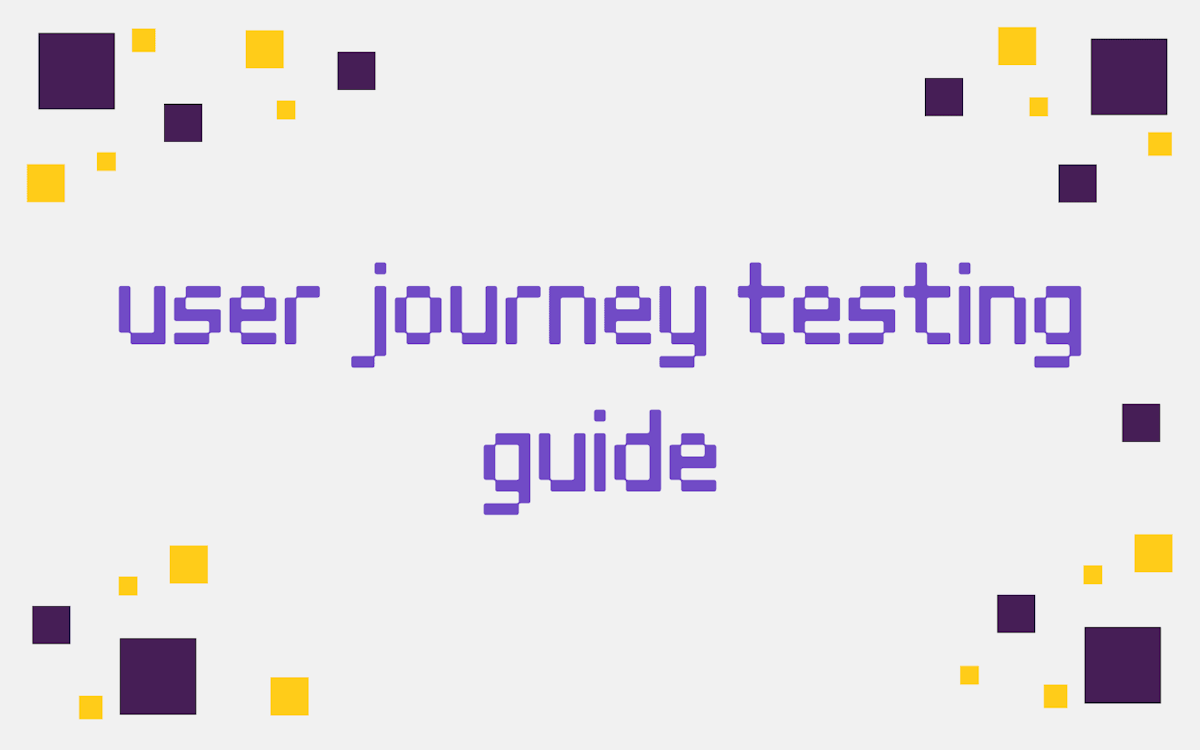
Dominik Szahidewicz
Table of Contents
What Is a Journey test?
What is a e2e journey test , best practises for user journey testing, benefits of user journey tests, how to run user journey tests in bugbug.
In today's digital landscape, ensuring that your application functions seamlessly from start to finish is a critical aspect of software development. One powerful approach to achieve this is through using user journey test.
Customer journey end-to-end tests offer an insight into application's usability (especially in the context of UX research) as it replicates the steps of a typical user inside the application or browser.
User journeys are the paths that users take as they interact with a software application, from their initial contact with the interface to the final accomplishment of their goal. Journey encompasses a series of steps, which may involve different features, pages, or functionalities of the application.
These journeys are diverse, as they reflect the variety of actions users can perform within an application, such as signing up, making a purchase, or submitting a form. They can be represented visually as a user journey map.
E2E Journey Test is a type of usability testing method in software development that focuses on simulating the complete path a user takes while interacting with a mobile app or website.
This approach aims to replicate the real-world user experience by following a series of steps and actions that a person would perform to achieve a specific user goal or task within the software.
The primary objective of a user journey testing sessions is to assess how well different components, functionalities, and interfaces of an application work together to deliver a seamless and satisfying user experience.
This method goes beyond evaluating individual features in isolation and instead tests the end-to-end workflow that user follows, ensuring that all components integrate smoothly and perform as expected.
Best practices for User Journey Tests include:
1. Identify Critical User Journeys: Prioritize user paths that align with your business goals or are frequently used by your target audience.
2. Identify Different Scenarios: Users interact with applications in various ways. Make sure you cover different scenarios, including positive and negative cases, edge cases, and variations in user needs and inputs.
3. Use Realistic Test Data: Utilize realistic and diverse test data that mimics actual user behavior. This includes using valid and invalid inputs, different user roles, and varying data combinations.
4. Create Clear Test Scripts: Document the steps and interactions. Clear and well-structured test scripts ensure consistency and accuracy during testing and help other team members understand the entire process.
5. Automate: Test automation tools can significantly speed up the process while ensuring repeatability and accuracy.
6. Isolate Environments: Use isolated testing environments to prevent interference from other ongoing tests or changes.
7. API Testing Integration: Integrate API testing to validate the communication between different components.
8. Parallel Testing: Run multiple tests in parallel to save time and accelerate the testing process.
9. Monitor and Analyze Results: Regularly monitor and analyze the results. Identify patterns, trends, and areas of improvement. Act on any issues identified promptly to ensure a smooth user experience.
10. Feedback Loop: Encourage collaboration between developers, testers, and user experience design teams. Regularly gather feedback and collaborate to refine and improve customer journey.
User journey testing offers several benefits that contribute to a higher-quality user experience and more reliable software:
- Realistic Testing: By simulating real customer experience, you can show more accurate test results that represent how the application functions in a real-world scenario.
- End-to-End Validation: User journey tests validate the entire application workflow, detecting integration issues that might go unnoticed with unit or component testing.
- Improved Bug Detection: This approach helps identify complex bugs and glitches that arise from the interactions between different components of the application.
- Enhanced User Satisfaction: Consistently delivering a smooth user experience increases user satisfaction and loyalty, leading to better retention rates.
- Reduced Development Costs: Detecting and addressing issues early in the development process can help avoid costly fixes later on.
With BugBug we could verify holistic and typical functionality of an online shop. We can set up a scenario where first we choose an item, add it to the cart and then proceed to the payment.
Log in and create a new test on bugbug.io
Create a new test
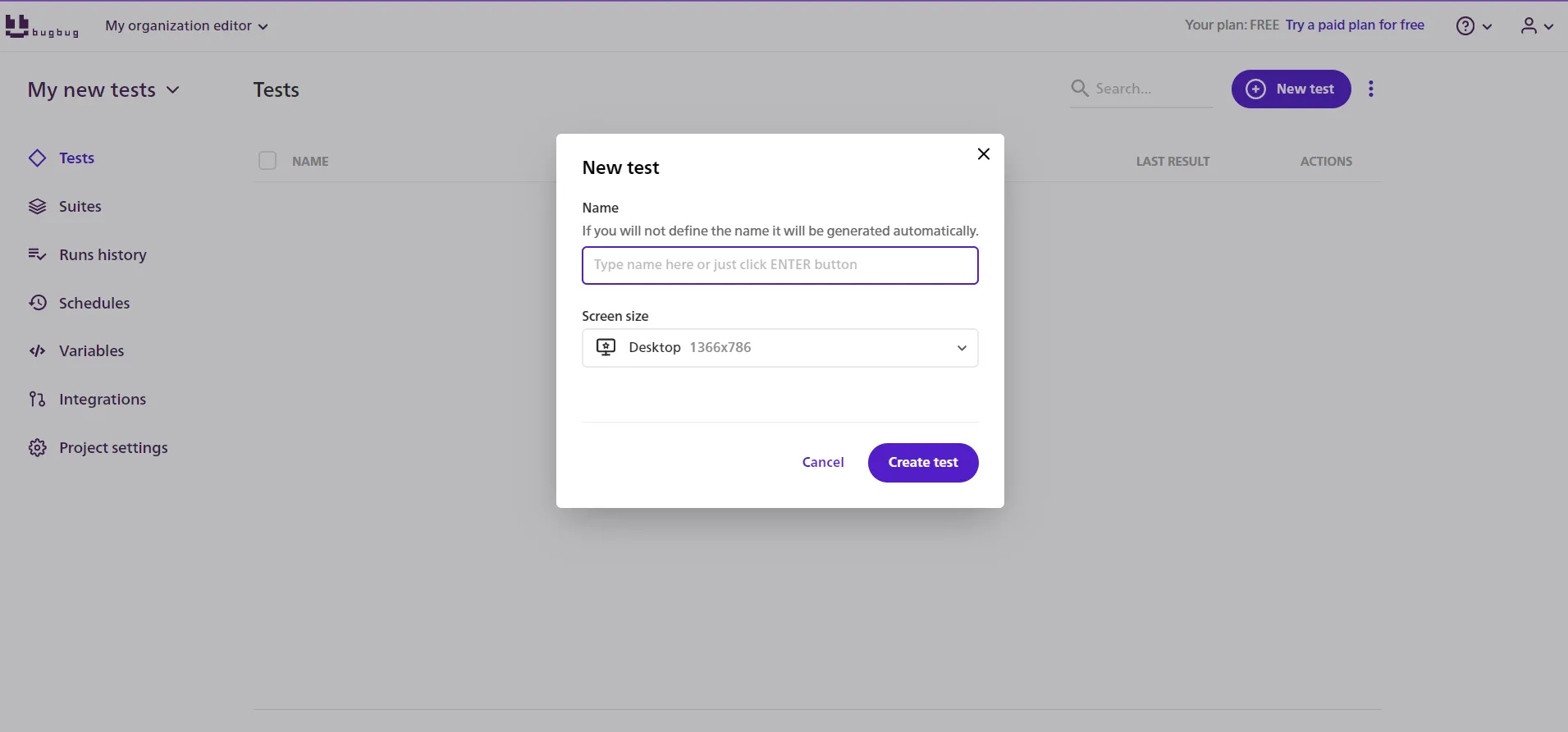
- Enter the URL of the web app or website that you want to test
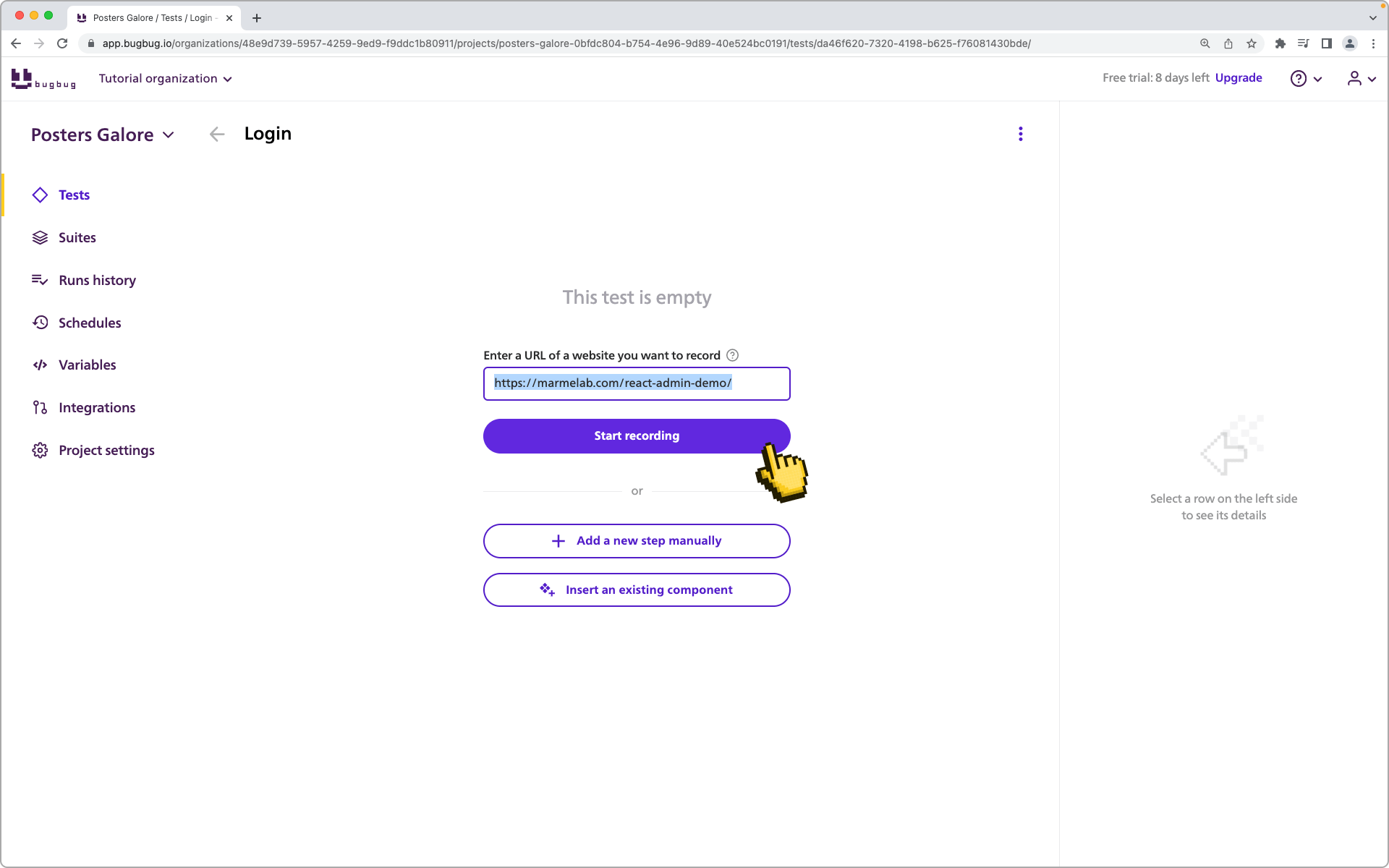
- Click "Start recording" - if you installed the extension, the incognito Chrome browser window should appear

Carefully click the elements to navigate - each click will be recorded automatically
When you are ready with the test case click the Finish and close button in the overlay menu on the right BugBug test recorder
Now run the test to see if everything was correctly recorded
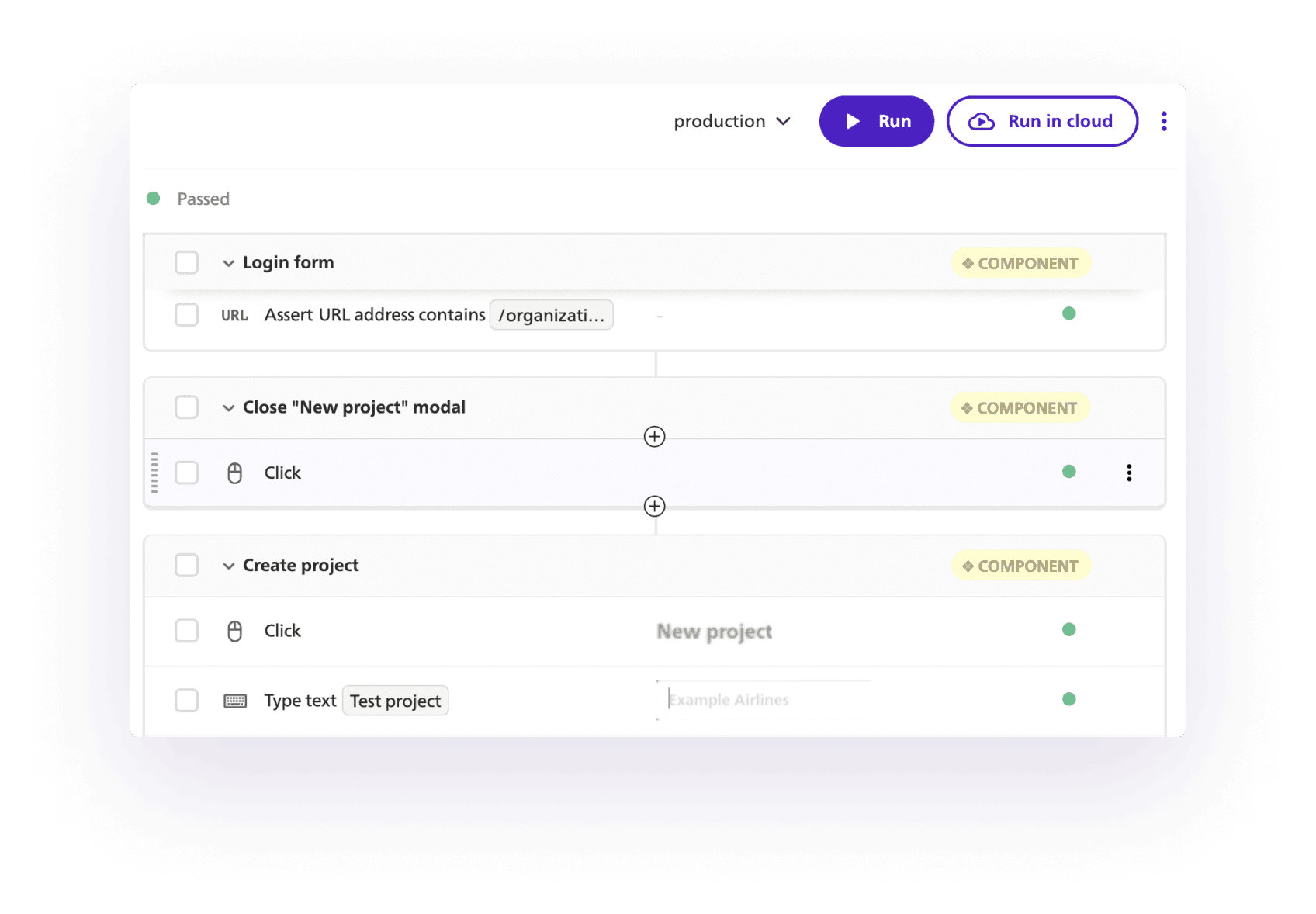
Creating end-to-end tests that faithfully replicate user journeys is an essential practice in software development. These tests go beyond mere functionality checks to simulate the complete paths users take through an application. By doing so, they ensure that all aspects of the user experience work harmoniously together and ensure customer loyalty.
Happy (automated) testing!
Speed up the entire testing process now

Software Developer
Application Consultant working as a Tech Writer https://www.linkedin.com/in/dominikdurejko/
Related articles

End-to-End Testing vs Integration Testing: Key differences
As a software evaluation process, testing provides development teams with methods to verify that their product performs as expected and does what it was designed to do. Although many consider testing as just another “formality” in software building, it is actually a critical stage that allows companies to ensure their customers will get a high-quality product.
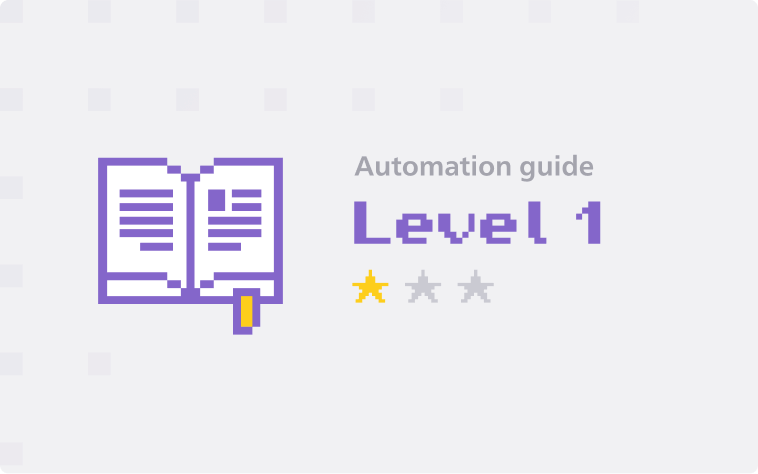
Automation Testing Guide for Startups - Level 1: Get The Most out of Basic Automation
The first episode of our guide with essential recommendations on test automation that we created specifically for startups.

What is Regression Testing? Testing Types, Tools
Discover regression testing in software development. Learn about techniques, tools, and best practices to ensure a smooth testing process.
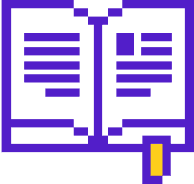
Check out our free Ultimate QA Cheatsheet
Heatmap & Analytics for Early Startups
Forever free, ai powered, a/b testing platform, user journey testing guide (2023).

User journey testing is the process of evaluating the complete experience of a user as they navigate through various stages of interaction with a product. It's not just about identifying usability issues; it's about uncovering the emotions, motivations, and pain points that users encounter along their journey
By analyzing these intricate details, businesses can create more engaging, intuitive, and satisfying experiences that resonate with their audience.
In this article, we will delve deeper into the concepts, components, tools, benefits, and best practices of user journey testing. Whether you're a UX designer, product manager, marketer, or simply interested in enhancing user engagement, this guide offers valuable insights and practical applications.
Understanding User Journey Testing
User journey testing is a multifaceted approach that goes beyond mere functionality to explore the entire experience a user has with a product or service. It's a vital aspect of modern UX design that offers unique insights into user behavior, preferences, and engagement.
Let's explore what user journey testing entails and how it differs from traditional usability testing.
What is User Journey Testing?
User journey testing is the process of evaluating and analyzing the complete path a user takes as they interact with a digital product. Unlike isolated usability tests, user journey testing considers the entire flow, from the initial interaction to the final outcome. It seeks to understand not just what users do but why they do it, uncovering underlying motivations, emotions, and challenges.
How Does It Differ from Traditional Usability Testing?
While traditional usability testing focuses on specific tasks or functions, user journey testing takes a broader view. Here's how they differ:
- Scope : Usability testing often targets particular features or tasks, while user journey testing examines the entire interaction process.
- Insights : Usability testing identifies functional issues, whereas user journey testing uncovers emotional and psychological aspects of user behavior.
- Goals : Usability testing aims to improve functionality, while user journey testing seeks to enhance overall satisfaction and engagement.
Why is User Journey Testing Important?
User journey testing is not just a trend; it's a fundamental shift in how businesses approach user experience. Here's why it's essential:
- Holistic Understanding : It provides a comprehensive view of how users interact with a product, revealing hidden pain points and opportunities.
- Personalized Experiences : By understanding user motivations and behaviors, businesses can create more personalized and resonant experiences.
- Strategic Decision Making : Insights from user journey testing guide product development, marketing strategies, and customer support, aligning with user needs and expectations.
- Competitive Advantage : In a crowded market, understanding the user journey can set a product apart, creating loyal customers and driving growth.
The Components of User Journey Testing
User journey testing is a complex process that requires careful planning, execution, and analysis. Understanding the key components and stages involved is essential for anyone looking to implement this approach effectively. Let's explore the essential elements of user journey testing, from planning to analyzing the results.
Key Stages of User Journey Testing
1. Planning :
- Define the objectives and scope of the testing.
- Identify target users and create user personas.
- Outline the key scenarios to be tested.
2. Designing :
- Develop test scripts and scenarios based on user personas.
- Choose the appropriate tools and methodologies.
- Prepare the testing environment.
3. Executing :
- Conduct the tests with real users or through simulated environments.
- Record user interactions, feedback, and observations.
4. Analyzing :
- Analyze the collected data to identify trends, pain points, and opportunities.
- Create actionable insights and recommendations.
Tools and Techniques for User Journey Testing
From visualizing user interactions through heatmaps to analyzing user feedback, the tools and methods used can significantly impact the effectiveness of user journey testing. Let's explore some popular tools and techniques that can enhance your user journey testing process.
1. Howuku :
- Features: Conversion funnel analysis, user feedback, A/B testing.
- Usability: Intuitive design with robust support and resources.
2. Hotjar :
- Features: Heatmaps, session replays, feedback polls.
- Usability: User-friendly interface suitable for marketers and designers.
3. Google Analytics :
- Features: Real-time tracking, audience segmentation, custom reporting.
- Usability: Suitable for beginners to advanced users.
Best Practices for Implementing User Journey Testing
User journey testing is a powerful tool, but its effectiveness depends on how it's implemented. Whether you're new to user journey testing or looking to refine your approach, adhering to best practices can ensure that your efforts yield meaningful insights and actionable results. Here's a guide to some of the best practices for implementing user journey testing.
Define Clear Objectives and Scope
- Understand Your Goals : What do you want to achieve with user journey testing? Whether it's improving conversion rates or enhancing user satisfaction, having clear objectives guides the entire process.
- Set the Scope : Determine the specific aspects of the user journey you want to test. Is it the entire flow or specific interactions? Defining the scope ensures focused and relevant testing.
Create Accurate User Personas and Scenarios
- Research Your Audience : Use surveys, interviews, and analytics to create accurate user personas that reflect your target audience's demographics, behaviors, and needs.
- Develop Realistic Scenarios : Create scenarios that mirror real-world interactions, ensuring that the tests are relevant and provide actionable insights.
Choose the Right Tools and Methods
- Select Appropriate Tools : Choose tools that align with your objectives and budget. Whether it's heatmaps, session recordings, or A/B testing, the right tools can enhance your analysis.
- Combine Qualitative and Quantitative Methods : Use a mix of qualitative and quantitative methods to gain a comprehensive understanding of user behavior and preferences.
Conduct Iterative Testing
- Start Early : Begin testing early in the development process to identify issues and opportunities before they become costly to fix.
- Iterate and Refine : User journey testing is not a one-time activity. Continuously test, analyze, and refine to keep up with evolving user needs and market trends.
Collaborate and Communicate
- Involve Stakeholders : Engage stakeholders from different departments, such as design, development, marketing, and support, to ensure a holistic approach.
- Communicate Findings Effectively : Present your findings in a clear and actionable manner, using visuals and narratives to make the insights accessible to all team members.
What is a user journey in testing?
A user journey in testing refers to the evaluation of the complete path a user takes while interacting with a digital product, focusing on their experience, behavior, and emotions.
What are the 5 stages of user journeys?
The 5 stages of user journeys typically include Awareness, Consideration, Decision, Retention, and Advocacy, representing the user's progression from initial discovery to loyal advocacy for a product or service.
How do you test customer journey?
Testing a customer journey involves defining objectives, creating user personas and scenarios, selecting appropriate tools, conducting tests, analyzing results, and iterating based on insights to enhance the overall user experience.
Supercharge your startup growth with Howuku

More from the blog
Digital Marketing
These metrics will help you improve customer satisfaction!

Black Friday, Cyber Monday (BFCM) is one of the largest and most popular shopping globally. Every year, shoppers scramble to buy all kinds of retail products at the lowest price all year.
Skip to main content
- Contact sales
- Get started Get started for free
Figma Design
Design and prototype in one place

Collaborate with a digital whiteboard

Translate designs into code

Figma Slides
Co-create presentations

Explore all Figma AI features
Get the desktop, mobile, and font installer apps
See the latest features and releases
- Design systems
- Prototyping
- Wireframing
- Online whiteboard
- Team meetings
- Strategic planning
- Brainstorming
- Diagramming
- Product development
- Web development
- Design handoff
- Engineering
- Product managers
Organizations
Config 2024
Register to attend in person or online — June 26–27

Creator fund
Build and sell what you love
User groups
Join a local Friends of Figma group
Learn best practices at virtual events
Customer stories
Read about leading product teams
Shortcut: The Figma blog
Stories about how products take shape—and shape our world

Get started
- Developer docs
- Best practices
- Reports & insights
- Resource library
- Help center
How to create an effective user journey map

No matter what you’re working on, the key to customer satisfaction and business growth is understanding your users. A user journey map helps you uncover pain points, explore the touchpoints from their perspective, and learn how to improve your product.
Imagine you just launched a new ecommerce platform. Shoppers fill their carts with products, but they abandon their carts before checkout. With a user journey map, you can pinpoint where the customer experience is going wrong, and how to enable more successful checkouts.
Read on to find out:
- What is a user journey map, and how it captures user flows and customer touchpoints
- Benefits of user journey mapping to refine UX design and reach business goals
- How to make user journey maps in five steps, using FigJam’s user journey map template
What is a user journey map?
Think about the path a user takes to explore your product or website. How would you design the best way to get there? User journey maps (or user experience maps) help team members and stakeholders align on user needs throughout the design process, starting with user research. As you trace users' steps through your user flows, notice: Where do users get lost, backtrack, or drop off?
User journey maps help you flag pain points and churn, so your team can see where the user experience may be confusing or frustrating for your audience. Then you can use your map to identify key customer touchpoints and find opportunities for optimization.
How to read a user journey map
Most user journey maps are flowcharts or grids showing the user experience from end to end. Consider this real-life journey map example of a freelancing app from Figma's design community. The journey starts with a buyer persona needing freelance services, and a freelancer looking for a gig. Ideally, the journey ends with service delivery and payment—but customer pain points could interrupt the flow.
Start your user journey map with FigJam
5 key user journey map phases.
Take a look at another Figma community user journey template , which uses a simple grid. Columns capture the five key stages of the user journey: awareness, consideration, decision, purchase, and retention (see below). Rows show customer experiences across these stages—their thoughts, feelings, and pain points. These experiences are rated as good, neutral, and bad.
To see how this works, consider a practical example. Suppose a new pet parent wants to learn how to train their puppy and discovers your dog-training app. Here's how you might map out the five key user journey stages:
- Awareness. The user sees a puppy-training video on social media with a link to your product website. They're intrigued—a positive experience.
- Consideration. The user visits your product website to preview your app. If they can't find a video preview easily, this could be a neutral or negative experience.
- Decision. The user clicks on a link to the app store and reads reviews of your app and compares it to others. They might think your app reviews are good, but your price is high—a negative or neutral experience.
- Purchase. The user buys your app and completes the onboarding process. If this process is smooth, it's a positive experience. If not, the customer experience could turn negative at this point.
- Retention. The user receives follow-up emails featuring premium puppy-training services or special offers. Depending on their perception of these emails, the experience can range from good (helpful support) to bad (too much spam).
2 types of user journey maps—and when to use them
User journey maps are helpful across the product design and development process, especially at two crucial moments: during product development and for UX troubleshooting. These scenarios call for different user journey maps: current-state and future-state.
Current-state user journey maps
A current-state user journey map shows existing customer interactions with your product. It gives you a snapshot of what's happening, and pinpoints how to enhance the user experience.
Take the puppy training app, for example. A current-state customer journey map might reveal that users are abandoning their shopping carts before making in-app purchases. Look at it from your customers' point of view: Maybe they aren't convinced their credit cards will be secure or the shipping address workflow takes too long. These pain points show where you might tweak functionality to boost user experience and build customer loyalty.
Future-state user journey maps
A future-state user journey map is like a vision board : it shows the ideal customer journey, supported by exceptional customer experiences. Sketch out your best guesses about user behavior on an ideal journey, then put them to the test with usability testing. Once you've identified your north star, you can explore new product or site features that will optimize user experience.
How to make a user journey map in 5 steps
To start user journey mapping, follow this step-by-step guide.
Step 1: Define user personas and goals.
Gather user research and data like demographics, psychographics, and shopping behavior to create detailed customer personas representing your target audience. In your dog-training app example, one key demographic may be parents. What’s their goal? It isn't necessarily "hire a puppy trainer"—it could be "teach kids how to interact with a puppy."
Step 2: Identify customer touch points.
Locate the points along the user journey where the user encounters or interacts with your product. In the dog training app example, touchpoints might include social media videos, app website, app store category search (e.g., pets), app reviews, app store checkout, in-app onboarding, and app customer support.
Step 3: Visualize journey phases.
Create a visual representation of user journey phases across key touchpoints with user flow diagrams , flowcharts , or storyboards .
Step 4: Capture user actions and responses.
For each journey stage, capture the user story: at this juncture, what are they doing, thinking, and feeling ? This could be simple, such as: "Potential customer feels frustrated when the product image takes too long to load."
Step 5: Validate and iterate.
Finally, show your map to real users. Get honest feedback about what works and what doesn’t with user testing , website metrics , or surveys . To use the dog-training app example, you might ask users: Are they interested in subscribing to premium how-to video content by a professional dog trainer? Apply user feedback to refine your map and ensure it reflects customer needs.
Jumpstart your user journey map with FigJam
Lead your team's user journey mapping effort with FigJam, the online collaborative whiteboard for brainstorming, designing, and idea-sharing. Choose a user journey map template from Figma's design community as your guide. With Figma's drag-and-drop design features, you can quickly produce your own professional, presentation-ready user journey map.
Pro tip: Use a service blueprint template to capture behind-the-scenes processes that support the user journey, bridging the gap between user experience and service delivery.
Ready to improve UX with user journey mapping?
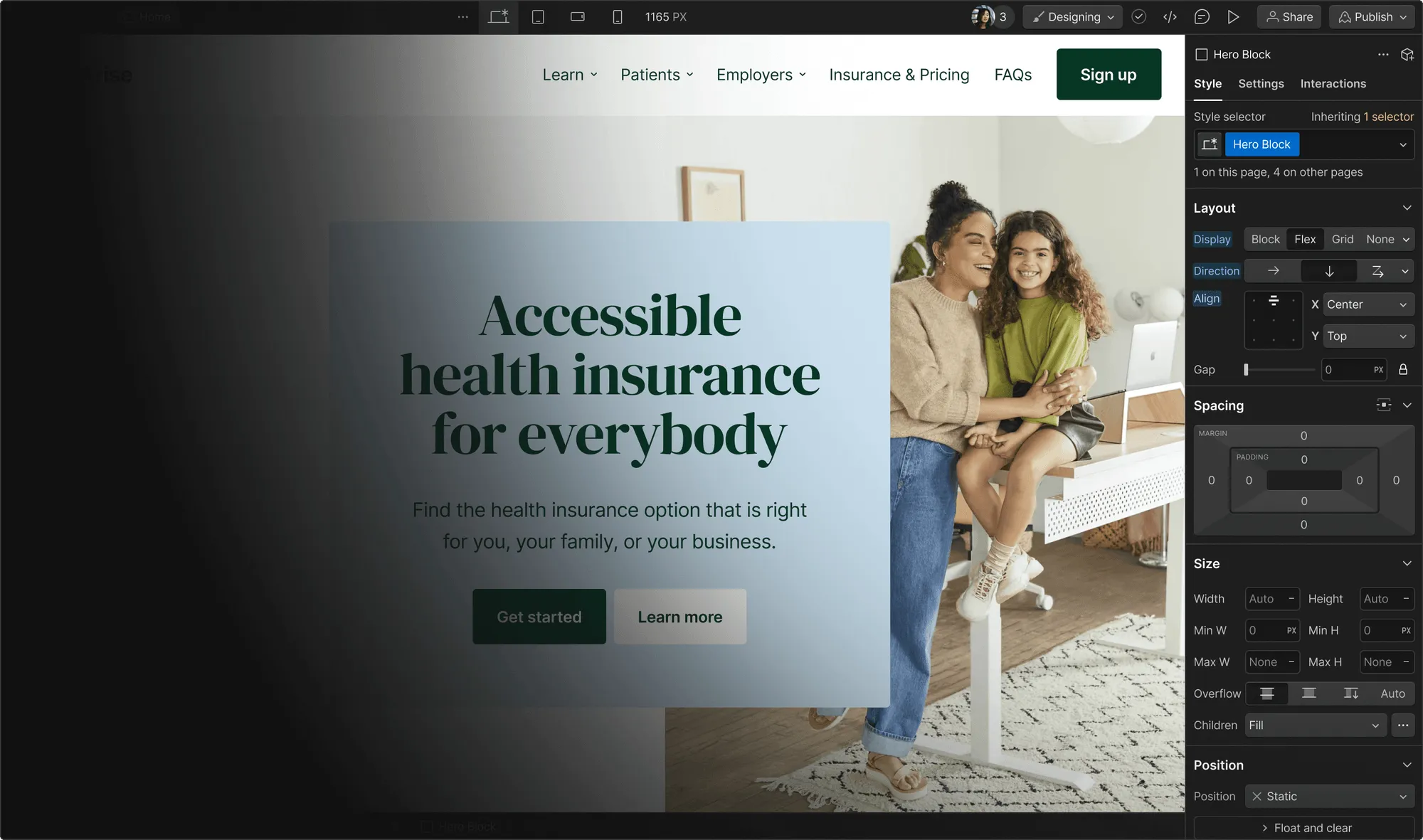
A comprehensive guide to effective customer journey mapping
A brand's user experience shapes its target audience's entire perception of your organization. Maximize audience engagement with customer journey mapping.

Discover key challenges today's marketing teams are facing, as well as opportunities for businesses in 2024.

Incorporating customer journey mapping into your web design process helps elevate consumer engagement to drive loyalty and sales.
Many in-house teams and web designers strive to better serve users by optimizing their customer experience (CX). Considering how your customers use your platform or service helps you see your website from a user perspective, letting you shape your design to better meet their needs. To achieve this, web designers can look to customer journey mapping.
A particularly handy tool for user experience (UX) design , this process helps teams understand who their users are and how to fulfill their expectations, guiding development decisions for improved audience engagement. Learn more about customer journey mapping and how you can implement it to enhance your CX.
User journey mapping: an overview
User journey mapping, also known as customer journey mapping (CJM), maps a website visitor's experience from their perspective. Presented through a visual diagram, the customer journey map charts the user’s path as they seek information or solutions, starting at the homepage and tracking their routes across other menus and links.
To create a customer journey map, you begin by researching who users are, what they want from your site, and how positive or negative their experiences have been.
There are two main purposes for mapping your customers’ journey.
1. Improve customer experience
This is the ultimate goal of CJM. Site navigation can be especially tricky to assess because you’re already familiar with the layout. A fresh perspective on your site often uncovers overlooked details such as navigation issues or broken links.
By conducting research on UX trends and visually mapping your results, you’ll identify any parts of your design that confuse or frustrate visitors. This process also reveals areas that work well, which you can repurpose elsewhere in the design.
2. Maintains ease-of-use as your site grows
A customer journey map can make even a simple site more straightforward to navigate. When your website or business grows, you may need to add content and features to accommodate the expansion. Implementing customer journey mapping ensures your website's fundamental flow remains intuitive and that new material and features are easily discoverable and usable.
Primary user journey map types
There are various ways to approach customer journey mapping based on the specific insights you’re seeking. The end result of each map will look similar, but the focus of each is different — which changes the information it offers. Here are three standard types of maps to get you started.
Current state
The current state map is the most common type. It evaluates your website’s present state to better understand visitors’ current experiences, helping identify improvement opportunities for its existing design.
Future state
A future state map explores a hypothetical "ideal" website, considering the visitor’s experience if every site component were optimized. This map is helpful when planning a total redesign or a specific change. When you collect user research and translate the results into your map, you can present a visual outline to your client or company for a straightforward explanation.
Persona-based
A persona-based map lays out the journey of a single designated type of user, or persona (which we will define below). This type of diagram is useful when optimizing your website for a specific sector of your audience with particular needs.

Learn best practices for integrating the workflows between design and development in this free webinar.
The 5-step customer journey mapping process
Once you’ve set clear goals for your map’s achievements, you can select the appropriate diagram type. To begin visualizing your user journey, follow this five-step process.
1. Define the map’s scope
Your map may focus on just one customer interaction or outcome, such as finding the newsletter sign-up sheet or making a payment, or it could cover the entire website’s navigation. A focused scope helps you troubleshoot a problem area or ensure an especially critical element functions properly. Alternatively, a larger-scope map provides a big-picture perspective of how the site works as a whole. Creating a comprehensive map is more complex, but high-level mapping helps comprehend the entire user experience from beginning to end.
2. Determine your user personas
A persona describes a particular type of visitor using your site. When imagining and defining these users, you can assign a name to each and include details about who they are, what they’re looking for, and why.
Focus on users who contribute most to your business goals, consulting your marketing or sales teams for insights. To define your customer personas, explore current user behavior through surveys, online reviews, and email list responsiveness.
For example, if you’re creating a website for a store that sells artisanal coffee-making tools, your personas could be:
- The gift giver. This user only knows a little about coffee but wants to select an impressive gift for someone else. They’ll need help with purchase decisions, so they might interact with an FAQ or chat feature before visiting the products page. They may also leave your site if overwhelmed by options, so it’s important to offer helpful information proactively. This will keep them engaged and more likely convert them to paying customers.
- The coffee nerd. This person is knowledgeable and always seeks the highest-quality tools, so easily accessible product details and customer reviews are important to them. To support their user experience and encourage them to purchase, ensure these elements are easily discoverable.
- The tourist. This user is on vacation and looking for a cute brick-and-mortar shop to visit. They aren't interested in your online store, but an appealing photo of your physical store with easily accessible hours and location information may convince them to come by in person.
These three types of users have very different needs and goals when visiting your website. To capture all of their business, create a map for each of them to ensure you accommodate their specific wants and circumstances.
3. Give the personas context
User context is the “when” and “how” of each persona visiting your site. A user will have a different experience loading your site on a mobile device than on a laptop. Additionally, someone in no rush may use your website differently than someone looking more urgently with a specific purpose.
Figure out when, how, and in what mindset your personas most commonly visit your site to map their experience accurately. This context has very concrete impacts on your finished design. If visitors tend to look for one specific page whenever in a hurry (like contact or location information), placing those details on the front page or prominently linking to it will smooth the user experience for those users.
Here’s an example of how to place a persona in context.
Persona: Jo is an apartment hunter in her early 20s and is still in college. She's looking for off-campus housing for herself and some roommates. The collective group values location and cost more than apartment features.
Context : Jo is in a hurry and trying to visit as many apartments as possible. She’s looking at property rental websites that clearly state apartment addresses in each listing.
Method : Jo is browsing the sites on her iPhone.
4. List persona touchpoints
Touchpoints mark when the user makes a purchase decision or interacts with your user interface (UI) . They include visitors' actions to move toward their goals and consider each associated emotion. The first touchpoint is how they reach your website — such as tapping a social media ad, clicking on a search result, or entering your URL directly.
First, list each action the visitor took and their corresponding emotional reactions. Subsequent touchpoints include instances when they navigate a menu, click a button, scroll through a gallery, or fill out a form. When you diagram the route through your site in an A-to-Z path, you can place yourself in the persona's mind to understand their reactions and choices.
A met expectation — for example, when clicking a "shop" button takes them to a product gallery — will result in a positive emotional reaction. An unmet expectation — when the “shop" link leads to an error page — will provoke an adverse reaction.
5. Map the customer journey
Illustrate the user journey by mapping these touchpoints on a visual timeline. This creates a narrative of users’ reactions across your entire service blueprint. To represent your users’ emotional states at each touchpoint, graph their correspondences like this:

The map helps you understand the customer experience as a whole.
For example, based on the diagram above, touchpoint 3 is the largest navigation challenge on the website. The graph also shows that the user's mood eventually rebounds after the initial setback. Improving the problem element in touchpoint 3 will have the biggest impact on elevating the overall user experience.
Customer journey mapping best practices
Now that you understand the mapping process, here are some best practices to implement when charting your customer journey.
- Set a clear objective for your map: Define your CX map’s primary goal, such as improving the purchase experience or increasing conversions for a specific product.
- Solicit customer feedback: Engage directly with customers through surveys or interviews so you can implement data-driven changes. Ask users about their journey pain points and invite both positive and negative feedback on the overall navigation.
- Specify customer journey maps for each persona: To specifically serve each customer persona, consider charting separate paths for each based on their behaviors and interests. This approach is more customer-centric, as not all user types interact with your website the same way.
- Reevaluate your map after company or website changes: As your business scales, your website must evolve — and so will your customer’s path. Review your map when making both large and small website adjustments to ensure you don’t introduce new user challenges. Navigational disruptions can frustrate visitors, causing would-be customers to leave your site and seek competitors .
Optimize your user journey map with Webflow
A user journey map is only as effective as the improvements it promotes. When redesigning your website based on insights your map provides, explore Webflow’s vast resource bank to streamline your design processes.
Webflow offers web design support with diverse guides , tutorials , and tools for straightforward web design. Visit Webflow today to learn how its site hosting , e-commerce , and collaboration resources support enhanced user experience for better engagement.
Webflow Enterprise gives your teams the power to build, ship, and manage sites collaboratively at scale.
Subscribe to Webflow Inspo
Get the best, coolest, and latest in design and no-code delivered to your inbox each week.
Related articles

Empathy mapping: Bridging the gap between design and user experience
Learn how the four quadrants of empathy mapping uncover your audience’s preferences and use them to create user-centric website experiences.

What is customer experience? An essential guide
Learn why customer experiences are essential for your bottom line, and discover practical strategies to implement across your digital channels.

Why is content mapping crucial for website building?
Websites revolve around content, so content mapping is essential. Learn how to build effective sites that deliver results for your brand.

How to create marketing personas that start with empathy
Treating customers with respect earns you loyalty. Dig into marketing personas that reflect real people to gain the most valuable insight.

How to implement and optimize effective customer-centric design
Implementing customer-centric design invites customers to collaborate with your brand and help shape truly unique products.

Bringing personality to your design work
As designers, how we tell our stories is key. We must be unique, genuine, and use language with purpose to get meaningful results in our design work.
Get started for free
Try Webflow for as long as you like with our free Starter plan. Purchase a paid Site plan to publish, host, and unlock additional features.
Transforming the design process at
- Interactions
- Localization
- DevLink Labs
- Figma to Webflow Labs
- Accessibility
- Global alliances
- Freelancers
- Customer stories
- Webinars and ebooks
- Libraries Beta
- Made in Webflow
- Livestreams
- Careers We're Hiring
- Webflow Shop
- Terms of Service
- Privacy policy
- Cookie policy
- Cookie preferences
- Accessibility statement
- Discover the community
- Partner with Webflow
- Certified partners
- Become a Template Designer
- Become an Affiliate
- Become a global leader
- Find a meetup near you
The Do’s and Don’ts of User Journey Mapping
Getting it right is the first step toward going places.
Last March, three weeks after Joseph Siwak was hired as an experience designer at the online hotel-booking company Rocket Travel, they sent him home — not with a pink slip, but with a new set of marching orders.
“I went from, literally, being in the middle of a normal traveler journey map to saying, ‘OK, what could the new normal be?’” Siwak said.
For Siwak, an illustrator whose user journey maps resemble artful graphic novels, the arrival of the pandemic meant, among other things, redrawing his vision of the modern traveler’s online experience. And he wasn’t the only one.
“We kind of suspected that people would want more localized safe spaces, like Airbnb and Vrbo, to hang out,” Autumn Schultz, director of experience design at Rocket Travel, said. “So we hypothesized around those ideas and what people might want to do in that space as well.”
User Journey Mapping Do’s
- Clarify your goals.
- Consider the scope.
- Gather a multidisciplinary team.
- Validate assumptions with analytics.
- Validate assumptions with interviews of loyal users.
- Start the journey prior to the customer’s discovery of your product.
- Differentiate new and existing customers.
- Match the fidelity of the map to its goals.
- Weave in real-life artifacts.
- Sync your in-app messaging with user journey flows.
These conversations led to a new journey map plotting users’ experiences on Rocketmiles, the company’s signature hotel booking app. Cartoon personas took on new expressions of anxiety. Once concerned over hotel prices, travelers were now frightened at the prospect of going, basically, anywhere. The map suggested where in-app messaging at key touchpoints could help address user concerns.
Turns out, user journey maps serve many functions. They help internal teams empathize with user needs. They clarify where and how features or engagements should surface in a digital product. They contextualize how a product or offering stacks up to a competitor’s.
“It’s a tool to generate ideas, to get people in a room and have real discussions, strategically, about what we want to address and when.”
Whether created on physical whiteboards or the digital boards of companies like Miro, Figma, Confluence or Lucidchart, journey maps offer a high-level view of a customer’s experience that sheds light on how they feel as they navigate the product.
“It’s a tool to generate ideas, to get people in a room and have real discussions, strategically, about what we want to address and when. Not every pain point is the worst pain point and not every opportunity is a happy path,” Siwak said.
Here, executives and product leaders reveal what to do — and what not to do — to make the exercise worthwhile.
More on UX Design What Is Information Architecture in UX?
Clarify Your Goals
“All good journey maps have a goal in mind,” said Keith Mancuso, a technical product manager at the digital agency Happy Cog. “You might want to increase utilization of discounts, increase average order value or increase page views.”
At Fueled, a New York-headquartered web and app development consultancy, journey mapping serves a two-fold purpose, Derek Burgess, the lead product manager, said. For existing clients like MGM Resorts International, Verizon and Warby Parker, journey mapping guides the development of new or existing products or services. For prospective clients, Fueled uses journey maps to plan and execute pitches.
“Any time a designer kicks off a project like this, it’s really important to describe why you’re doing it and what we should expect.”
“We do communications-strategy deliverables and growth-strategy deliverables. And with both of them, we use the user journey map to target areas that may be inefficient,” Burgess said.
Often, the goal is to rally support for a feature release among internal teams.
“Any time a designer kicks off a project like this, it’s really important to describe why you’re doing it and what we should expect,” Schultz said. “[Designers] all get really excited about doing these things, but if your partners — whether that’s your product people, engineers, CEO, operations or customer service people — don’t know why you’re doing it, it feels untethered.”
Consider the Scope
Matthew Hardesty is vice president of product at Brainbase, a platform that helps organizations like BuzzFeed and the Van Gogh Museum manage their intellectual property. He said his team generally spends no more than a week on a journey map. However, the time allotted reflects the breadth of the tasks being mapped.
A map might span the entire product lifecycle or a single engagement, such as the registration flow. The scope of the map should reflect the projected value of the product or proposed changes.
“You want to understand the tradeoffs, whether they are monetary or based on strategic reasons,” Hardesty said. “We know conversion rates are each worth X dollars. We think these improvements will increase the value by X amount and affect this many users.”
Gather a Multidisciplinary Team
Schultz recommends gathering a multi-disciplinary team early on to co-create the user journey map.
“So, not just design, but maybe it’s operations, maybe it’s customer service, maybe it’s a product person,” she said. “You could do this as a workshop, you can start mapping Post-Its from, say, the moment people start thinking about an experience to when they start looking for solutions to their problem or whatever they’re trying to achieve.”
Validate Assumptions With Analytics
Journey maps tend to be chock full of assumptions. One way to validate these is through behavioral analytics platforms like FullStory, Hotjar and Amplitude that offer reports, performance graphs and session replays to evaluate user engagement.
“With tools like FullStory, you can basically watch user sessions,” Hardesty said. “Press play and see exactly what they did. It’s not just analytics or a heat map, but how far they scrolled down a landing page, where they are in the viewport, what they’re looking at and whether they’re converting.”
Validate Assumptions Through Interviews With Loyal Users
Hard data helps validate assumptions, but qualitative interviews with longtime customers are often just as valuable.
“If they’re a repeat customer, and you’re trying to understand lifetime value, you can’t outsource that all that easily,” Schultz said. “One thing I think is super interesting is if you can get actual videos of your customers — if they’re willing to be recorded. Because tying an emotional hook to the experience is a lot more compelling for an engineer, or someone who is pretty far from the customer experience. It’s a way for them to understand, ‘This is why we’re doing it.’”
Conversations can happen informally, Siwak said, via a Zoom call with a customer who has opted in to provide input on a beta release, or a shared Slack channel where a peer from another company may be able to provide useful insights. Companies like dscout and UserTesting also offer remote user testing services.
Start the Journey Prior to the Customer’s Discovery of Your Product
A user journey map doesn’t have to start inside your product — it can start in the mind of a prospective user, Siwak said. Take the journey of a would-be traveler on Rocketmiles: “You’re sitting at work one day, and you’re just daydreaming of doing something different,” he said. “That’s a great jumping-off point for thinking about [the journey map].”
Envisioning the user’s journey holistically, beginning even prior to discovery, can lead to unexpected insights.
“People are discovering things [during the pandemic] maybe they wouldn’t have in a normal life and doing things differently — learning to ski all of a sudden,” Siwak added. “I have a friend who’s living near Yellowstone and trying to become an influencer with some buffalo.”
Differentiate Between New and Existing Customers
Within a journey map, design patterns often follow a typical chronology and tree logic. At registration, for instance, a visitor might be asked to sign up or continue as a guest. Assuming they sign up, a subsequent message asks for permission to send notifications. Later, they might be asked if they’d like to share their location.
But it’s important to differentiate the journeys of new and long-time users, Burgess told me.
In a mapping project for an insurance company offering supplemental employee benefits and discounts, Fueled plotted two distinct journeys — one for new employees enrolling shortly after being hired, and a second for established employees casually shopping online.
New employees received the promotions as an upgrade offer when they enrolled for standard benefits packages. For the second group, a pre-installed Chrome extension embedded in the insurance platform promoted discount codes at optimized intervals.
More on Journey Mapping Customer Journey Map: How to Really Get Inside a Customer’s Head
Match the Fidelity of the Map to Its Goals
The fidelity of a map should match its goals. Rocket Travel uses low-fidelity journey mapping to explore how potential Rocketmile customers use rival services such as Expedia, TripAdvisor — even Google — to plan for travel.
“I often will start with a lower-fidelity user journey with lots of assumptions on it,” Siwak said. “And just put a giant watermark that says, ‘These are all assumptions.’ And then, as we validate things, I’ll increase the fidelity — make it feel like we’ve talked to people about this, we know that it’s true.”
“I often will start with a lower-fidelity user journey with lots of assumptions on it, and just put a giant watermark that says, ‘These are all assumptions.’”
As a journey map becomes more refined, Siwak sharpens the imagery to create a dramatic narrative that accentuates pain points and happy moments along the user’s journey.
“I’ll try to make them almost like a comic,” he said. “Because I want people to be excited by the map and feel like it’s something they want to look at. The online [templates] are usually just so dry. If it’s all text, people will not want to read it.”
Weave in Real-Life Artifacts
Digital artifacts or “bread crumbs” — such as links to competitors’ sites, video or audio recordings of customer interviews, surveys and key research findings — are another way to create an emotional hook. Want to strengthen your case for adding a new feature? Try adding a snapshot of what’s possible.
For example: “We might include a picture of a Google spreadsheet of a user’s hotel options,” Schultz said. “It’s very true that customers create these to manage their reservations and share with their friends. Clearly, there’s a pain point in the travel experience that we’re not addressing and no one else has actually addressed, and that’s an opportunity. People have developed their own hacks. How do you lean into those hacks?”
Sync Your In-App Messaging With User Journey Flows
Platforms like Intercom, HubSpot and Braze now include custom journey builders designers can use to map the delivery of announcements, product tours, feature highlights and call-outs. These automated messaging services have become quite sophisticated in recent years, Burgess said.
“It’s almost like a CMS,” he explained. “You can use [the tools] to set up the structure for when a message triggers and how it triggers, and you can even set goals. It will report back to you the open rate and where people dropped off.”
User Journey Mapping Don'ts
- Don’t build journey maps from customer support tickets.
- Don’t limit your journey to the product funnel.
- Don’t over-index your map.
- Don’t forget your internal users and administrators.
- Don't wait to consult with other teams.
- Don’t create too many personas.
- Don’t ignore your non-users.
- Don’t do journey mapping in a vacuum.
- Don’t act on every customer suggestion.
Don’t Build Journey Maps From Customer Support Tickets
Joseph Ansanelli is CEO and co-founder of Gladly, a company that helps consumer brands like Crate & Barrel, Porsche and Ralph Lauren provide customer service through a multi-channel platform. He said journey maps that scope a customer’s experience across a single support ticket, rather than their entire history with a brand, miss the mark.
“We come at this from a standpoint of questioning how everyone else is doing journey mapping,” Ansanelli said. “The historical model is to create a journey based on a support ticket. That’s the wrong journey.”
“The historical model is to create a journey based on a support ticket. That’s the wrong journey.”
Instead, Ansanelli said interactions across channels — web browsers, in-app chat services, social media and live phone calls with customer-support agents — should be treated as a single journey.
“The right journey is when a customer contacts you, and you get them to the best person to help. It’s part of one lifelong conversation,” he said. “Otherwise, anytime a problem arises, you have to create another journey and another ticket, which requires two different support people to manage. That’s a broken system.”
Don’t Limit Your Journey to the Product Funnel
Conceptualizing the user journey as a funnel can make sense from a business standpoint, but that model has limitations.
“People don’t live in a funnel, they bounce around,” Schultz said. “Things are not constant. Journeys aren’t linear.”
Instead, journey maps should approach the product experience from a customer’s perspective. Stages in the journey such as discovery, onboarding, experimentation and habit-building should track the user’s evolving attitudes and reasoning.
“When you talk about funnels, it’s very hard to wear both hats,” Schultz said. “You’re looking at it from like a purely quantitative perspective — again, not wrong, just a different type of framework. Whereas journey mapping is meant to deepen your empathy and generate ideas.”
Don’t Over-Index Your Map
It’s easy to get bogged down in minutiae that mean little to customer satisfaction, much less the bottom line. Unless you’re a designer at a huge company like Amazon, where you might be called on to work toward infinitesimal improvements of a nano-feature, your focus should be on prioritizing what’s really important.
“What percent confidence are you adding by knowing a user scrolled 5 percent more on a page?” Hardesty asked. “Unless it’s your landing page, who cares? It’s not meaningful information.”
A better route, he told me, is to use a prioritization framework, such as the Kano model , to determine which features are most likely to resonate with customers. As he put it: “Do we think this will be a big winner? Is the juice worth the squeeze?”
Don’t Forget Internal Users and Administrators
Too many companies consider the journeys of their end-users, but not the internal teams supporting the software.
Recently, Happy Cog consulted on a web design and development refresh for Posse, a non-profit organization that awards scholarships to groups of first-generation college students. The site offers several touchpoints to guide students through the nomination and selection process.
However, the support that students receive from mentors once they attend college is equally important to the program’s success. Are they maintaining good grades? Are they attending organizational meetings? These factors needed to be better addressed in the design, Mancuso said.
“Posse, for the longest time, only focused on what student nominees see. But the internal audience has a journey as well, through more complicated content management systems that allow mentors to post news, update marketing features and check in on students,” he said.
Read this next The Job of the UX Designer Is About to Undergo Radical Change
Don’t Wait to Consult With Other Teams
Another way to torpedo a journey map is by waiting too long to invite key stakeholders.
“The more you wait, the more folks might feel surprised or question your findings,” Siwak said. “When people feel like they’re discovering it with you, there’s a lot less pushback. No one likes the surprise of hearing, ‘Hey, whatever part of the journey you’re responsible for sucks.’”
Beyond that, the journey mapping exercise can build solidarity for new product initiatives.
“I’ve never had anyone be like, ‘I think it was a waste of time,’” Siwak said. “And even if nothing scandalous is discovered in an ideation session, most people just enjoyed doing something different with their day.”
Don’t Create Too Many Personas
On the surface, separating personas by demographics — for instance, women in their 40s and men in their 20s — might seem like a good way to get an accurate view of your customer cohorts. But you can quickly lose the forest for the trees.
“Creating too many personas divides the audience too much,” Mancuso told me. “The journey becomes too complicated because there’s too much noise.”
Keep it simple: three to five personas.
Don’t Ignore Your Non-Users
What does this mean at a hotel-booking site like Rocketmiles?
“You have travelers who will never use the internet,” Siwak said. “Like the person on a road trip. You hit a rest stop in Tennessee, and there are those little pamphlets, and maybe you’re like, ‘You know what, I am going to go check out Dollywood today.’ Knowing that happens in the world might give us an opportunity, in the future, to capture a new market.”
Don’t Do Journey Mapping in a Vacuum
Talking to real customers to understand their attitudes toward your product, as well as those of competitors, is crucial to journey mapping. But companies often shortchange this part of the process.
“You get small companies that say, ‘We don’t have a lot of resources and money and time, and we’ve made this decision and we’re going to go with it.’ Or big companies that think they know everything about their customers,” Hardesty said.
Both views are distorted.
“Every time you come up with a feature idea, go back to the journey map, go back to your highest-grossing customers, your champions. At previous companies, I’ve helped establish customer advisor boards — a set of industry experts you can go to to gut check your assumptions.”
Don’t Act on Every Customer Suggestion
When several customers point to a particular bug or feature flaw, that’s a good signal that it’s time to revisit the journey map. However, while customers are good at seeing what’s broken, they’re less adept at positing solutions.
For example, if a customer requested a better way to search, sort and filter information: “You have to take these things with a grain of salt,” Hardesty said. “Maybe we create a different page, or reassign some of the content, and take care of 90 percent of what the individual user needs.”
Recent Design + UX Articles

4.7 STARS ON G2
Analyze your mobile app for free. No credit card required. 100k sessions.
18 MIN READ
SHARE THIS POST
Product best practices
- Product Management
- UX research
User Journey Map Guide with Examples & FREE Templates
18 April, 2024

Senior UX Researcher

Customer journey mapping is also a popular workshop task to align user understanding within teams. If backed up by user data and research, they can be a high-level inventory that helps discover strategic oversights, knowledge gaps, and future opportunities.
Yet, if you ask two different people, you will likely get at least three different opinions as to what a user journey looks like and whether it is worth the hassle. Read on if you want to understand whether a UX journey map is what you currently need and how to create one.
You can get the templates here:
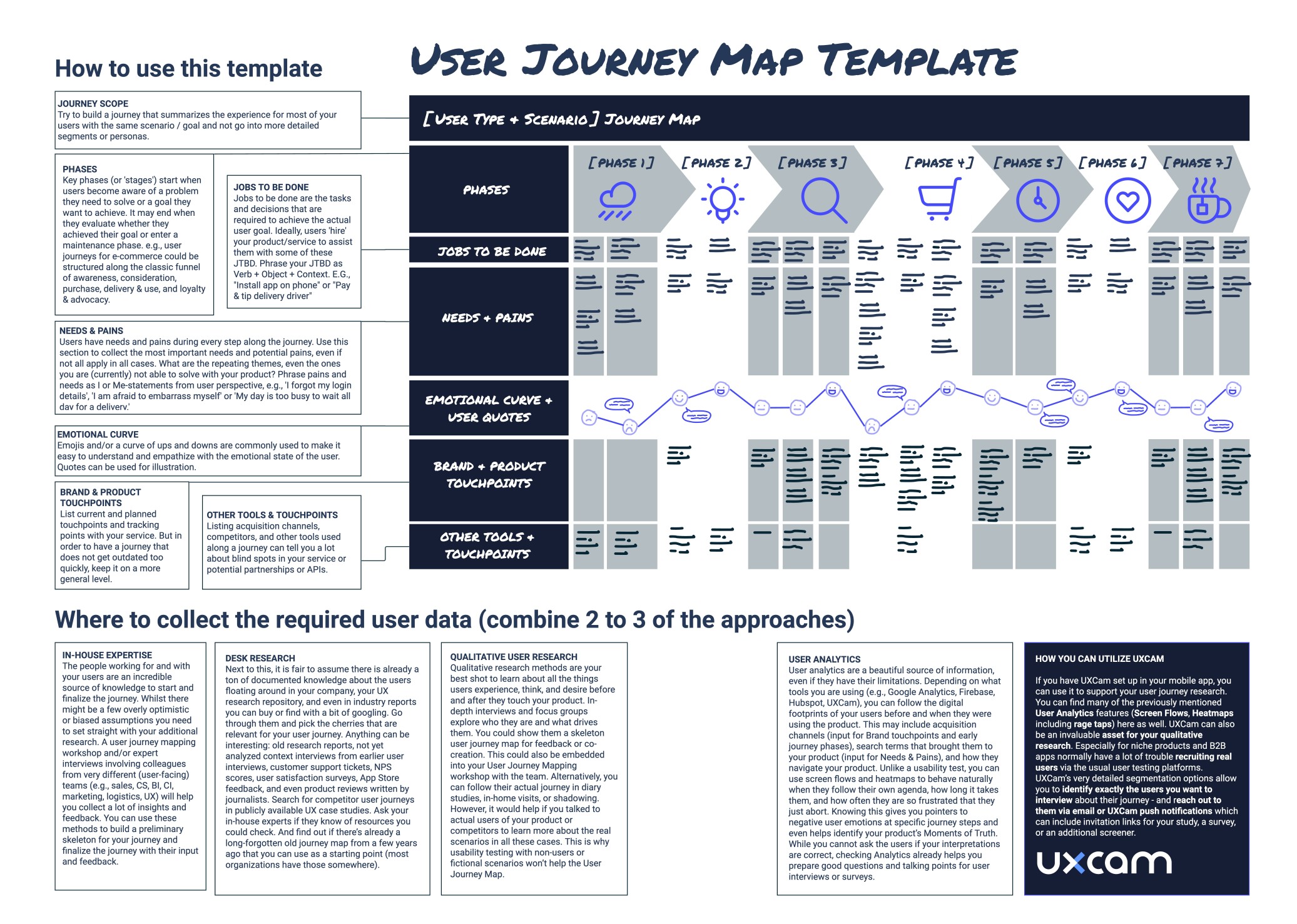
Click here to download a high-resolution PDF of this template.
What is user journey mapping?
Imagine your product is a supermarket and your user is the person wanting to refill their fridge. They need to:
Decide what to buy, and in what supermarket will they be able to find and afford it
Remember to bring their coupons
Park there
Find everything
Save the new coupons for the next shopping trip
Dive Deeper: Mobile Product Management Certification
If you want to learn more about how to optimize your user journeys, we recommend enrolling in our course "Mastering Mobile App Product Management" for free.
Unlock the secrets of user-centric design with our course
Gain practical skills in identifying user needs and crafting engaging, intuitive UX designs
Get 15+ templates and frameworks
Our modules, including "How to Map Out Your Discovery" and "User Research for Mobile Apps," ensure you create visually stunning and highly functional user experiences.
Enroll for free here.
Mobile App Product Management Certification
- Upskill for free
- Career growth
- Expert Instructors
- Practical Insights

3 ways to understand user journey maps
Now, there are at least three ways to look at the customer journey.
1. Workflow maps for usability optimization
Some imagine a user journey map as a wireframe or detailed analysis of specific flows in their app . This could be, for example, a sign-up flow or the flow for inviting others to a document. In our supermarket example, it’s a closer look at what they do inside your supermarket, maybe even only in the frozen section. Or you could define what you want them to do in the frozen aisle.
.css-61w915{margin-right:8px;margin-top:8px;max-height:30px;}@media screen and (min-width: 768px){.css-61w915{margin-right:38px;max-height:unset;}} The focus here is on getting the details of the execution right, not how it fits into the bigger picture of what the user needs.
It is more or less a wireframe from a user perspective. Such a product-focused understanding is not what we want to discuss in this article, though many examples for the best user journey maps you might come across are exactly this. There are good reasons to do such an analysis as well, since it helps you smooth out usability for the people who have already found their way into your supermarket because of your excellent ice cream selection. Workflow maps won’t help you notice that your lack of parking spots is one of the reasons why you are missing out on potential customers in the first place. By only looking at what they do inside the supermarket, you might also miss out on an opportunity for user retention: You could help them get their ice cream home before it melts.
2. Holistic user journey maps for strategic insights
With a more holistic view of what people experience when trying to achieve a goal, product makers gain strategic insights on how their product fits into the big picture and what could be in the future. Because this journey document covers so much ground, it is usually a linear simplification of what all the steps would look like if they were completed. Going back to our supermarket example, it would start from the moment the person starts planning to fill the fridge and ends when the fridge is full again — even if the supermarket building is only relevant in a few phases of this journey. Creating this version of a user journey map requires quite some time and research effort. But it can be an invaluable tool for product and business strategy. It is an inventory of user needs that can help you discover knowledge gaps and future opportunities. Service blueprints are the most comprehensive version of a user journey map since they also lay out the behind-the-scenes of a service, usually called backstage. In our supermarket example, that could be:
the advertising efforts
logistics required to keep all shelves stocked
protocols the staffers follow when communicating with customers
3. Journey mapping workshops as an alignment method
In a user journey mapping workshop, stakeholders and team members share their knowledge and assumptions about the users. Some of these assumptions might need to be challenged — which is part of the process. The goal is not the perfect output, but rather to get everyone into one room and work out a common understanding of the users they are building products for. It forces everyone to organize their thoughts, spell out what they know and assumed was common knowledge — and ideally meet real users as part of the workshop. If done right, this establishes a more comprehensive understanding of what users go through and helps overcome the very superficial ideas one might have about the lives and needs of people outside their own social bubble.
Hence, such a workshop helps create aha moments and gives the consequences of great and poor product decisions a face. So at the end of the day, it is one of many methods to evangelize user-centricity in an organization.
What are the benefits of user experience (UX) mapping?
We already discussed the benefits and shortcomings of workflow maps, but what are the reasons you should consider a UX journey map and/or a journey mapping workshop ?
1. Switching perspectives
Empathy: Like any other UX method and user research output, user journey maps are supposed to foster empathy and help product makers put themselves into the shoes of a user. Awareness: It creates awareness of why users do all the things they do. And it challenges product makers to resist the temptation of building something because it’s feasible, not because it’s needed that way.
2. Aligned understanding
Given the team is involved in creating the user experience map (either as a workshop, in expert interviews, observing the user research, or at least as a results presentation), it forces a conversation and offers a shared mental model and terminology — the foundation for a shared vision.
3. Seeing the big picture
Imagine the vastly different perceptions Sales reps, Customer Support teams, C-level, and backend engineers might have since they all meet very different segments at very different stages of their journey. Day-to-day, it makes sense to be an expert in the stages of a user journey you are responsible for. A journey map helps to step back from this and see the bigger picture, where your work fits in, and where assumptions about the majority of users were wrong. It might even help define KPIs across teams that don’t cancel each other out.
4. Uncovering blind spots and opportunities
A user journey map gives you a structured and comprehensive overview of which user needs are already tackled by your product and which ones are either underserved or solved with other tools and touchpoints. Which moments of truth do not get enough attention yet? These are the opportunities and blind spots you can work on in the future.
When is customer journey mapping just a waste of time?
In all honesty, there are also moments when creating a user journey map or running a journey mapping workshop is destined to fail and should better be put on hold. It’s a lot of work, so don’t let this energy go to waste. User journey maps only make sense when there is an intention to collaboratively work on and with them. Here are some of the scenarios and indicators that it’s the wrong moment for a journey map:
No buy-in for the workshop: The requirements of a successful journey workshop are not met, e.g., there is not enough time (60 minutes over lunch won’t do the trick), only a few team members are willing to attend, and/or key stakeholders refuse to have their assumptions challenged.
Isolated creation: The whole creation process of the user journey map happens isolated from the team, e.g., it is outsourced to an agency or an intern. Nobody from the team observes or runs the user research, or is consulted for input or feedback on the first drafts. There is no event or presentation planned that walks the team through the output. Finally, a very detailed, 10-foot-long poster appears in a hallway, and none of the team members ever find time to read, process, or discuss it with each other.
UX theater: For one reason or another, there is no time/resources allocated to user research or reviewing existing insights whilst creating the map (usability tests with non-users do not count in this case, though). Such an approach, also known as, can do more harm than good since the resulting user journey may only reinforce wrong assumptions and wishful thinking about your users.
Unclear objectives: The user journey map is only created because it is on your UX design checklist, but the purpose is unclear. If you are unsure what you or your stakeholders want to achieve with this journey map, clarify expectations and desired output before investing more energy into this. E.g., there is a chance you were only meant to do a usability review of a bumpy app workflow.
Lack of follow-through: Creating a user journey map is just the start. Without a plan to implement changes based on insights gathered, the map is merely a paper exercise. This lack of action can result from limited resources, lack of authority, or inertia. It's vital to establish a process for turning insights from the map into design improvements or strategy adjustments. This includes assigning tasks, setting deadlines, and defining success metrics to ensure the map drives real change and doesn't end up forgotten.
Overcomplication: Sometimes, to capture every nuance and detail of the user experience, teams can create an overly complex user journey map. This can make the map difficult to understand and use, particularly for team members who weren't involved in its creation. A good user journey map should balance detail and clarity, providing insightful and actionable information without overwhelming its users.
Failure to update: User expectations, behaviors, and the digital landscape constantly evolve. A user journey map that remains static will quickly become outdated. Regular reviews and updates are necessary to ensure that the map reflects the current state of user experiences. This requires a commitment to ongoing user research and a willingness to adjust your understanding of the user's path as new information becomes available.
The good news is: UX maturity in an organization can change rapidly, so even if you run into one of the obstacles above, it is worth revisiting the idea in the future. Once you’re good to go, you can get started with the user journey map examples and templates below.
User journey mapping: examples, templates & tools
There is more than one way to do it right and design a great user journey map. Every organization and industry has its own templates, tools and approaches to what elements are most important to them. The following examples and template will give you an idea of what a user journey map can look like if you decide to create one yourself. Make it your own, and change up the sections and design so they make sense for your product and use cases.
User journey map template and checklist
To give you a first orientation, you can use this user journey template and check the two fictional examples below to see how you could adapt it for two very different industries: instant meal delivery and healthcare.
Click here to download a high-resolution PDF of the user journey map template.
While there is no official standard, most other user journey maps contain the following elements or variations of them:
Key phases (or ‘stages’) start when users become aware of a problem they need to solve or a goal they want to achieve and may end when they evaluate whether they achieved their goal or enter a maintenance phase. E.g., user journeys for e-commerce could be structured along the classic funnel of:
Consideration
Delivery & use
Loyalty & advocacy
2. Jobs to be done
Whilst some other user journey templates might call this section ‘steps’ or ‘tasks’, it can be very beneficial to structure the stages into ‘jobs to be done’ (JTBD) instead. This framework helps you distinguish better between the actual goal of a user vs. the tasks required to get there . For example, safe online payments are never a goal of a user, this is just one of many jobs on the long way to get new sneakers on their feet. Ideally, users ‘hire’ your product/service to assist them with some of the JTBD on their journey. Phrase your JTBD as verb + object + context . Examples:
Install app on phone
Tip delivery driver
Buy new shoes
Naturally, the stages closest to your current (and future) solution require a more detailed understanding, so you might want to investigate and document deeper what JTBDs happen there.
3. Needs and pains
Users have needs and pains every step along the journey. Use this section to collect the most important needs and potential pains, even if not all apply in all cases. Ask:
What are the repeating themes, even the ones you are (currently) not able to solve with your product?
Phrase pains and needs as I- or me-statements from the user perspective, e.g., ‘I forgot my login details, ‘I am afraid to embarrass myself’ or ‘My day is too busy to wait for a delivery.’
Which are the pains and needs that are so severe that, if not solved, they can become real deal-breakers for your product or service?
On the last point, such deal-breaker and dealmaker situations, or ‘ moments of truth ’, require particular attention in your product decisions and could be visually highlighted in your journey. In a meal delivery, the taste and temperature of the food are such a moment of truth that can spoil the whole experience with your otherwise fantastic service.
4. Emotional curve
An emotional curve visualizes how happy or frustrated users are at certain stages of their journey. Emojis are commonly used to make it easy to understand and empathize with the emotional state of the user across the whole journey. It can be a surprising realization that users are not delighted with your witty microcopy, but you already did a great job by not annoying them. It is also a good reminder that what might personally excite you is perceived as stressful or overwhelming by most other users. Strong user quotes can be used for illustration.
5. Brand and product touchpoints
Here, you can list current and planned touchpoints with your brand and product, as well as. Whilst the touchpoints when using your product might be obvious, others early and late in the journey are probably less obvious to you but critical for the user experience and decision to use or return to your product. This is why it is worthwhile to include them in your map. Make sure your journey does not get outdated too soon, and don’t list one-off marketing campaigns or very detailed aspects of current workflows — just what you got in general so there is no major revision needed for a couple of years.
6. Opportunities for improvement
As you map out your user journey, it is important to not only identify the current touchpoints and experiences but also opportunities for improvement. This could include potential areas where users may become frustrated or confused, as well as areas where they may be delighted or pleasantly surprised.
By identifying these opportunities, you can prioritize making meaningful improvements to the user experience and ultimately creating a more positive, long-lasting relationship with your users.
7. Other tools and touchpoints
This may seem the least interesting aspect of your journey or a user interview, but it can tell you a lot about blind spots in your service or potential partnerships or APIs to extend your service. E.g., Google Maps or WhatsApp are common workaround tools for missing or poor in-app solutions.
User journey map example 1: health industry
The following example is for a fictional platform listing therapists for people in need of mental health support, helping them find, contact, schedule, and pay for therapy sessions. As you can see, the very long journey with recurring steps (repeated therapy sessions) is cut short to avoid repetition.
At the same time, it generalizes very individual mental health experiences into a tangible summary. While it is fair to assume that the key phases happen in this chronological order, JTBD, timing, and the number of sessions are kept open so that it works for different types of patients.
You can also see how the journey covers several phases when the platform is not in active use. Yet, these phases are milestones in the patient’s road to recovery. Looking at a journey like this, you could, for example, realize that a ‘graduation’ feature could be beneficial for your users, even if it means they will stop using your platform because they are feeling better.
This user journey map is fictional but oriented on Johanne Miller’s UX case study Designing a mental healthcare platform .

User journey map example 2: delivery services
What the example above does not cover is the role of the therapist on the platform — most likely they are a second user type that has very different needs for the way they use the platform. This is why the second example shows the two parallel journeys of two different user roles and how they interact with each other.
Nowadays, internal staff such as delivery drivers have dedicated apps and ideally have a designated UX team looking out for their needs, too. Creating a frictionless and respectful user experience for ‘internal users’ is just as critical for the success of a business as it is to please customers.

User journey map example: meal delivery. Please note that this fictional journey map is just an example for illustrative purposes and has not been backed up with user research.
For more inspiration, you can find collections with more real-life user journey examples and customer journey maps on UXeria , eleken.co & userinterviews.com , or check out free templates provided by the design tools listed below.
Free UX journey mapping tools with templates
No matter whether you’re a design buff or feel more comfortable in spreadsheets, there are many templates available for free(mium) tools you might be already using.
For example, there are good templates and tutorials available for Canva , Miro and even Google Sheets . If you are more comfortable with regular design software, you can use the templates available for Sketch or one of these two from the Figma (template 1 , template 2 ) community. There are also several dedicated journey map tools with free licenses or free trials, e.g., FlowMapp , Lucidchart and UXPressia , just to name a few.
Be aware that the first draft will require a lot of rearrangement and fiddling until you get to the final version. So it might help to pick where this feels easy for you.
How do I collect data for my app user journey?
User journey maps need to be rooted in reality and based on what users really need and do (not what we wish they did) to add value to the product and business strategy. Hence, user insights are an inevitable step in the creation process.
However, it’s a huge pile of information that needs to be puzzled together and usually, one source of information is not enough to cover the whole experience — every research method has its own blind spots. But if you combine at least two or three of the approaches below, you can create a solid app user journey .
1. In-house expertise
The people working for and with your users are an incredible source of knowledge to start and finalize the journey. Whilst there might be a few overly optimistic or biased assumptions you need to set straight with your additional research, a user journey mapping workshop and/or expert interviews involving colleagues from very different (user-facing) teams such as:
customer service
business intelligence
customer insights
will help you collect a lot of insights and feedback. You can use these methods to build a preliminary skeleton for your journey but also to finalize the journey with their input and feedback.
2. Desk research
Next to this, it is fair to assume there is already a ton of preexisting documented knowledge about the users simply floating around in your company. Your UX research repository and even industry reports you can buy or find with a bit of googling will help. Go through them and pick the cherries that are relevant for your user journey. Almost anything can be interesting:
Old research reports and not-yet-analyzed context interviews from earlier user interviews
NPS scores & user satisfaction surveys
App store feedback
Customer support tickets
Product reviews written by journalists
Competitor user journeys in publicly available UX case studies
Ask your in-house experts if they know of additional resources you could check. And find out if there’s already a long-forgotten old journey map from a few years ago that you can use as a starting point (most organizations have those somewhere).
3. Qualitative user research
Qualitative research methods are your best shot to learn about all the things users experience, think, and desire before and after they touch your product. In-depth interviews and focus groups explore who they are and what drives them. You could show them a skeleton user journey for feedback or co-creation .
This could also be embedded into your user journey mapping workshop with the team. Alternatively, you can follow their actual journey in diary studies , in-home visits or shadowing . However, in all these cases it is important that you talk to real users of your product or competitors to learn more about the real scenarios. This is why usability testing with non-users or fictional scenarios won’t help much for the user journey map.
4. Quantitative research
Once you know the rough cornerstones of your user journey map, surveys could be used to let users rate what needs and pains really matter to them. And what their mood is at certain phases of the journey. You can learn how they became aware of your product and ask them which of the motives you identified are common or exotic edge cases. Implementing micro-surveys such as NPS surveys , CES , and CSAT embedded into your product experience can give additional insights.
5. Customer satisfaction (CSAT) survey
Customer satisfaction surveys (or CSATs for short) are important tools that measure your customers' satisfaction with your product or service. It is usually measured through surveys or feedback forms, asking customers to rate their experience on a scale from 1 to 5. This metric can give valuable insights into the overall satisfaction of your customers and can help identify areas of improvement for your product.
CSAT surveys can be conducted at different customer journey stages, such as after purchase or using a specific feature. This allows you to gather feedback on different aspects of your product and make necessary changes to improve overall satisfaction.
The benefit of CSAT lies in understanding how satisfied customers are with your product and why. By including open-ended questions in the surveys, you can gather qualitative insights into what aspects of your product work well and what needs improvement.
5. User analytics
User analytics is a beautiful source of information, even if it has its limits. Depending on what tools you are using (e.g., Google Analytics, Firebase, Hubspot, UXCam), you can follow the digital footprints of your users before and when they were using the product. This may include acquisition channels (input for brand touchpoints and early journey phases), search terms that brought them to your product (input for needs and pains), and how they navigate your product.
Unlike a usability test, you can use screen flows and heatmaps to understand how your users behave naturally when they follow their own agenda at their own pace — and how often they are so frustrated that they just quit. Knowing this gives you pointers to negative user emotions at certain journey steps and even helps identify your product’s moments of truth. Whilst you cannot ask the users if your interpretations are correct, checking analytics already helps you prepare good questions and talking points for user interviews or surveys.
Curious to know how heatmaps will look in your app? Try UXCam for free — with 100,000 monthly sessions and unlimited features.
How can I utilize UXCam to collect App User Journey data?
If you have UXCam set up in your mobile app, you can use it to support your user journey research. You can find many of the previously mentioned user analytics features ( screen flows and heatmaps , including rage taps ) here as well.
UXCam can also be an invaluable asset for your qualitative research . Especially for niche products and B2B apps that normally have a lot of trouble recruiting real users via the usual user testing platforms.
UXCam’s detailed segmentation options allow you to identify exactly the users you want to interview about their journey — and reach out to them via either email or UXCam push notifications , which can include invitation links for your study, a survey or an additional screener.
Additionally, UXCam's session replay feature allows you to watch recordings of user sessions, providing valuable insights into how users interact with your app and where they may face challenges.
Where can I learn more about user journey map?
Don’t feel ready to get started? Here are a few additional resources that can help you dive deeper into user journey mapping and create the version that is best for your project.
Creating user journey maps & service blueprints:
Mapping Experiences by Jim Kalbach
Journey Mapping 101
How to create customer journey maps
Customer Journey Stages for Product Managers
The Perfect Customer Journey Map
Planning and running user journey mapping workshops:
Journey mapping workshop
Jobs to be done:
The Theory of Jobs To Be Done
Moments of truth in customer journeys:
Journey mapping MoTs
What is a user journey map?
A user journey map is a visual representation of the process that a user goes through to accomplish a goal with your product, service, or app.
What is a user journey?
A user journey refers to the series of steps a user takes to accomplish a specific goal within a product, service, or website. It represents the user's experience from their point of view as they interact with the product or service, starting from the initial contact or discovery, moving through various touchpoints, and leading to a final outcome or goal.
How do I use a user journey map in UX?
User journey maps are an essential tool in the UX design process, used to understand and address the user's needs and pain points.
Related Articles
Best behavioral analytics tools to optimize mobile app UX
20+ powerful UX statistics to impress stakeholders
Mobile UX design: The complete expert guide
5 Best User Journey Mapping Tools
App user journey: Mapping from download to daily use
Your guide to the mobile app customer journey
Customer journey optimization: 6 Practical steps
Alice Ruddigkeit
Get the latest from uxcam.
Stay up-to-date with UXCam's latest features, insights, and industry news for an exceptional user experience.
Related articles

User-Centered Design - Definition, Benefits & Methods
So you want to put your users first, but where do you start? There's a framework for it. Learn the basics of User Centered...

Marilyn Wilkinson

Push Notification UX Design: The Ultimate Guide 2024
Push notifications can lead to mass uninstalls — or a higher conversion...
Annemarie Bufe
Content Manager

Curated List
7 best ab testing tools for mobile apps.
Learn with examples how qualitative tools like funnel analysis, heat maps, and session replays complement quantitative...

Content Director
How to Test True End-to-End User Journeys
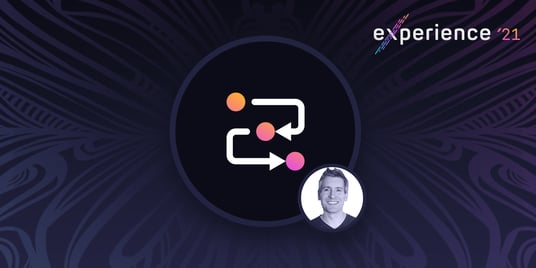
Get a Free Trial
Creating, executing, and maintaining reliable tests has never been easier.
End-to-end testing is an essential part of ensuring that your automated testing strategy matches the customer experience. If your end-to-end testing strategy doesn’t align with the full user journey, the more likely it is that a critical bug may sneak into production, potentially costing your company revenue as customers abandon incomplete purchases.
When it comes to the user experience, every interaction counts — even the parts that your user doesn’t consider, like APIs. In fact, research from PWC, Gartner, and G2 reveals that:
- 86% of purchasers are willing to pay more for a better experience.
- Over 80% of companies compete on customer experience alone.
- 51% of employees are unhappy at work because of the software they use.
Users expect rich, seamless experiences that work across browsers and devices, incorporating different API-reliant touchpoints that allow them to easily login, browse, and complete a transaction. But testing these new, multiplatform experiences can be difficult. Fully browser-based tests may be relatively easy to create, but they are slower and deliver less reliable results. Traditional end-to-end testing also often misses new customer touchpoints like email, API integrations, and mobile browsing. Furthermore, a divided approach to testing can lead to less collaboration between development and quality teams and lower overall test coverage.
Creating End-to-End Tests that Match Your Customer Journey
For true quality engineering, software testing teams need an end-to-end testing strategy that covers the full extent of the new customer journey, without slowing down production cycles.
Mabl Engineering Manager Jeff Zupka shared best practices for creating true end-to-end tests during his session at this year’s mabl Experience .
In his presentation, Jeff talked about how quality engineering teams can maximize their end-to-end testing in mabl, gave insights on how to set up your end-to-end testing strategy for success, and explained the importance of working as a team.
Establishing an Effective End-to-End Testing Strategy
Set up your tests for success: An effective automated testing strategy is both balanced and diverse, and your success depends on planning, preparation, and teamwork. To set up your end-to-end tests for success, isolate your changes using preview environments so that you can more easily run and test changes as you are working.
Additionally, ensure that you’re testing early in the development process. Rather than waiting until the UI is fully up and functioning, lead with API tests to be certain all of your integrations are working correctly and get your development and quality teams on the same page.
Test the UI that matters: Keep your tests focused by removing things that don’t need to be tested. Combine API and browser tests in the same plan, taking advantage of shared variables to develop modular tests that are laser-focused on the things that matter.
Make your tests repeatable: Ensure you’re starting each test with a clean slate — one way to do this is by regularly running “janitor” or “clean up” plans that remove data from the previous test run so it doesn’t cause UX issues.
Minimize risk with comprehensive coverage: It’s essential to have coverage across different environments and scenarios that your users will be encountering. Use mabl’s release coverage feature to gather insights on specific testing segments or entire suites of tests so that you can take appropriate action.
The release coverage dashboard helps your team identify any coverage gaps, pinpoints flaky tests that are currently passing but have frequently failed in the past, and highlights any performance issues that recent changes may have introduced into the application.
Work as a team in mabl : To ensure you’ll have a successful automated end-to-end testing strategy, you must work as a team in mabl — and that means making it easier for your current colleagues and new users to quickly grasp what a particular test is trying to do.
Take advantage of labels to more effectively organize your tests and deliver focused insights for different segments, and use echo steps and custom email prefixes to help keep things organized. When your team uses mabl intentionally, they embrace every opportunity to communicate the test’s purpose makes it easier to establish a culture of quality .
Provide Compelling User Experiences Across Touchpoints
End-to-end testing is a critical part of delivering experiences that build customer loyalty and contribute to overall business success. Set up your automated tests for success by embracing a diverse, balanced testing strategy. Focus on testing the UI that matters, and ensure you’re always testing on a clean slate to avoid inadvertently skewing your test results. Identify (and rectify) any coverage gaps or performance issues, and ensure you’re working as a team in mabl. By following these guidelines, your business will be able to consistently provide compelling user experiences across every touchpoint.
Discover true end-to-end testing with mabl’s 14 day free trial .
Discover What's New in Testing
Get all things testing, DevOps, and mabl in your inbox every Friday.
Quality Engineering Resources

Emulators and Simulators: The Secret Weapons of Mobile Testing Tools
If your mobile testing tools are a bunch of outdated phones, it's time to look into emulators and simulators for better test coverage & faster testing.

At the Forefront of AI Test Automation: Explore mabl's GenAI Innovations
AI testing struggles with generative AI? mabl's AI-powered assertions & script gen solve it. Validate complex behavior & empower anyone to write tests.

Generative AI Testing: Strategies to Ensure Quality and Mitigate Risks
Explore the challenges and solutions in generative AI testing for new features, ensuring quality and reliability in your AI-powered applications.
mabl, the leading AI-native test automation platform, empowers software teams to accelerate innovation while ensuring exceptional quality. Our unified platform streamlines testing across web, mobile, API, accessibility, and performance, enabling teams to release faster with confidence. Trusted by industry leaders like Microsoft, Charles Schwab, and JetBlue, mabl transforms how teams approach software quality.
- Mobile App testing
- API testing
- Performance testing
- AI auto-healing
- SaaS platform
- In-depth results
- Data-driven testing
- Cross-browser testing
- Integrations
- Increase Coverage
- Reduce Manual Testing
- End-to-end User Journeys
- Selenium Alternative
- Automated Regression Testing
- Test Automation for Salesforce
- For Developers
- For Executives
- mabl University
- mabl Documentation
- Request a Demo

Testing the user journey
Listen on these platforms
Brief summary
Great web development isn’t just about the front and backends: the experience the user has is critical to success. In this episode, our hosts Alexey Boas and Ashok Subramanian talk to Scott Davis and Zabil Cheriya Maliackal about the principles of user journey testing and the tools such as Gauge and Taiko that can help.
Podcast transcript
Hello and welcome to the Thoughtworks Technology podcast. My name is Alexey, I'm the head of technology for Thoughtworks Brazil and I will be one of your hosts this time together with Ashok who's head of technology for the UK. Hello, Ashok.
Hello, Alexey. Good to be on the call again. Look forward to discussing the topic of the day.
Oh, great. And well, we're delighted to have Scott Davis and Zabil with us today. Hello, Scott. Hello, Zabil.
Hello, hello. Thanks for having us this morning.
Hey, Alexey. Hey, Ashok.
And Scott, would you mind introducing yourself, telling us a little bit about your background?
Absolutely. I'm a principal engineer and a web architect here at Thoughtworks. I've spent a considerable amount of time doing web development, both on the backend and the front end, but this is a topic that is really especially near and dear to my heart, the user journey and capturing the user experience. I firmly believe that we can apply the same engineering rigor to front end technologies that we historically and traditionally have to the backend. So, as I said, I'm really excited to be talking about user journey testing with Taiko this morning.
Great. And how about you, Zabil?
So I'm a product manager and for the past five years I've been working with a few products. Two of the recent ones being Gauge and Taiko and I've been a developer for most part of my experience. I'm quite passionate about testing and building quality software products that I've been working on is around that.
Okay, thank you. And well, you did mention Gauge and Taiko, so those are two open source projects that were born inside of Thoughtworks. I know we're going to talk a little bit about them during our conversation, but would you mind telling us just a little bit what they are?
Yeah, sure. So both Gauge and Taiko are test automation tools and to keep it short, Gauge is a tool for writing acceptance tests and Taiko is a node-JS library for automating web browsers. So we can put both of them together and use them to test web applications.
Okay, wonderful. Looking forward to understanding better how that would work out. So Scott, you mentioned user journey testing, and I guess that's the main topic for today. So why don't you start there? What is user journey testing?
Oh, absolutely. So I think many people are probably familiar with this idea of user acceptance testing and language is powerful and it's important. We definitely want the users to accept the code that we're writing. As software engineers, we're not writing this for ourselves, we're writing this for our users. But I really like user journey testing, this phrase, because it captures perfectly what we're trying to accomplish here. A user journey is something like, "Hey, I have to log into this website, add three items to my shopping cart and checkout." That's my user journey right there in a nutshell.
And so what a browser automation tool like Taiko allows us to do is write that user journey, capture it in this really nice high level DSL, or domain specific language. And so if you go to a URL and you click on a login button and you write your username in a field, these are things that we can capture and automate in Taiko. And so this focus on the user journey through your application is very much focusing on the user experience, much like a developer might focus on the developer experience and write unit tests and integration tests to kind of experience the code journey through the application, a user journey test allows us to capture the user's journey through your website, as I said, in this really lovely high level DSL.
Okay, great. Thank you. So you mentioned unit testing and I would expect some listeners to be familiar with the concept of testing pyramids. Is it fair to say that user journey testing is a part of testing that will sit at the very top of the pyramid and connect and integrate with the other types of testing as a testing strategy?
So the testing pyramid is something that I'm sure many developers who've read up on unit testing at all have seen. The testing pyramid is very broad at the base and that represents unit tests and then as the pyramid gets narrower and narrower, we go through integration testing and finally at the peak is user acceptance testing. The visual metaphor of this testing pyramid is very powerful and it really does a great job of describing the developer experience. The developer's experience is unit testing. They want to make sure that their code is bug free and their APIs are friendly and things like that. So the testing pyramid does a wonderful job of visualizing the developer experience.
What I like thinking of is less of a pyramid and more of a spectrum, one that goes from the DX on one side, the developer experience, to the UX, the user experience, on the other. And by thinking of it as a spectrum, we want to make sure that we are well represented across that spectrum and user journey tests will feel familiar to developers if they're familiar with unit testing. But again, the focus is not on the developer experience and the soundness of code, the bug free nature of code, but it really is focused on the user experience and how they interact with the website rather than how a developer might interact with an API.
Okay. That's really interesting. So the mindset you would say that needs to be applied when you're thinking of tests in this shape or format towards, as you're describing the spectrum, towards the user experience side of the spectrum. Have you seen a difference in mindset that needs to be applied as you think about either writing unit tests versus writing user journey tests.
Yeah. That's a very interesting question and I'll try to answer that in terms of the tools and how we've designed Gauge and Taiko. So while the pyramid, like Scott mentioned, talks about developer experience, the existing automation tools are also heavily developer focused, where there is this kind of the concept of a gray box testing, where we need to know the structure of the application that we want to test. So for example, testing an HTML page means knowing what XPath I need to use to click on a specific element or exactly how that element was built in code. And we came to this point because we were looking at testing from a developer perspective. So flipping that and saying that, okay, we need to take a look at the user journey testing perspective will also influence the design of the tools and how they are used according to the user. So that's the difference. So how we code and write those tests are totally different.
Do you almost have, like try to address who the intended user audience of the test-
Focus it from their perspective and then use that to drive the design of the tools that you have spoken about.
Exactly. So it's a very clear separation. So it's not very associated with the test pyramid, but, like Scott mentioned, it's like a spectrum. It's a very different universe altogether.
I think another interesting angle on this. Part of the reason why the test pyramid came to a pointy tip around user journey testing or user acceptance testing is that historically these tools have been amazing in what they were able to accomplish, but they did tend to be fragile, they did tend to be brittle. Many of them were written in a time when we didn't have evergreen browsers that were constantly upgrading. So if you have a third party tool that's trying to wrap a browser that doesn't update out from under you, you can have some stability. But in this era of evergreen browsers that are constantly upgrading, having third party tools try to wrap and encapsulate them did lead to brutal tests and that was frustrating. That frustrated me as a web architect, having these tests that fail, not because our code has changed, but because the underlying assumptions like the browser has changed. That was one of the top considerations when Taiko was being written, was to address this fragility.
And they accomplished it in kind of a very simple, obvious way. If the browser is ever changing, well then not ship Taiko with the browser that doesn't change. So in fact, Taiko ships with Chromium, which is the core of not only the Google Chrome web browser, but also the core of the Opera browser and now even Microsoft Edge. So when you NPM install Taiko, what you end up with is a known good browser that works with Taiko that represents well over two thirds of the market. Now we can point Taiko at other browsers as well, but having this known good stable browser that ships with Taiko really helps address one of the primary reasons why user acceptance testing was kind of worried about and kind of put off to the last, because why put a lot of effort into tests that are going to break for reasons beyond your control?
So even just the nature of the tools we use as developers can change our relationship with these tests. Taiko and Gauge are quite fast and quite stable. And the high level DSL makes it very easy to represent the user journey. So when you put all of these things together, it should make user journey testing appealing to the developer as well.
Yeah, I was going to ask, so it's interesting because you talk about how the technology has evolved and has enabled brand new things for us to do. On one hand it does sound like the promise of behavior-driven development coming true, because now technology enables that. Is that true to an extent? Because the concepts, they seem to be related. So BDD was trying to approach testing and the interaction with the system from a user's perspective, using the language of the user and things like that. So now it looks like the technology has enabled us to take this to the next level and remove some of the brittleness and the flakiness of the tests and et cetera. Is that what's happening here?
Maybe, maybe not. So the thing about BDD is, and this is from the people who created BDD and the blogs they have written, they always make it a point to say that it's not about testing. So BDD is about capturing business behavior, the requirements, and managing the requirements and communication within the team. And they consider BDD to be a communication tool, not a testing tool. But Gauge and Taiko take a different perspective. It, again, puts the user into the forefront. And it is focused on testing. And it so happened that specifications are written using markdown because It's plain English (or any spoken language), it's much easier to write tests that way. So although there is no relation to the BDD process, there is, let's say, a kind of an evolution of parts of BDD, but heavily focused on testing.
Yeah, I think that idea of evolution is really important to focus on in these kinds of conversations. Thoughtworks has a long history in this space. BDD was kind of coined and popularized by a Thoughtworker named Dan North back in 2003. And so over the course of almost two decades now we've seen this idea expand and involve, as you would hope, but knowing that applications like JBehave and later RBehave, JBehave was implemented in Java, Rbehave implemented in Ruby, and then RSpec. and then Cucumber and Gherkin. All of these are open source projects that came out of Thoughtworks and came out of the result of Thoughtworkers working on projects with clients and wanting to have tools that better represented what they were trying to test. Similarly, Jason Huggins was a Thoughtworker who developed a tool named Selenium back in 2004. And Selenium evolved to include WebDriver, written by another Thoughtworker, Simon Stewart.
And so all of these represent 20 years, almost nearly 20 years of industry experience trying to run and evoke tests that take the user's perspective into mind. So even though I affectionately say Gauge and Taiko are BDD Selenium plus plus, I mean that affectionately. Because they aren't an extension of those. What I mean is they're an extension of our experience as an organization trying to write user focused tests. And so when Selenium was faced with the flakiness of evergreen browsers, no blame on Selenium at all, just the nature as the technology evolves, Taiko has evolved to address that. And as Zabil mentioned, Cucumber is great, but it is almost like writing haiku. There's a very formalized structure of this "given when, then" kind of mentality. And while I love the intellectual rigor of "given when, then," no users think that way.
Maybe business analysts do, right? Maybe product owners do, but no user is going to say, "Given I have a credit card in my hand and I need groceries in my house, when I drive to the ..." That just doesn't happen that way. And so what Gauge has managed to tap into is this use of markdown, plain English, being able to express the tests in the language of the user. And then Taiko as a browser automation DSL being able to represent the actions of the user. These two technologies, even though they can be used separately, when you use them together, expressing the tests and the language of the user and then being able to automate and represent the actions of the user, make a really compelling combination of two different technologies that work incredibly well together.
I know you were mentioning the reference through Gauge and Taiko a little bit. You mentioned in Gauge you use the tool to express the user journey in an easy to understand language. You also made a reference that Taiko's actually something that could be run by itself, or it can be adopted separately. What's the relationship and the value that we see, if someone's actually going to adopt these, to start thinking about this mindset of moving towards user journey testing? Is there a bump? Do you think about using one over the other to start with? Or do you say you use both together? What's your vote or recommendation for people thinking about adopting or moving down the path of user journey testing?
So one of the powers of Gauge is that we're expressing these tests in the language of the user, again, in markdown, in plain English. But Gauge is not opinionated as to how you actually execute these tests. Gauge has first-class support for Java as a back end, or Ruby, or C-sharp, or Python, or in fact JavaScript in the form of Taiko. So the power of Gauge is that we can capture these user journey tests in plain English, in markdown, and implement them in the language of your choice. Now, Taiko is very tightly tied to JavaScript. It actually is a Node.js project and it uses the Chrome dev tools protocol, the CDP, the same low-level protocol that the actual Chrome dev tools use in Lighthouse and things like that. So whereas Gauge is more focused on capturing the language of the user and implementing it in the programming language of your choice, Taiko is very firmly rooted in modern JavaScript idioms.
Every action in Taiko is asynchronous. And so these are async functions and you await, await, await each one of these Taiko actions. So another real anti-pattern I see in a lot of these user acceptance user journey testings is, go to URL and sleep for three seconds. And type in a username and password and sleep for another five seconds. And this was a very synchronous, maybe old school first attempt at solving these kinds of problems. But now that we have modern JavaScript that embraces this asynchronous await paradigm, the fact that Taiko embraces this and you do each action and each action takes exactly as long as it needs to take and no longer.
And of course we have timeouts and other things to deal with these kinds of things, but as a web developer and a web architect, being able to express this in JavaScript feels very natural to me. That's the natural language that I think a lot of developers are going to gravitate to. So it makes a lot of sense that Taiko was implemented in JavaScript. Also, arguably the most popular programming language on the planet as well, 10 million JavaScript programmers can't be wrong, right?
Yes. And the way to think about how they are different and independent is, Taiko is focused on driving the browser, but testing involves other stuff, like having a runner that will run on your scripts that will report what passed and what failed. So that's where Gauge comes in. Gauge is, after writing the specifications in a specific language, it can run those specifications. Now, Taiko can be used with other runners, like Jest or Mocha. But then the thing that we would miss out here is the topic of this podcast, which is the user journey testing part of it.
Absolutely. And I think that's a really important thing to amplify as that thinking of Taiko as a testing library is one particular use case, but not the only use case, it is truly a browser automation tool. So if you need to automate visiting a website, downloading a bunch of images, any of these kinds of things that you might want to do, you can certainly express that in Taiko. But some of the testing aspects of Taiko, being able to intercept network calls, that just lends itself so perfectly to testing. And here's a great example of that. Let's say that you've got your website out there and you've got Google Analytics wired up, and you want to run a series of user journey tests against your production website, but you don't want your Google analytics kind of gummed up with these kinds of testing artifacts.
So Taiko gives you the ability to intercept literally any HTTP call that you make. And in the case of Google Analytics, since this is run client side, you might want to intercept that call to the Google Analytics and just kind of dove null it. Just kind of push it aside and not doing anything interesting with it. But if intercept did only that I'd still be interested, it'd be worth the price of admission, but wait, there's more, you could also intercept and supply your own particular payload. So this all of a sudden becomes a very powerful mocking and stubbing tool as well. And then it's got even kind of the best of both worlds, where it can intercept that request, grab the payload that came from the actual website and just tweak it and in a very simple way, tweak that payload and then pay it on.
So again, in terms of browser automation, there are broad, broad uses, but boy, the use cases for testing and mocking and stubbing make it an especially compelling tool. But when we say it's a testing tool, Taiko doesn't come with its own assertion libraries at all. So it really is meant to be incorporated with your testing library of choice. It really is meant to be incorporated with Jest or with Mocha or with any of these other kinds of libraries. It's meant to automate the browser in a testing scenario, not just test the browser in and of itself.
Well, that's certainly impressive, the capability of intercepting. So that goes back to what we were talking about, the flakiness and fragility of these user journey testing, and then I have seen situations in which I know small changes to the application would break a large number of tests and then require a lot of work. So could you give me one example of how Taiko provides the sort of resilience to the tests? I don't know, one thing that comes to mind is I have lately had lots of problems using selectors to find elements in a page and that changes all the time. So for example, how does the title DSL deal with those things and provide resilience to the test?
So like you mentioned selectors, that's a big thing. And some history around how Taiko came about is while we were building Gauge, we were trying to solve problems that users face when they were testing and flaky tests were the biggest problem that people noted. And there were two top reasons why tests fail. One was changing selectors, and I'll talk more about changing selectors. And the other one was wait times, people not knowing what time to wait for a particular element to appear on the page, or when people click something, there's an Ajax call and then something happens. These are the two biggest problems that were there. Now, when we looked at selectors, changing selectors was the biggest problem. And that is because the current tools use XPath selectors, which needs to know about the structure of the page.
And that's where we figured out that a change in functionality does not mean a change in the structure of the page. A button can remain a button with two different code styles. But that doesn't mean that the functionalities change which means your tests shouldn't fail either. So that can only happen if we actually go back to the roots of testing, treating the browser as a black box and not knowing how that box is built and the tests being written that way.
So Taiko Selectors does not use XPath. It has an option for using XPath in some extreme cases, but the selectors over there are something we call Smart Selectors, which depends on the visual elements of the page. For example, if there's a button over there with a label add to shopping cart, you can just say click add to shopping cart without even saying that it's a button, it's just going to click something on the screen with add to shopping cart. And that holds true for other elements. So that in itself removes a lot of flakiness, because most of the projects when tests are plugged in earlier on in the development cycle, the application constantly evolves and things change, the pay structure changes.
Now, developers need not worry about that to go back and update the tests because of some page change. The other thing that we have is something called Proximity Selectors, where we can say, click a button near a specific text, and Taiko can automatically figure that out. So with this approach, treating the browser like a black box and having APIs to do that, it solves the first problem around selectors. And that is, let's say a major part of flakiness.
The other problem it solves is because Taiko uses or interacts directly with the browser or uses Chrome dev tools protocol, it knows how a browser page loads or how elements are loading in the browser page. So it just automatically, or intelligently figures out that the page is loading and elements are not loaded yet. Let's wait for the page to finish loading before clicking something. So that eliminates a lot of waits in the code, because I think already how people use waits is based on guesswork and you can never predict how much to wait for the page. And then the test ends up all becoming about tweaking the wait times, increasing your testing, and a lot of flakiness around this thing. So again, Taiko eliminates that by intelligently waiting.
Plus you have to be pessimistic, right? And that makes your test take much, much longer to run.
Every page will take 20 seconds to load.
I do remember this where the natural instinct, once you start seeing the sort of behavior of a test failure that isn't necessarily indicative of change in anything like the journey. It starts promoting this thing that can just read on the best part and slowly, over time, you start losing confidence in anything . That could be seen as being very powerful for the future.
Yeah, exactly. I think long before, when we were building our products out, a colleague of mine actually came up with the term, I think it's very popular, “there's no such thing as flaky tests”. There are tests that break and we just ignore them and call them flaky. But those are actually unreliable tests.
Well, and I think it goes back to something I said earlier about how we can apply the same engineering rigor to the front end that we have historically applied to backend development. When Zabil is talking about this selector logic, not only does it capture the user experience, the user is going to say, "I want to click on the search field." Not, "I want to click on the ID of this or this deeply nested kind of XPath selector logic." So not only does Taiko allow us to kind of get in the mind of the user that says, "Click on the search field, write this in it, click submit." These kinds of user experience kind of things.
It also allows us to address something that came out of very sound engineering principles, but simply aren't needed anymore. And that's the page object. The page object was a great pattern at the time. If you were doing your writing in say Java, and this webpage that's written by someone else is constantly changing, they're changing CSS classes, they're changing IDs, they're changing all these things and inadvertently breaking your tests, well, what you did is you wrote your own adapter pattern. You wrote your own page object and you said, "I'm going to program to the page object. I'm going to say, 'click the select field, write this in, click the submit button'," and then it gets wired up to whatever the code is behind the scenes. That was almost a firewall, a protection between you, the non-fronted developer and this kind of scary, unknown front end that seems to be changing in arbitrary and capricious ways.
The selectors just completely deprecates the need for a page object altogether. It's actually kind of an anti-pattern now. When you're using these tools, we want to select. And so if I say, "click search" and there's something obviously on the page that's labeled search, well, it's just going to be clicked. But if you need more, there are these really wonderful fuzzy selectors like near. You could say, "Click search near the search button," or, "Click purchase near the invoice," or these kinds of things. And you can do above and below and to the left of, and to the right of, and so it really is about kind of more naturally interacting with the Dom and the way you'd be expecting rather than adding yet another layer of indirection.
But another thing that I want to come back to once again, these sound engineering principles. When we come to unit tests, these unit tests are meant to be run in isolation. We want to isolate ourselves from file systems. We want to isolate ourselves from database calls and network calls and things like that, again, to add stability to these unit tests. Much of the flakiness that we've talked about, isn't a flakiness in the test. It's a flakiness on the network connection or the database connection or the file system not being in the state it needs to be in or anything else.
What Taiko allows us to do is remove a lot of those sources of flakiness, a lot of those sources of instability. In Taiko, you can set your GPS location so you don't have to physically be in Bangalore in order to test this app as if you were in India. You can set that location and then run your Taiko tests. You can set cookies so you can be in a logged in state, or you can be in whatever state you need to be in. You can emulate individual devices, you can emulate an iPhone or a Galaxy, or these kinds of things. You can emulate networks to emulate a slow 2G network or a fast 4G network or things like that.
By applying the same engineering rigor that we've historically applied to the backend, to the fronted, we can do these same kinds of things. We can put Taiko in a known good state every time. Known good state in that it ships with a known good browser, but also a known good state in terms of location and screen geometry and network conditions and through the intercept we talked about. We could completely isolate our tests and only be dealing with mock stubbed responses. And that feels like unit testing to me, but this is frontend user journey testing, but I'm using all the same skills that I have as a backend developer to test my frontend.
Well, I think what you describe Scott, about the capabilities that are now available, this opens up a whole world of richness in terms of my imagination. You don't need to be limited by imagination or what you can do with functional testing while continuing to retain all the power that you have, oftentimes that you describe there. That people will do with you in a test run. That's bringing that same engineering curve as you've been describing. I think that's fascinating. And seeing that applied, improving the design of the tool itself, I'm sure that users of Gauge and Taiko there's definitely a lot of power waiting to be unleashed. Fascinating.
And just to make sure, again, Zabil, open source projects, anyone can look at how it was done and contribute to that back and then of course use that.
Yes. And both are long past 1.0 as well. Again, Thoughtworks has a 20 year history of this. And so these tools are really thoughtful tools and they are advanced tools, but they're based on our 20 years of experience and the pain that you all have been feeling about testing at the tip of that pyramid is pain that we felt as well. And we've lived in. Being able to actively address that, there's something to be said for eating your own dog food. And certainly these are tools that we use internally on our projects. These are tools that we use with our clients and based on our experience, anytime we find a particular pattern or technique, that's popular, what we try to do, popular and successful. What we try to do is encapsulate that in software and then open source it. And that's just the nature of iterative software development. But when you look at iterative development over the course of decades, you really do end up getting a richness and sophistication that sometimes it's just missing from newer tools.
Yeah, that's great. Maybe we should have a conversation on that longer journey and how we got there. All right, so I guess this takes us to the end of the episode. Zabil and Scott, it was a great conversation. Amazing to have you with us. Thank you very much for joining.
Thank you so much. It was a treat.
Thanks Alexey.
Thank you. And on the next episode, Rebecca Parsons and I will be joined by Ken Mugrabe, Arvind, and Scott Davis to talk about realizing the full potential of continuous delivery. Please join us for that conversation. And if you have any feedback for us, don't hesitate to reach out or to leave a rating or comments on your preferred platform. Thank you so much for listening. Bye.
Check out the latest edition of the Technology Radar
20+ User Journey Map Examples and Templates
13 min read
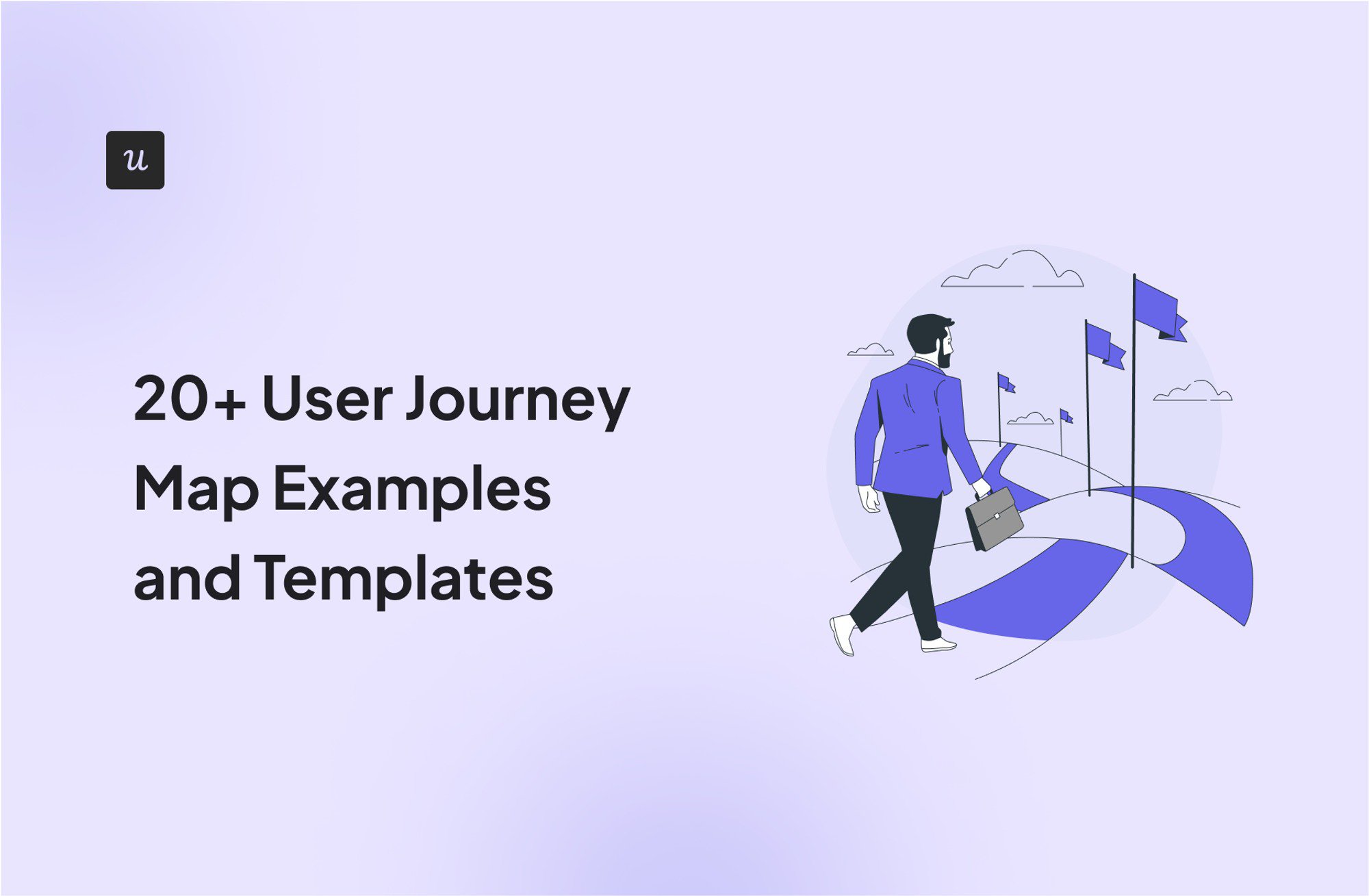
Looking at user journey map examples can help you come up with a visual representation of your customer’s journey.
Customer journey mapping research also allows you to identify areas of opportunity in your processes and plan to reduce those friction points. For instance, you might discover that you need user onboarding software to retain users after the first three months.
So, we’ve compiled 20+ examples and templates of customer journey maps to help you get inspired.
Let’s get started!
- A user journey map is a document that shares the steps a user must follow to accomplish a goal. It can also include sentiments, thoughts, and friction points.
- The terms user journey maps and customer journey maps are usually interchangeable. These are similar because they both tell the story of a customer’s journey . However, they vary in scope, definitions, and goals.
- For instance, a user journey map is usually reduced to a specific product or service; while a customer journey map shows the end-to-end of a customer’s activities involving your product or service, e.g., advertising.
- The touchpoints in a user journey map refer to in-app experiences, and customer touchpoints in a journey map refer to every interaction the customer has with your app.
- Usually, the user journey map influences product design, while the customer journey map informs business strategies.
- There are four types of customer journey maps:
- Current-state maps. To illustrate the customer journey in the present.
- Future-state maps. To speculate on potential user journeys in the future.
- Day-in-the-life maps. To show what a user does in relation or without any link to your product/service.
- Service-blueprint maps. To define everything that needs to happen internally to properly serve users.
- Examples of user and customer journey maps include companies like Hubspot, Zoom, Mailchimp, Dropbox, and Userpilot.
- Templates of user journey maps include service blueprints, customer empathy maps, user touchpoints, and effective journey maps.
- Did you identify friction points in your user onboarding? Try Userpilot , the all-in-one product adoption platform that’ll help you improve your onboarding experience and boost retention rates. Get a demo .

Try Userpilot and Take Your Onboarding Experience to the Next Level
- 14 Day Trial
- No Credit Card Required

What is a user journey map?
A user journey map is a document that shows the steps a user follows to reach a goal with your product or service. It’s usually used for UX visualization as it tells the story of a person navigating your product and their interaction with different touchpoints.
This document also helps you gather information about the user and the functionality they find most relevant.
In your first version of a user journey map, you may only add the user’s actions. But as you expand it, you should also add their emotions and thoughts.
User journey maps vs customer journey maps
User journey maps and customer journey maps are almost interchangeable terms. They both show the road a person takes to achieve goals and help improve the user experience .
However, these vary in scope, definitions, and goals:
- Scope. User journey maps usually showcase the way a user experiences and interacts with a specific product or service. On the other hand, customer journey maps visualize the end-to-end experience of a customer across various brand touchpoints.
- Definitions. The word ‘touchpoints’ has different meanings in each case. A touchpoint in a user journey map refers to interface interactions and in-app experiences. However, a touchpoint in a customer journey map means every moment a customer interacts with or becomes aware of your brand — e.g., advertisements, customer support, or at checkout.
- Goals. User journey maps are useful to influence product design improvements. The insights of a customer journey map , usually inform broader business strategies and customer engagement efforts.
Types of user and customer journey maps
Using customer or user journey maps for different purposes allows you to influence different aspects of your business. For instance, a day-in-the-life journey map lets you spot areas of your customer’s routine where you can participate.
Here are different types of user and customer journey visualization to implement in your business:
- Current-state map. Illustrates the critical user journey as it is now. It helps you visualize the current state of the user experience based on facts. This type of journey map allows you to identify the strengths and opportunities of your current process.
- Future-state map. Design how you wish the customers’ journey could look in the future. This type is aspirational and it’s useful when speculating potential customer paths. It’s mostly based on data from the current state map and creativity.
- Day-in-the-life map. Lists everything a customer does throughout the day despite those actions being related to your brand. A day-in-the-life map gives you an overall understanding of who your customer is, how they spend their time, and where your company falls. This map is based on user research data.
- Service-blueprint map. This is an internal document that states all the actions, policies, and processes that go behind customer-facing services. The service blueprint is usually for employees to know what they need to do to meet the customer across the journey.
User and customer journey map examples
Take a look at examples of user and customer journey maps from successful businesses and get inspired to draft your own.
1. Userpilot’s current user state journey map

To examine the user’s current state, you can use Userpilot to perform a path analysis .
With path analysis, you can identify and understand how users navigate through your product, pinpointing the key interactions and touchpoints they encounter.
For example, to optimize conversion , you can look into how enterprise users navigate toward the conversion point. Then you can use the discovered insights to replicate the experience for new users.
2. Spotify’s music-sharing user journey map

Spotify is a music streaming platform with various features. This example shows a detailed view of a Spotify user’s journey when sharing music with friends and family.
The image shows the steps the user takes to find and share music as well as their thoughts, emotions, touchpoints, and actors. It starts with a user opening Spotify to listen to music at work. They look up the different playlists and feel excited to see the suggestions.
Once they find a song that makes them feel happy, they share it with a friend by sending the link through WhatsApp. They follow up and wait for an answer.
This example is particularly interesting since it includes the actions, thoughts, and sentiments of two different personas.
3. Uber’s first experience user journey map

Uber is a popular transportation company for booking rides. This current-stage customer journey map shows all the steps a user takes from the moment they choose to use Uber as a new user, up to when they arrive at their destination.
It includes screenshots that show exactly what the user sees when they go through each of the customer journey stages.
This example includes goals from the persona on the side. It also includes verbatim thoughts and emotion tags that give you deeper insights into the target persona.
The bottom part of the map shares critical insights that help marketing and sales teams understand the user on a deeper level and improve their experience.
4. Dropbox’s customer journey map

This journey map includes the user persona’s jobs-to-be-done (JBTD) and the path they follow from the problem-awareness stage.
Since Dropbox is a cloud storage platform, using it for business affects the day-to-day of all workers. Hence, this map includes a clever section named “cast” which includes the profiles of everyone who’ll be affected by the decision to use Dropbox.
As you can see, Sophia starts her journey when she discovers Dropbox. She researches alternatives, books a demo, and signs up for the application.
This looks like a future state journey map as it seems quite simplified for a current state map.
5. Mailchimp’s day-in-the-life customer journey map

Mailchimp is a popular email marketing platform. The customer journey map captures everything a marketing worker named Dani does every two weeks.
This customer journey map compiles all the little tasks she does before, during, and after she sends a marketing email.
It’s considered a day-in-the-life map rather than a current-state one because it includes more detail than simply outlining the steps Dani takes to send an email. Instead, it includes the digressions she takes before actually completing the task, as well as emotions and areas of opportunity.
6. Hubspot’s customer journey map

This platform offers multiple services for managing a business. This is the current state of Hubspot’s customer journey . It shows everything a user does from the moment they become dissatisfied with previous tools.
This map explains in detail how customers interact with Hubspot until they become paying users. It also includes all the other actors involved, the factors that lead to a positive or negative experience, and the decision points.
This map also includes thoughts and sentiments, friction points, customer touchpoints, and internal actors involved.
7. Netflix’s customer journey map

Similar to the Mailchimp example, this customer journey map explains the macro steps a user like Jen takes to watch a movie on Netflix.
As a media streaming platform, Netflix’s algorithm comes up with movies and TV show recommendations. This map shows how Jen disregards those recommendations and searches for a different movie instead, making it an area of opportunity for the Netflix team.
As part of the analysis, this map also includes Jen’s pain points, motivators, and emotions. This is an example of how breaking the journey down into smaller goals can simplify spotting friction points by showing an end-to-end process on a single screen.
8. Canva’s user journey map

Canva is an online graphic design platform, mostly suited for non-designers. This user map tells the story of Laura, a woman who isn’t a designer but wants to build beautiful flyers to promote her hobby.
As you see, the map walks us through the process of building a new design. It starts with Laura creating a board and ends when she exports the design. Similarly to the Netflix example, this journey map is also restricted to one scenario.
This user journey also includes actions, pain points, goals, expectations, and thoughts across the phases.
9. Zoom’s user journey map

This popular online meeting platform serves different purposes. This example is about Zoom for teachers and it’s broken down into three main categories: Action, emotions, and thinking.
This user journey map explains what a teacher does to give online lectures. It’s separated into five main action buckets with a breakdown of the tasks that go into each bucket. For example, for a teacher to “Start teaching” they need to open Zoom and roll the call.
You can also see how the teachers’ emotions and thoughts vary throughout the session. Plus, the design of this map lets us quickly identify opportunities just by looking at the emojis.
10. HeartiCraft’s user journey map

HeartiCraft is an online store for people who want to buy handcrafted products. The experience begins when the user researches and finds the website and ends when they decide to buy again.
It’s an interesting view of a user journey map as it exposes where HeartiCraft shines but also where it fails to delight users.
This map highlights four different stages and includes all the actions, thoughts and feelings, pain points, and delights under each of them.
11. Say Yeah!’s customer journey map

This company helps businesses deliver products and services that better serve neurodiverse users. To analyze this customer journey , you need to place your eyes on the left side of the screen and skim through the stages.
As you can see, this is the journey of an adult child looking for health support for their parents. It starts at the moment they discover a problem and ends after they’ve made a purchase.
This map includes the tasks, actors, emotions, media, tactics, and the thinking process of the user across the stages. It also shows how relevant each of those moments is for serving the customer properly.
12. Gartner’s B2B customer buying journey map

As a consulting firm, Gartner has a deep understanding of the B2B sales process. You can see that in this example because it paints the B2B buyer’s journey as a non-linear path.
This is likely informed by historic customer behavior, journey analytics , and user research. In the map, you’ll see four main actions across the user’s journey that allow them to buy a product.
However, there are internal discrepancies that Gartner manages to capture in this map. For example, showing that the person meeting with the company isn’t necessarily the decision maker and needs to go back and get the CEO’s approval before agreeing to make a purchase.
13. Service blueprint map for technical support

As mentioned above, a service journey map helps employees know what needs to happen internally to power customer-facing tasks. In this example, we can see how systems are interconnected and linked to company policies.
This map also shows the actions employees take to provide service, including the invisible back-end tasks and the evidence that supports each action.
Templates for user and customer journey mapping process
Explore the different templates included on this list, and edit them to fit your customer journeys:
1. User journey map template in Figma

You can leverage this template on Figma for your customer journey mapping exercise and uncover user activities and emotions across different stages – from realizing their needs to becoming a paid customer.
It allows you to add what you expect the user’s emotions, experience, and expectations to be at each of the stages.
You can include as many ideas as you wish on this canvas or even invite your teams to work on this together.
2. User empathy mapping template in Notion

An empathy map compiles your target user’s feelings, thoughts, and behaviors.
This Notion template follows the classical approach by including the four main categories:
- Says. Direct quotes or statements that provide insight into the user’s thoughts and opinions.
- Thinks. Reflects the user’s thoughts, beliefs, and feelings.
- Does . Includes what the user does in real life or during their interaction with a product or service.
- Feels . Fears, frustrations, joys, and other emotional responses.
3. Future state customer journey map template from Xtensio

Use your creativity and your current state journey map to fill out this template. Explore alternative customer paths to offer a better customer experience.
This template includes space to add:
- Stages of the journey.
- User’s thoughts and feelings.
- Actions and touchpoints.
- How this map is different from the current journey.
4. Service blueprint customer journey map template from Miro

This is a typical service blueprint template. Miro lets you edit it to your liking by following these steps:
- Define the customer service scenario to investigate.
- Plot customer actions in chronological order.
- Lay out processes, actors, and support systems.
- Add roles and responsibilities by specifying interactions, visibility, and internal actions.
- Illustrate cross-functional relationships.
5. Customer journey map template from Mural

Use Mural’s customer journey map template to have a better understanding of your target audience’s touchpoints, needs, motivations, and barriers.
Here you can:
- Establish a customer scenario, e.g., buying a shirt online.
- Define the customer steps, including big and small actions.
- List all customer interactions with your brand, either in physical or digital touchpoints.
- Determine your customer’s goals and motivations.
- Highlight the positive moments at each stage.
- Define the negative or frustrating moments across the journey.
6. Customer journey map template from Canva

Find many different customer journey map templates on Canva. These all let you edit the customer actions across stages, and depending on the option that you choose, you’ll also be able to add the user’s:
- Emotions and feelings.
- Thinking process.
- Physical or digital touchpoints.
- Barriers or pain points.
- Solutions to barriers.
7. Customer touchpoint map template from InVision

Map out the customer touchpoints on this InVision template. Here, you’ll be able to list all the different interactions between the user and your business, as well as mention all the involved actors. You can break down the actions by stages and teams.
8. Customer journey mapping template from Slidesgo

Slidesgo provides you with 29 customer journey mapping examples. You can choose the design that piques your interest the most and add the different stages, touchpoints, actions, and sentiments. These designs are mostly suited for journeys of up to five steps.
9. B2B customer journey map template from UXPressia

UXPressia developed a set of B2B/B2C customer journey map templates for you to use. This mix also includes persona templates to guide you when creating personas for your journey maps.
You can use these templates as-is to guide your thinking or adapt them to fit your specific project needs.
10. Customer journey map template from Conceptboard

This customer journey map template is a classical one. Open the file with a clear understanding of your user persona.
There, you’ll be able to add customer data concerning each stage, more specifically regarding their:
- Touchpoints and channels.
- Overall experience.
- Pain points.
- Areas of improvement.
Exploring user journey map examples can inspire you to enhance your customers’ experience by pinpointing critical areas, such as better onboarding processes.
To create an effective customer journey map, you need a deep understanding of your user and a clear mapping path, i.e., via conducting user interviews and contextual research.
Userpilot is an all-in-one product platform that can equip you with actionable customer journey insights. Get a demo to explore our powerful analytics capabilities!
Leave a comment Cancel reply
Save my name, email, and website in this browser for the next time I comment.

Get The Insights!
The fastest way to learn about Product Growth,Management & Trends.
The coolest way to learn about Product Growth, Management & Trends. Delivered fresh to your inbox, weekly.
The fastest way to learn about Product Growth, Management & Trends.
You might also be interested in ...
Customer activation rate in saas: definition, benchmarks & more.
Aazar Ali Shad
Product Onboarding Feedback Questions and Best Practices
Pendo vs userpilot: which offers the best value for money.
Adina Timar
User Journey Test
24 April 2013
Martin Fowler
test categories
User-journey tests are a form of BusinessFacingTest , designed to simulate a typical user's "journey" through the system. Such a test will typically cover a user's entire interaction with the system in order to achieve some goal. They act as one path in a use case.
They are usually BroadStackTests and as such, are usually slow to execute and prone to being brittle. Consequently suites of user journey tests usually aren't built to be comprehensive tests of a system's behavior. Usually you will have only a few user journey tests to exercise the integration of the system as a whole - probably only one path for each use case (usually the happy path). Verification of all the variations in behavior is left to tests done in different styles, usually with more focused coverage.
In contrast to StoryTests , user journey tests are not tied to user stories. When you play a story you look at the existing user journey tests and modify them to support any change in behavior implied by the user story, only rarely does a user story lead to an entirely new user journey test.
Skip navigation

World Leaders in Research-Based User Experience
7 ways to analyze a customer-journey map.

March 22, 2020 2020-03-22
- Email article
- Share on LinkedIn
- Share on Twitter
A customer-journey map is an infographic visualization of the process that a persona segment goes through in order to accomplish a goal. Journey maps are useful in communicating the general narratives and themes uncovered by longitudinal research done to understand how a customer works toward a goal over time.
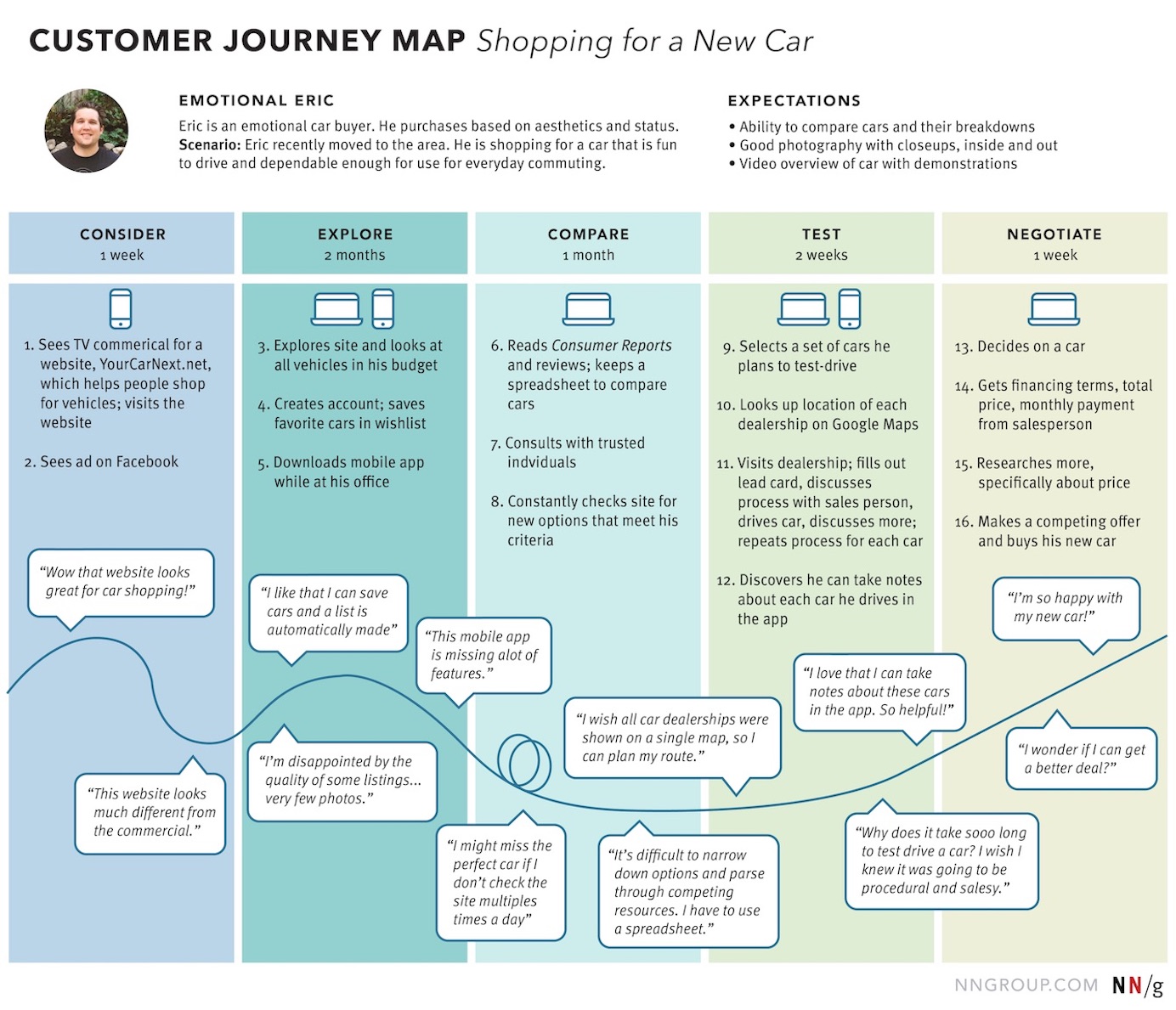
This journey map includes all the information necessary for understanding and analyzing the user experience of shopping for a new car. In this illustration, we have intentionally left out one key piece of the map — the insights and opportunities gleaned from the map. This section is often found at the bottom of a customer-journey map and highlights how the organization can optimize and improve the customer journey.
In this article we will demonstrate how to analyze a journey map and, thus, how to identify the insights and opportunities for improvement.
In This Article:
Analyzing the journey map.
Longitudinal research and analysis is necessary to create a map like this.
Every journey map will look different because the research insights and the resulting visual depend entirely on the context of the journey, its underlying activities, and the persona completing it. That said, there are 7 common elements you can and should look for when analyzing a customer journey.
1. Look for points in the journey where expectations are not met.
Users go into an interaction with an organization with certain expectations. When the interaction does not meet their expectations, you see pain points in a customer journey. To identify these instances, first reflect on who the persona is. Ask yourself; what is important to this persona, where did she come from before this journey, what has she seen and what does she know already? Putting yourself in the user’s mind space will allow you to understand which interactions conflict with user’s prior ideas and expectations.
Of course, you should look for places where users verbalized their concerns, but also use your logic to assess interactions with no explicit complaints or negative comments.
Sometimes people bring their expectations into the journey from other experiences. For example, users expect that when they pull up to a hotel, the bellman will open the door, because that’s what always happens when you pull up to a hotel with a bellman — it’s the mental model that they have formed for that situation. Some organizations set inaccurate expectations early in the customer journey. Others don’t set expectations at all, forcing users to make assumptions and possibly be disappointed if those assumptions prove wrong.
Find the trouble spot and work backward to identify the triggering factor and how the expectations were (or were not) set. Work to resolve the conflict between expectations and reality.
In the car-buying journey map, there were two clear points where Eric’s expectations weren’t met. These instances are annotated using red numbered circles.

2. Identify any unnecessary touchpoints or interactions.
Are there any steps in the customer journey that could be eliminated in order to streamline the total experience? Look for logical ways to optimize the process to reduce total interaction cost . That may mean removing an existing step that is no longer needed or adding something to the experience that bring efficiency to the overall journey.

3. Identify the low points or points of friction.
When you step back and look at the whole journey, you should be able to see where the user experiences the most pain or friction. These points are usually represented visually as dips in the journey diagram. See where the journey reaches its lowest point and compare it to other low points in the journey. These should be on your shortlist of optimizations. That said, not all fixes are created equal: there can be dependencies and constraints involved. Work with your team to decide which low points should be addressed first and which can come later. (Because of the peak-end rule , the lowest point in a journey will have a particularly ruinous impact on the branding effect of the user experience.)

4. Pinpoint high-friction channel transitions.
Many journeys take place across devices or channels . A lot of times the journey breaks down and friction appears when users change channels. For example, a user receives a newsletter about a specific offering from a company. She’s interested in the offering and clicks the call to action in the newsletter. However, instead of being taken to a landing page detailing that particular offer, the user lands on the company’s homepage. At this point, she has to put in effort to find the offer. Or, another user may begin filling out a form on the mobile phone, but wants to complete it on the laptop when it becomes too laborious. Doing so means losing work and starting over. These channel-transition pain points should be identified and streamlined. Think outside of the box: rather than forcing users to work hard, build a bridge for them to get to the other side easily.

5. Evaluate time spent. In your journey map, provide time durations for the major stages of the journey.
This information gives you another lens for analyzing the experience. Assess how long it takes users to achieve the underlying substeps. Are these times appropriate? Time spent often correlates to the amount of user effort. Call out areas of the journey where time and effort are problematic.

6. Look for moments of truth.
Some points in the journey are so important that the rest of the experience might hinge on them. Think about the personas’ attitudes, needs, and priorities. Is there a make–or–break moment in the journey for that persona? This moment may be where your research shows a lot of emotion or where you see a strong divergence between the paths different users take. If this moment goes well, it can save the experience. For example, think of the first time a car-insurance customer files a claim. She’s been paying her policy responsibly, and now she needs her insurance to come through seamlessly for her. The first interaction in the claim experience might be a moment of truth for this persona. If it goes wrong, the user may move to a competitor. Be sure to look for moments of truth and to call attention to them when you find them.

7. Identify high points or points where expectations are met or exceeded.
Good UX practitioners should always balance their analysis by pointing out things that are working well in any experience. Look at the high points in the journey — the interactions that users are happy with. Where do they express positive thoughts and emotions? These insights are also valuable. You may be able to amplify them or recreate similar experiences elsewhere in the journey.

Whether you’re evaluating journey research for the creation of a map or digesting a map created by another party, it’s important to know what to look for. As the creator of the map, you’ll want to identify and call attention to these important elements through visual emphasis and storytelling. As a consumer of the visualization, apply this checklist like lenses through which to view the map in order to find the most actionable insights.
Related Courses
Journey mapping to understand customer needs.
Capture and communicate UX insights across complex interactions
Omnichannel Journeys and Customer Experience
Create a usable and cohesive cross-channel experience by following guidelines to resolve common user pain points in a multi-channel landscape
Interaction
Customer-Journey Management
Establish and operationalize journey-level experience design work across functional groups for continuous improvement
Related Topics
- Customer Journeys Customer Journeys
Learn More:
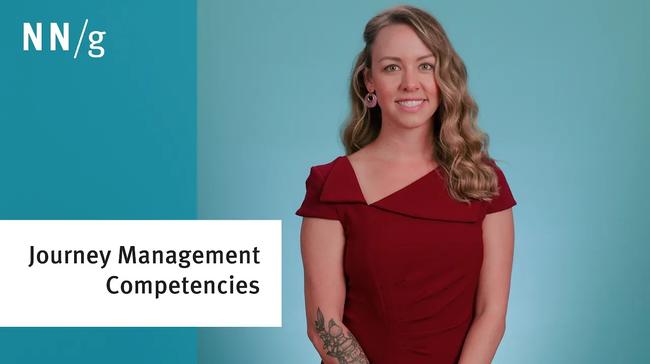
The 3 Competencies of Journey Management
Kim Salazar · 5 min

Journey Management vs. Service Design
Kim Salazar · 4 min

Types of User Pain Points
Sarah Gibbons · 4 min
Related Articles:
How to Conduct Research for Customer Journey-Mapping
Kate Kaplan · 7 min
Good Customer Experience Demands Organizational Fluidity
Kim Salazar · 7 min
Journey Mapping: 9 Frequently Asked Questions
Alita Joyce and Kate Kaplan · 7 min
Remote Customer Journey Mapping
Kate Kaplan · 5 min
Journey Mapping in Real Life: A Survey of UX Practitioners
Customer Journeys and Omnichannel User Experience
Kim Salazar · 6 min

Customer Experience Testing: the ultimate guide to the mapping and planning of your CX journey

Customer experience testing goes beyond the usability and user experience testing of websites, applications, and software. It aims to test a range of digital and physical products as well as services that span multiple online and offline points thought the customer’s journey.
In other terms, customer journey testing considers everything your target customer goes through as it is everything that they hear, touch and see throughout the experience with your brand. Do you know what they are going to feel or think? If your business wants to grow, better its retention rate as well as build loyal advocates, you need to deliver a superior customer journey to each member of your target audience.
How can you get into your customer’s mind to improve their engagement with your brand? Read on to discover the various types of customer experience testing methods as well as detailed guides from PlaybookUX on how you can utilize these testing insights with the rest of your team.
Before you proceed with any customer experience testing method, you need to map out your customer journey. To do that, you can use these four tools:
Customer journey map

A customer journey map can help you assess an entire customer journey from start to finish. It will layout the steps that a customer will take together with the feelings that this customer can harbor for your service or product. As well as creating a better understanding of your product between your team members, customer journey mapping will also uncover various ways your business can grow and improve when creating a user’s journey. To appreciate what customers experience when they try to use your product, you need to start by creating two sets of customer journey maps. The first one will visualize the user’s current experience while the second looks at your users’ future experience with your product.
Before you create this map, you will need to identify your target persona and look at all the previous research gathered on customers such as competitor analysis data or customer satisfaction surveys. Discuss these aspects with the rest of your team members during a customer journey mapping workshop. If you also haven’t got any existing customer research yet, you could try conducting a moderated or unmoderated interview at first before you devise a customer journey map.
The customer mapping journey workshop will involve drafting and filling in a template that looks at the different stages of a customer journey, such as awareness, researching, selection, delivery, and follow up. This template will also look at what the customer does, their thoughts, their pain points as well as the mediums that they communicate through when accessing your product. To save you time and money, PlaybookUX has already created a customer journey map template for you so you can get started. If you are facilitating this workshop for the business, encourage your team members to work together to fill this template. You should also ensure that any customer journey map created continually evolves and develops with your business.
Empathy map
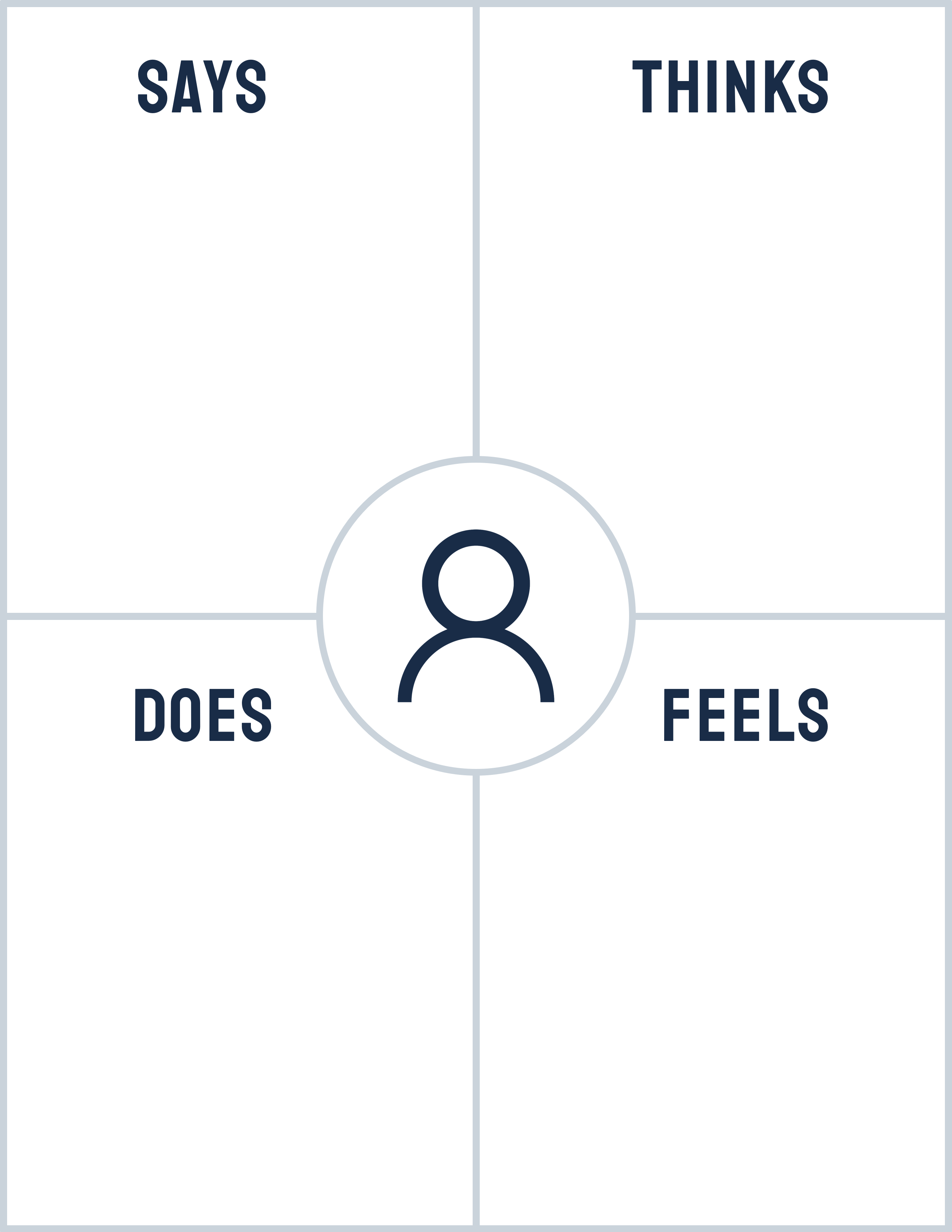
If you want to divulge further into what your target persona thinks, feels, sees, hears and says, you should create an empathy map to develop a collaborative understanding of your customer’s needs. Before you create an empathy map, you can try to conduct a moderated, one-to-one interview with participants to gain a better understanding of your users’ feelings. Once you have insights from this interview, you can use it to create a UX target persona to develop your target customer. Once you have both pieces of information, you can work with specific members of your product team to build a system that puts your customers’ needs first.
When creating an empathy map, you need to start with a template that puts an image of your persona in the middle. Divide the page into four sections of ‘says’ ‘thinks’ ‘does’ and ‘feels’. When filling out these sections, think back to the insights derived from your moderated sessions as well as your UX target persona sessions. What did those participants say about your product? What do they think they need in their day-to-day job role? What do they love or hate about your product? Your empathy map can be filled out using insights from more than one user. If you would like a specially created template for empathy maps and its uses, PlaybookUX has already created one for you to use.
Assumptions map
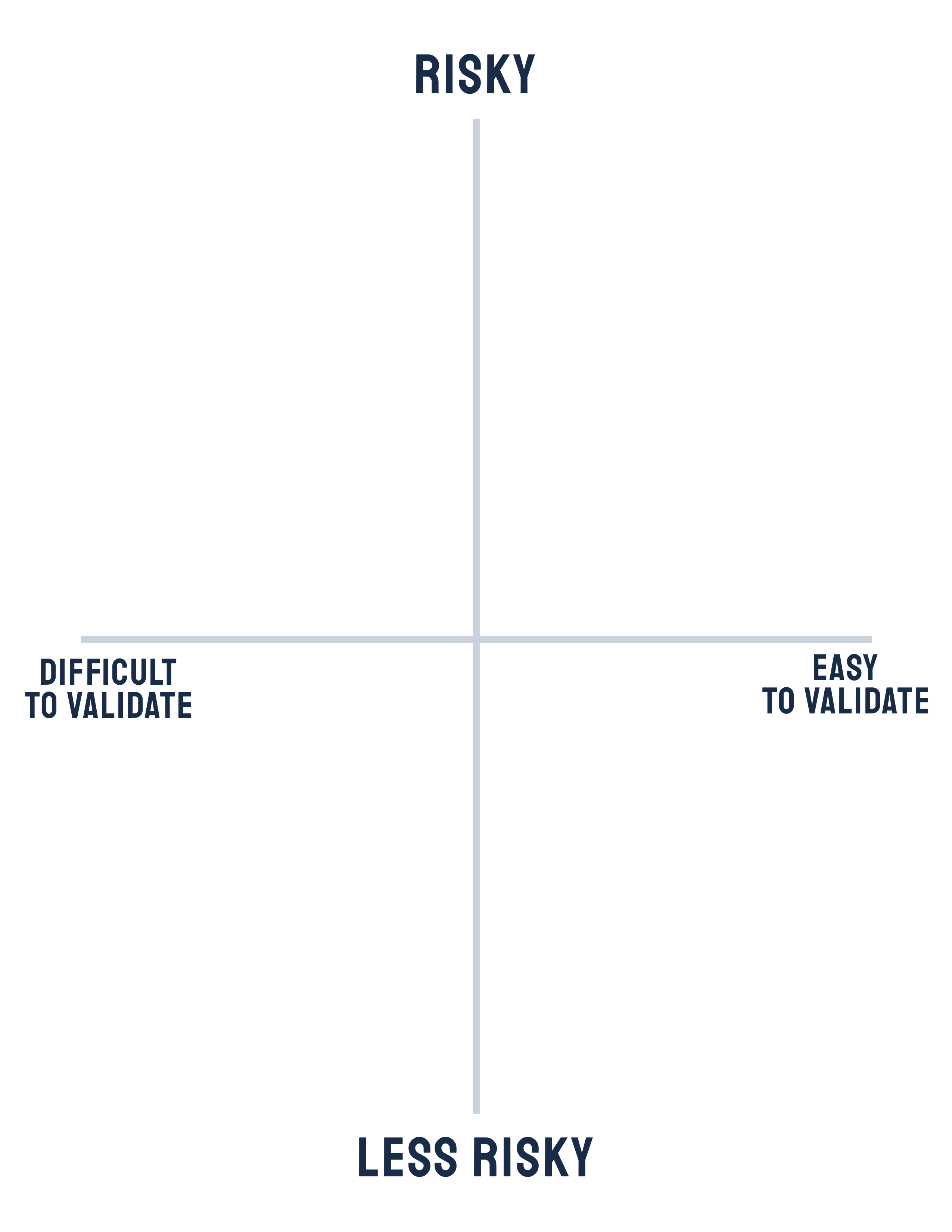
It’s easy to rely on an assumption or a hunch when releasing a product. But sometimes the excitement of merely wanting to get a product out there can prevent you from questioning whether your product /service has a market fit i.e. is it something that your target customer needs? The first step towards validating your assumptions would be to conduct a qualitative research study. A moderated session allows you to draft open-ended questions to ask participants that would attempt to see if any of these assumptions about your product are true. Next, hold an assumptions map workshop with key stakeholders in your business so that together, you can come up with an assumptions map, based on the insight got from your moderated sessions. Divide your assumptions map template into ‘risky’ vs ‘non-risky’ assumptions as well as ‘difficult to validate’ and ‘easy to validate’ assumptions. Want more help on this topic too? PlaybookUX can spoil you even more with our comprehensive guide on how to develop an assumptions map , including what you could consider examples of ‘risky ‘and ‘difficult to validate’ assumptions.
User personas
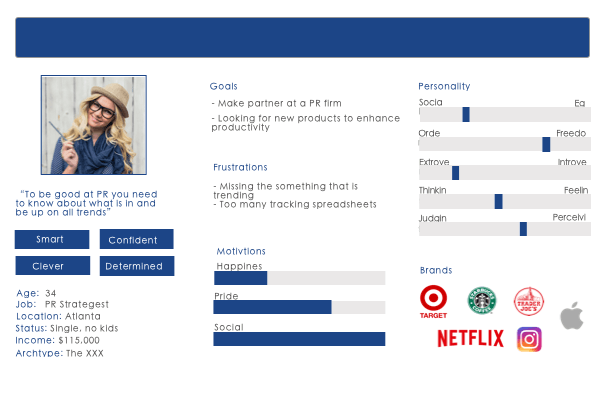
What is an empathy map incomplete without? A persona can help you determine the ideal individual for whom you are creating your product /service. In the long term, it means that your team will have a better way of designing features for your product that meet the motivations, needs, and desires of your ideal customer. When you begin, start with around two personas as creating too many personas will mean that your team will lose focus of all the essential facets of your core target group.
When creating a persona , use a moderated research session so that an experienced moderator can guide the conversation towards the questions that your business needs answering. If your company lacks the budget for a moderated interview, opt for a persona-based, internal stakeholder interview or a competitor analysis exercise. The types of questions you should be asking to get details for your personas include asking what a relevant individual does in their spare time as well as what their favorite brands are. Ask questions about their employment, such as the hours they work for or what their goals are.
Once you have your customer journey map, you are ready to conduct customer experience testing using one or a combination of these 11 methods:
Moderated customer experience testing

Having a one-on-one conversation with your target persona as part of a moderated interview can be difficult and often expensive to organize. Conduct this type of customer experience testing within a usability testing lab where your target persona complete computer/mobile-based tasks as a trained moderator observes their behavior and asks relevant questions. It is also vital for collecting detailed data and insights on your customer journey.
If you want to test a broader cross-section of individuals, you could also opt for guerrilla testing where representatives from your business can collect large quantities of qualitative data from test subjects chosen at random. These individuals would be asked to take part in a quick usability test which would last for around 5-10 minutes. However, if you are looking for an extensive or targeted customer journey testing method, this is not the interview-based method for you.
An excellent alternative to a lab moderated testing environment would be a phone usability test. Here, a moderator would verbally provide participants with instructions so that they can complete tasks on their computer. Record the electronic behavior of the user remotely.
Are you looking for detailed feedback on the layout and navigational structure of your website? Try a moderated card sorting test where users are required to sort out virtual note cards into categories or groups of their choice. Following this, a moderator or facilitator will then run a debriefing session so that the participants can explain their reasoning for structuring the cards in a certain way. This test allows individual concerns and misunderstanding to be cleared up in person. You could also capture any discomfort with the product or with the questions asked.
PlaybookUX can help you make the best use of these types of moderated interviews as our service offers experience in objectively asking questions to make any participant feel comfortable. We also have experience in knowing when and how to probe for further explanations. Not only can PlaybookUX help your business to find the right participants for your customer experience testing process, but we can also analyze and report the results for you. So that’s one less thing that you need to worry about post-interview.
Omnichannel customer journey testing
Have you ever been guilty of treating a customer like a number, not a person? It’s easy to do as a challenge could be ensuring a streamlined customer journey approach on all critical platforms that your target customers use, both digital and physical. Omnichannel testing aims to compare customer experience across various channels or devices within a specific customer journey. For instance, if your brand is a supermarket or department store with a brick-and-mortar as well as an online presence, use a selection of moderated and unmoderated customer journey testing methods. In this scenario, you can observe how shoppers behave in real life through different channels when discovering, comparing and purchasing a product.
For instance, PlaybookUX could help you plan an unmoderated test involving your customers navigating through your website while you could also plan a moderated test with a selection of your products. Our user research software uses an AI algorithm that can assist your business in recruiting, conducting and analyzing customer experience research sessions. These sessions will provide you with an insight into what your participants said as well as what they felt.
In this way, these customer journey insights could help you build a cross-channel content strategy that will improve your target persona’s customer journey. The benefits of omnichannel customer experience testing include a return-on-investment as you are using a collaborative approach that acts one process to improve customer experience. A collaborative approach also makes it easier for your business as you can easily track successes and failures with a streamlined process which, in turn, results in a stronger brand with loyal customers.
And that’s not it. One could say that PlaybookUX enables cross-channel content strategy testing as we do not limit a business to only using Chrome. Our software will allow you to run customer journey testing and interviews on all browsers. This feature means that it will be clear how participants interact with your product, website or prototype across any browser. This process will also expand the pool of participants you can access our software.
Localization / internationalization customer experience testing
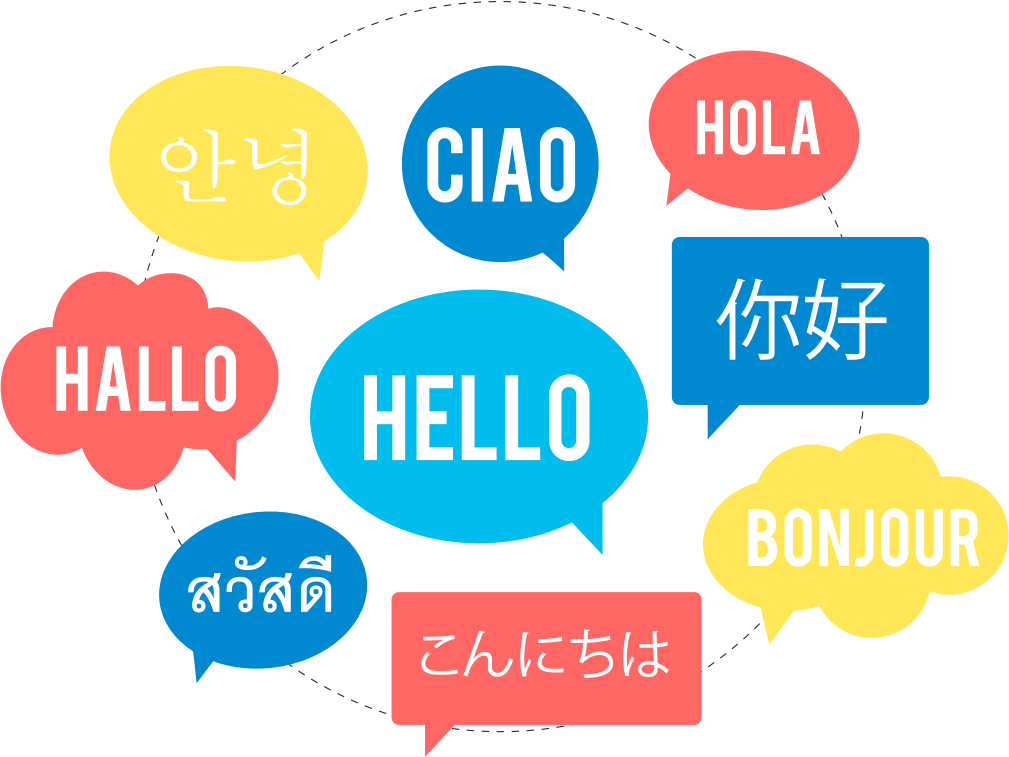
Do you know how your international customers view your product? If not, a moderated customer journey testing session with these types of participants can help a brand understand and appreciate acceptable ways of interacting with local cultures and meeting their specific buyers’ expectations. For example, while a thumbs-up gesture is fine in the United States or the United Kingdom, it could be offensive in Australia and the Middle East. This difference means that different markets need different approaches. Some markets also value the service provided after buying a product as more valuable than the support received before you bought a product.
Your business, if you want to trade internationally, needs to think about whether your product’s message is universal. Localization or internationalization is the process of making your product or service as adaptable as possible so it can quickly enter different national/ local markets. Some considerations businesses should consider when localizing a product include the systems of measurement, currency, and symbols. PlaybookUX can help you develop the right localization strategy as it can help you source a range of participants from around 50 countries for a moderated interview which can be conducted remotely or in person. If you are struggling to develop the right types of questions to ask an international audience,
PlaybookUX can also provide you with some moderated or unmoderated session templates which can give you the necessary tools to frame your questions for these participants. But, if your business prefers a ‘do it -for you’ service, PlaybookUX also offers this and can take charge of getting you the best results. Our in-built video player also enables you to see first-hand what your participants feel and think about your product. You can take note of any points of excitement, confusion, and frustration, which will then mean that you are building better outcomes for your customers in the future.
Accessibility customer journey testing
Is your product/service accessible by people with disabilities? If not, this could be one reason why your website, product or service is not attracting all the types of customers that your brand wishes to serve. For example, visually impaired users require background and text on your website to be in high contract colors rather than subtle greys or lighter color palettes. You could also improve your customer experience for all types of users by considering keyboard navigation for a user who has difficulty with a mouse.
A visually impaired individual could also benefit from your business’s use of a screen reader that works in collaboration with an operating system to give it information about icons and menus etc. so that the right type of data is seen on screen. Conducting an unmoderated or moderated customer experience test with Playbook UX’s wide range of participants will allow you to improve your product usability and functionality as well as customer satisfaction. Vetting of all our B2B testers occurs through LinkedIn, which means that you know who your participants are. Also, our software now allows you to amend the number of participants after the launch of a study.
Using surveys to test customer experience

Use a survey as a customer experience research tool to gather insights about the preferences, attitudes, and opinions of your preferred users on a topic. For example, your business could use a survey to reach a wide variety of participants which could aim to find out why a certain number of individuals don’t use your service as often as you would like them to. When using an online survey, it is best to keep it short so that your questions focus on what is essential. You must also avoid any complex or ambiguous wording so that participants do not find it difficult to answer the questions for your survey. If you are struggling in determining the best questions for your target audience, take advantage of the variety of free templates that PlaybookUX offers. We have crafted these templates and questions as we know how valuable customer experience testing is and so we want you to extract the utmost amount from every session.
Sentiment Analysis

Could you imagine having to sort through data after collecting it from a qualitative research study? Manually sorting through this data is neither efficient nor cost-effective. A manual approach could also lead to errors and a lack of data consistency. And that’s where sentiment analysis comes in. It is an AI-automated process of analyzing qualitative data and then sorting these opinions out as negative , positive or neutral . Your business can use this to automatically assess, for example, survey responses, social media comments, product reviews as well as social media comments.
If you use PlaybookUX’s software to perform a moderated or unmoderated customer experience test, you could get sentiment analysis within any of these packages. We can enable this data storytelling technique through our extensive analytics dashboard. If you wanted a more detailed level of sentiment analysis, you could always sign up for our ‘do-it-for-you’ service where we can offer even more synthesis following customer journey testing.
Usability customer journey testing
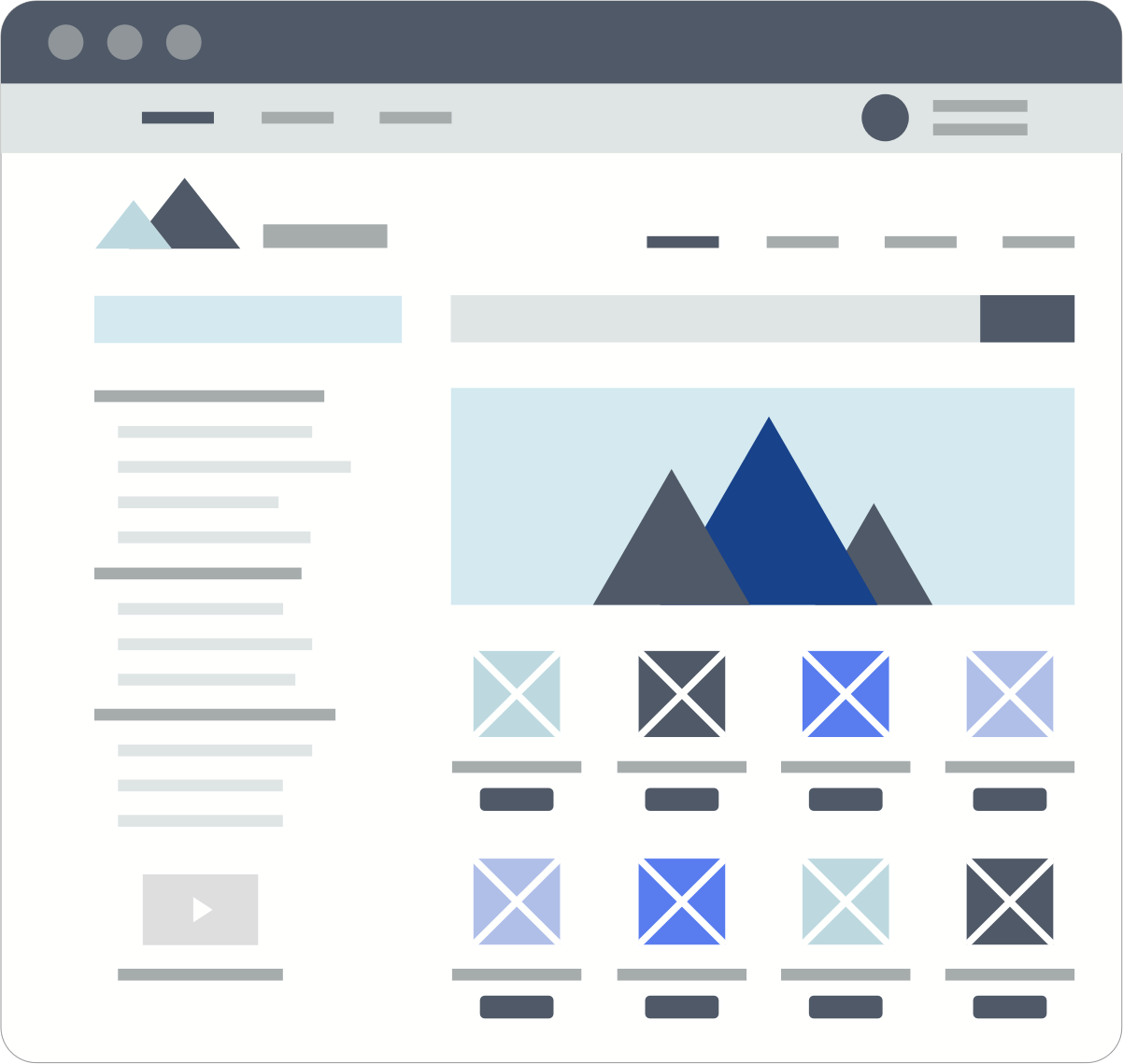
Unmoderated and moderated testing involves watching your participants navigate through your website, product design features or applications. Their behavior and statements are recorded for you to analyze. If you are a business who is trying to sell a software-based product, you will need to ensure that it has a good design so that your target audience will find it easier to use.
In the process of developing several prototypes for a new feature but cannot decide which variation of the feature to use? Conduct an A/B test to test two variations of this feature associated with your product. Eye-tracking testing is another qualitative research study option which you can use to inform your business about what aspects of your product’s design captures your target persona’s attention. This method will need a unique tracking device, but it will produce a heatmap of a webpage that will demonstrate the area of the page that the participant looked at for a long time as well as what parts of the page they ignored. If you want to combine the methods of eye-tracking and first-click testing, try a blur test that aims to find out whether certain items like logos catch the user’s attention by color and layout, even if an image is blurred.
While PlaybookUX’s moderated sessions would allow a business to conduct one-on-one interviews, our unmoderated sessions also allow you to set tasks directly for testers and then requires a participant to record their screen and audio while finishing specific tasks. Rather than using different pieces of software for customer experience testing, PlaybookUX’s software allows you to capture the entire research lifecycle as our dashboard can get customer journey feedback without giving you the hassle of recruiting, scheduling, rewarding participants, note-taking and sourcing meaningful insights.
Navigational customer experience testing

You will also be able to improve your customer experience by testing the navigational structure of your website. If your target audience cannot find what they are looking for on your webpage, they will swiftly look for a competitor’s product. A better sense of navigation will also reduce the amount of customer support requests you receive from frustrated customers who cannot find what they are looking for on your website. Apart from the qualitative research method of card sorting, you can also use a testing method like tree testing where, once you have a navigation structure in place, you can ask your target persona to find specific items within that structure. If they find it difficult to find all or most items, you will need to improve this structure. You can also combine this method with card sorting to create a better feedback loop.
Do you want your criteria for participants to be even more niche? PlaybookUX’s software allows your business to ask participants qualifying questions so that you can make sure that they’re an exact product/service fit. This feature means that our service can offer you real data insights that will appeal to your actual target audience.
Web analytics testing
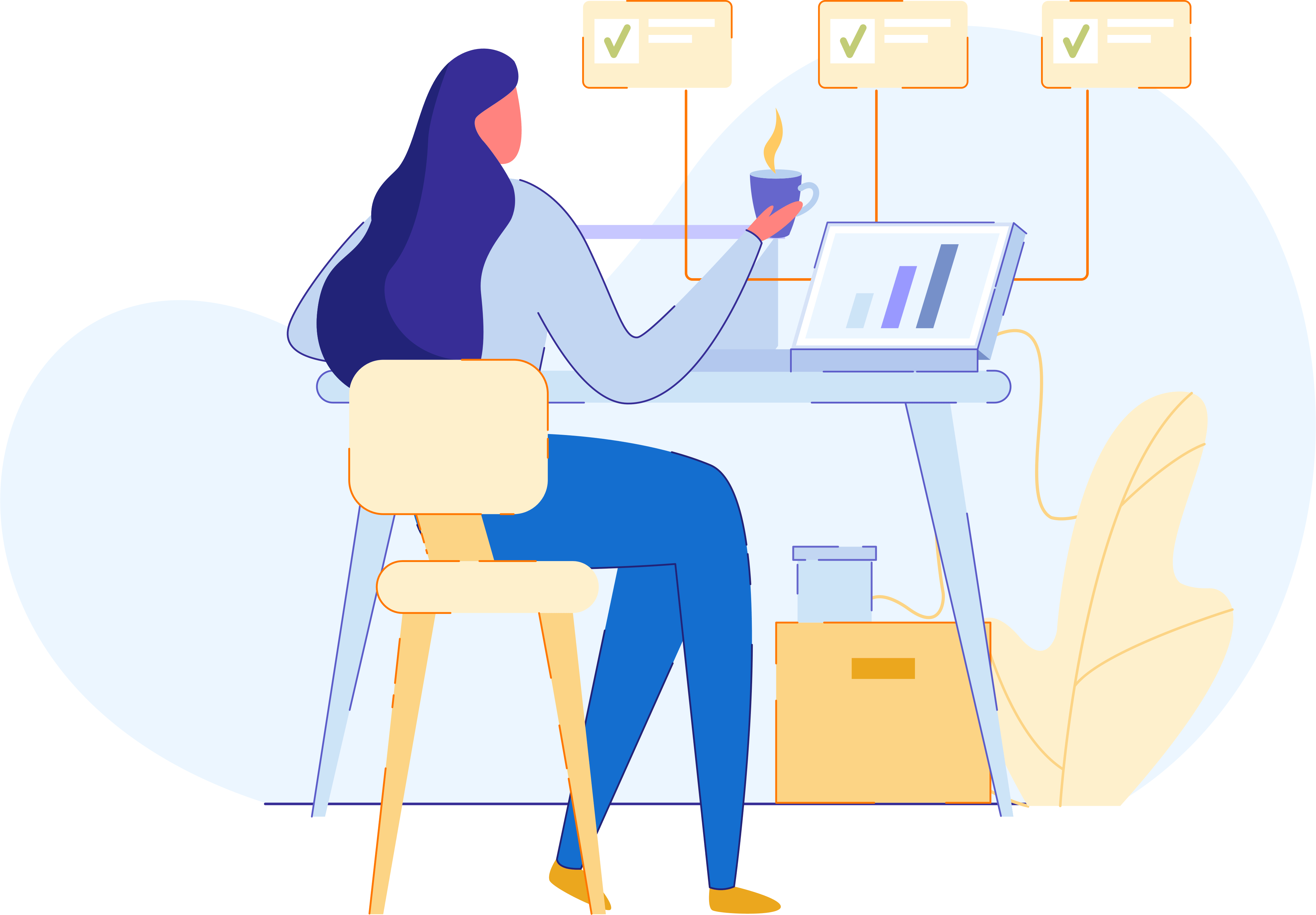
As a business, you will also want to know how effective you are in meeting your customer’s needs. Web analytical systems like Google Analytics or a survey can help you track goals, such as whether you have reached your customer-focused goals. While your target users are browsing through your website, allow them to tell you whether they met their goal after looking through your site with ‘yes’, ‘no’ and ‘partially’ options. This software should also be programmed to trigger an open-ended follow-up question if your customer answered ‘no’ or ‘partially’.
Go further than Google Analytics with the use of a customer effort score (CES) to determine how easy it was for your customer to reach a goal through your website. You could use this tool to also improve customer loyalty by allowing dissatisfied customers to leave you their details if they want their issue resolved quickly. You could also program your chatbot to pop up if a customer has had a less pleasant experience. Your chatbot service could then aim to solve their problem and possibly convert the customer into a regular one. Using customer satisfaction (CSAT) analytical method can also show you what aspect of your website works well so that you can then further optimize the benefit of this area. This method involves sending your customers a survey that then enables them to rate their level of satisfaction with your product or service as ‘not satisfied’ or ‘very satisfied’. You could also have an ‘it depends’ option to allow individuals to offer further customer journey feedback.
Want to take notes when watching interviews after customer experience testing? Our software is built with an automated transcription service that runs at the side of the video session, meaning that you can then analyze all the sessions more efficiently. Clicking on a specific task set for the participant will direct you to the relevant spot in the video. This feature will make any session replay as easy as possible for you.
Our dashboard also allows an infinite number of your team members to view notes and collaborate on topics to keep everyone in your business within your customer journey feedback loop.
Resilience testing for the customer journey
Does your product/service perform well in real-life conditions? Try software resilience testing to assess whether your product/service can withstand stress and other challenging factors that can affect peak performance. You could also identify weaknesses in your system by using PlaybookUX to test different versions of a scenario where one group gets a steady-state situation, and the other receives a failure scenario. Use a moderated or unmoderated session to observe how the participant deals with it and record any suggestions they have for improving it. Examples of aspects of your business that you can test for resiliency include the data backup process, load balancing, traffic management as well as a failure of an interface system.
Content strategy testing

Your business can also create a better customer experience by testing your videos, website copy as well as your email marketing strategy to make sure that these are in line with your target customer’s needs. Once you do this, you can increase your conversion rates for clicks, downloads, and purchases.
You need to personalize your product/service to a customer’s tastes to make their journey /experience more relevant. You can use a variety of qualitative tools to test your content strategy, such as eye-tracking. This test indicates the parts of your website where users pay the most attention. Try a session recording test, which can also show you where participants can get lost or even a moderated session where you can probe participants for further information about certain aspects of your content strategy.
If you are looking for software that makes recruiting your target persona easier, your efforts in reading this article have not been in vain. PlaybookUX does make it easy to hire your target demographic as our software is built with ten different demographic & employment filters. Our granular user experience testing filters allow any B2B or B2C company to receive user feedback from their specific customer base.
If you’re a B2B business, we provide access to participants with a specific job title, industry, seniority, and company size. Our two-step verification process ensures that we verify most testers through LinkedIn as well as double-check it by hand, so you’re getting the best quality of participants.
Start investing in customer experience testing so that your business achieves a better sense of customer loyalty and an increase in revenue. Fantastic CX involves giving each unique customer a valuable, easy-to-use and enjoyable experience on any device that they use across every touchpoint. This experience must meet the expectations of the product or service that you set in the beginning. Looking to start your 2020 with an affordable yet effective customer experience testing strategy? Let PlaybookUX know more.
Usability testing methods
International user testing
Idea validation
User Research
Moderated interviews
Unmoderated user research
User research recruiting
Prototype testing
Usability testing
Concept testing
UX research
User Testing Templates
First Impressions Test
Brand Perception Questions
Competitor Testing Questions
Concept Testing Questions
Persona Interview Questions
Website Navigation Menu
Logo Testing Questions
Pricing Model Test
Company Name Test
Speak to high quality people

For Merchandisers
For Data-Driven Execs
Integrations
Use our integrations to easily connect and move data between your technologies and systems.
Technology Partners
With our partnered solutions, you get access to additional services and technologies to solve customer problems.
Become a Partner
Bloomreach is the leader in ecommerce personalization solutions — join our partner ecosystem to unlock limitless potential.
For Industries
For Customers
For Getting Started
Case Studies
Optimize Performance
Get Expert Insights

The Edge Summit
New York & London, September 2024
For Marketers
There Is No Upgrade From Bloomreach
Find the perfect package for your business. Unify all your customer and product data and deliver connected customer experiences with our commerce-specific products
Book a demo with one of our experts
About Bloomreach
Innovation Hub

Life With Bloomreach
Watch this video to learn what your life could look like when you use Bloomreach.
Home Library Staying Ahead in the Age of Social Commerce: Tactics To Engage and Convert Your Audience
- Commerce Experience
Staying Ahead in the Age of Social Commerce: Tactics To Engage and Convert Your Audience

- May 9, 2024

With digital connectivity constantly shaping consumer behaviors, this has led to the commerce landscape evolving and growing more complex. A recent panel discussion at the Composable Commerce Summit featuring representatives from TikTok, BigCommerce, HMV, and Luxe Collective shed light on the shifting dynamics of the customer journey and strategies businesses can employ to stay ahead in the age of social commerce.
Let’s explore the key learnings from the panel.
The Evolving Customer Journey
In today’s commerce landscape, authenticity reigns supreme as consumers seek genuine connections with brands that align with their values and interests. Connor Weir , a Community Marketing Manager at HMV, highlighted the disappearance of the singular customer archetype, emphasizing the existence of diverse niche audiences with specific interests and preferences. In his view, targeting these niche communities and engaging with them on their terms has become paramount for brands seeking to foster meaningful connections. For example, he spoke about the importance of speaking to HMV’s K-pop customers in a relatable way and opening up an in-store K-pop experience in Birmingham to engage specifically with them on their terms.
The panelists unanimously agreed that the traditional linear customer journey has become a relic of the past . Instead, consumers interact with brands via multiple touchpoints and channels before making a purchase. According to Google research commissioned by BigCommerce, 80% of shoppers engage with a brand across various touchpoints before conversion.
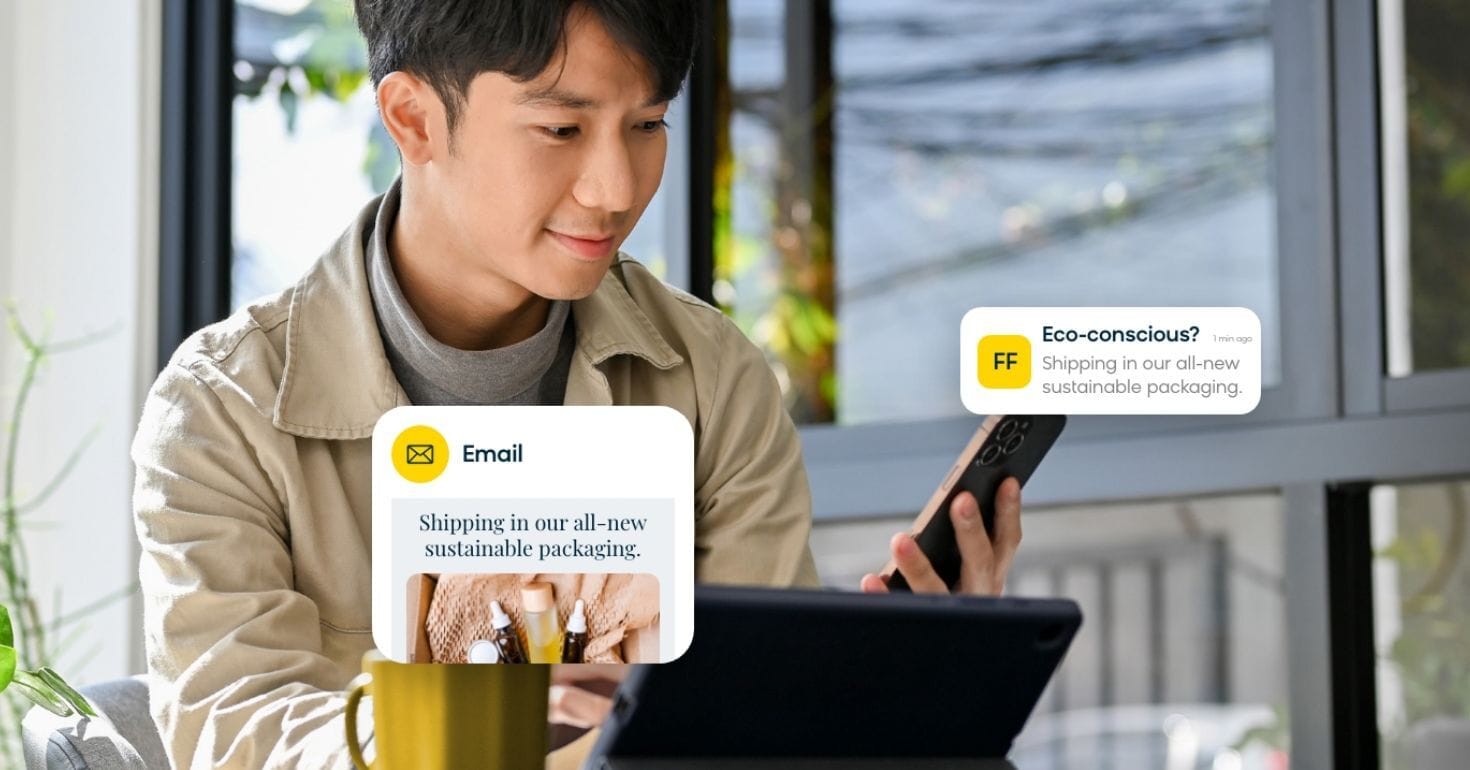
Additionally, the nature of product discovery itself is changing . Flavia De Pfyffer , a Fashion Lead at TikTok Shop, mentioned that “shopping behaviors have transitioned from active discovery and searching of products to products finding us through content.”
With the rise of generational monikers and buzz terms such as Gen Z and millennials prevalent in the media, panelists were asked about what value they see in marketing to audiences in this way and through demographic behaviors. They noted the significance of generational marketing and the power of cultural communities in shaping consumer behaviors.
Oliver Millar , the COO at Luxe Collective, noted that there’s a difference between customer bases that purchase and customer bases that consume social content. In particular, millennials and older audiences often purchase and convert at a higher rate than Gen Z audiences, who prefer authentic social content. This ties in to the significance of generational marketing and the power of cultural communities in shaping consumer behaviors.
On the plus side, these trends show that by investing in building brand affinity and brand loyalty with a Gen Z audience, brands will be in a prime position to convert those audiences later on when they have more purchasing power.
On the whole, understanding the unique preferences and behaviors of different generations and cultural communities will allow brands to tailor their strategies effectively.
Tactics To Engage and Convert Your Audience
One of the key ways the panelists suggested for engaging your audience is to build genuine connections and drive authentic audience engagement . This is crucial on any channel but especially on channels like TikTok , where a brand’s relatability reigns supreme.
TikTok trends suggest that a higher follower count for creators doesn’t necessarily equate to a higher conversion rate. In fact, it’s often the creators with smaller audiences that form a deeper level of connection and trust with their followers. This is why it’s important to focus on creating content relating to the specific needs of the people you’re targeting.
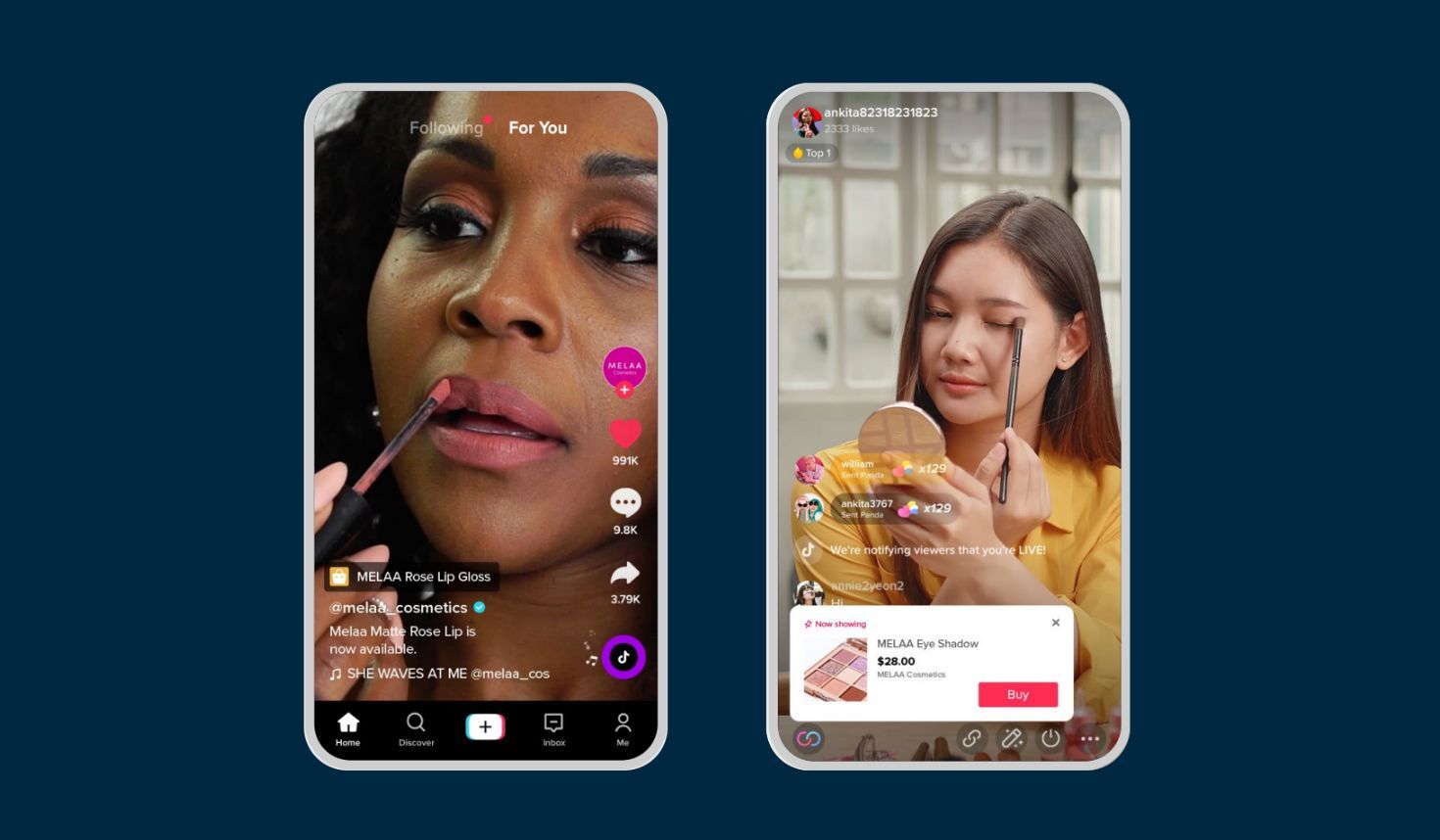
Oliver went on to talk about the success he’d seen with live shopping and creating 1:1 personal shopping experiences . Luxe Collective hosted a live show on its website where the team showcased various hand-picked new luxury products. While website views were generally lower than on social commerce channels, these website visitors were higher converting shoppers, and they even began to engage and chat with one another before the start of each live shopping experience. Luxe Collective’s approach is a prime example of leveraging the power of a strong community to engage and convert audiences.
Connor also shared his experience with using personalized engagement tactics at HMV, leveraging Bloomreach to tailor content and messaging based on audience behaviors and preferences. This approach of talking to customers on their terms resulted in a 10% uplift in email open rates and strengthened brand affinity.
Investing in the Right Tech Stack
Of course, none of the above tactics will be effective if you don’t have the right technology infrastructure to support your commerce initiatives. Elizabeth Azide , Director of Marketing in EMEA at BigCommerce, focused on the significance of composable commerce architecture in facilitating agility and flexibility, which in turn allows businesses to adapt quickly to changing trends and experiment with new strategies.
Composable commerce enables brands to architect a tech stack tailored to the specific needs of their business and their customers, from product discovery to checkout. A great example of this approach is how HMV uses hyper-personalization to engage with its K-pop audience — a critical tactic as it enables more customers to convert.
Composability allows you to bring together different solutions and offer a smooth progression through all the different stages of the customer journey. By integrating solutions that optimize online traffic, personalize the user experience, and streamline the checkout process, businesses can create a seamless and delightful journey for their customers.

“Composability is also about longevity,” according to Elizabeth. One constant is that markets and shopping trends will change. There will always be new generations to market and sell to. Setting up your business with the right tech stack to easily adapt to the changes that are inevitably coming is necessary to pull your business in the right direction and win with your customers.
Building a Test-and-Learn Strategy
A robust test-and-learn strategy is about driving continuous improvement and innovation. This is something that Luxe Collective is familiar with. Facing the abundance of data and available solutions in the market, the luxury fashion retailer’s agile team decided to strip things back to basics and focus on aligning tech solutions with their core business objectives and what they aimed to achieve.
Additionally, platforms that facilitate easy testing and experimentation are the ones you need in your tech stack. Legacy monolithic systems often hinder agility, whereas modern platforms like BigCommerce and Bloomreach empower businesses to test quickly and iterate based on real-time feedback.
Key Takeaways
As the discussion drew to a close, the panelists offered pieces of advice for businesses navigating the social commerce landscape:
- Bold experimentation is essential for growth and innovation
- Authenticity is key for driving conversions and fostering meaningful connections with consumers
- Mobile optimization is critical for engaging and converting customers
- Despite the abundance of data and tactics, businesses should focus on simplicity and clarity in their strategies
Staying ahead in the age of social commerce requires a deep understanding of the evolving customer journey, a commitment to authenticity and engagement, and the right technology infrastructure to support experimentation and innovation. By embracing these principles and leveraging the insights shared by industry leaders, businesses can thrive in an increasingly competitive digital landscape.
For even more insights into keeping customers engaged in the modern commerce landscape, listen to our Commerce Experience podcast episode on experiential retail.
- Best Practices , Commerce Experience , Headless Commerce , Marketing Automation , Product Recommendations
Donna-Marie Bohan
Donna-Marie is a senior content marketing specialist, writer, and editor with extensive experience in communications and B2B software marketing.
A former analyst, she enjoys exploring how digital marketing, media, and new technologies are shaping the future. She has authored a number of digital industry reports and her work has been featured across a number of publications, including City AM, the Financial Times, Forbes, Econsultancy, Marketing Week, Adweek, and MarTech Series.
Table of Contents
Share with your community, maintain an edge with these new posts.

- Personalization
Comprehensive Omnichannel Retail Strategy: Enhancing Customer Experience

- Grow AOV , Team Efficiency
New! Developer Resources for Bloomreach Discovery Now Available

- AI , Commerce Experience , Grow AOV , Team Efficiency
Understanding the Power of Hybrid Vector Search in Ecommerce
Subscribe to get our hot takes on ecommerce topics, trends and innovations delivered to straight your inbox., explore more resources.

Tune in to our Commerce Experience podcast series.

Read up on the latests in AI, commerce and personalization.

Become inspired with our collection of use cases.

Join our virtual events covering popular topics.
Find an in-person event to meet the Bloomreach team.

Read a number of guides covering best practices.

Analyst Reports
See how we stack up according to analysts.

Marketing Automation
Personalize marketing in real-time across email, sms, app, website, and more.
Product Discovery
Ecommerce search and merchandising focused on maximizing revenue.
Unified Data Platform
Customer & product data management, integrations and advanced analytics for omnichannell personalization.

London & New York, Sep 2024
Find the perfect package for your business. Unify all your customer and product data and deliver connected customer experiences with our three commerce-specific products.
Book a call with one of our experts

Warning: Internet Explorer No Longer Supported
The CAP no longer supports Internet Explorer as Microsoft has set June 15, 2022 as its end-of-life date. Some older CAP browser-based applications might continue to run in Internet Explorer directly, or in Edge using Internet Explorer mode, but the CAP will no longer provide technical support or additional development efforts for use of Internet Explorer. Review Browser and Operating System Requirements.
Alert Independence Day
In observance of Independence Day, the CAP offices will be closed July 4.
- ELSS Main Page
- Organization Profile
- Result Form Data Entry
- Evaluation Reports
- Competency Assessment Hub
- Join the CAP
- Shopping Cart Shop
- Member Resources Main Page
- Join / Renew
- Medical Students
- New in Practice
- House of Delegates
- Practice Management
- Pathology Careers
- Councils and Committees
- Advocacy Main Page
- Payments for Pathology Services
- Lobbying and Political Action
- Quality Payment Program for Pathologists
- Pathologists Quality Registry
- Laboratory Oversight and Regulation
- Latest News and Practice Data
- Laboratory Improvement Main Page
- Accreditation
- Proficiency Testing
- Laboratories Outside the USA
- Catalog and Ordering Information
- News and Updates
- Education Main Page
- Search Education Catalog
- Activities in Progress
- Protocols and Guidelines Main Page
- Cancer Reporting Tools
- Cancer Protocols
- Upcoming CAP Guidelines
- Current CAP Guidelines
- Publications Main Page
- Archives of Pathology & Laboratory Medicine
- Books from CAP Publications
- Update My Profile
- Access My Committees
- View My Order History
- Access My Transcript
- Change Password
- Member Resources
75 Years in Proficiency Testing: A Journey of Impact, Partnership, and Limitless Potential
The CAP proudly announces that 2024 marks 75 successful years in Proficiency Testing (PT) and External Quality Assessment (EQA). Throughout these seven and a half decades, we have embarked on a remarkable journey defined by resilience, innovation, and an unwavering commitment to transforming patients’ lives. At the heart of this expedition, we celebrate the laboratory professionals, the unsung heroes, who have played an instrumental role in shaping CAP’s PT/EQA programs and revolutionizing patient care.
Today, we are proud to offer more than 700 PT programs—including innovations that helped tackle emerging viruses and diseases such as mpox, SARS-CoV-2, and Zika. As we embark on the next 75 years, let us forge ahead, continue striving for the best possible outcomes for our patients, and revel in the promise of limitless potential—together.
View video in browser
Podcast Solid Podcasts
- Enhancing Public Health Readiness: Laboratory Preparedness Exercise Dr. Kathleen Beavis and Dr. Carol Rauch discuss the history of the program and its important role in helping laboratories assess and enhance their readiness for emergencies, disasters, and other challenging situations.
- Infectious Disease Program: Continuously Evolving to Bolster Public Health Dr. Christine Wojewoda and Dr. Daniel Rhoads discuss how the program has evolved over the years, its impact on public health, including the historic COVID-19 pandemic, and what future directions the program is focusing on to ensure that patients continue to receive accurate infectious disease test results.
- Dr. Georgios Papanicolaou: Father of Cytopathology and Inventor of the Pap Test CAP Staff Jun 28, 2024
- 75 Years in Proficiency Testing: A Journey of Impact, Partnership, and Limitless Potential CAP Staff Jun 26, 2024
- Workload Distribution Challenges and Solutions: Part Three Karim E. Sirgi, MD, MBA, FCAP Jun 19, 2024
- Workload Distribution Challenges and Solutions: Part Two Karim E. Sirgi, MD, MBA, FCAP Jun 12, 2024
- Part 1: Workload Distribution Challenges and Solutions Karim E. Sirgi, MD, MBA, FCAP Jun 5, 2024

IMAGES
VIDEO
COMMENTS
In this lesson, you learned what a user journey is and why they are so valuable for testing. Then you learned about a possible user journey a user of our course application can take. Finally, we wrote a single test that covered and verified all of the steps in our user journey. Congrats on completing the first course 🎉
E2E Journey Test is a type of usability testing method in software development that focuses on simulating the complete path a user takes while interacting with a mobile app or website. This approach aims to replicate the real-world user experience by following a series of steps and actions that a person would perform to achieve a specific user ...
User Journey Testing Guide (2023) User journey testing is the process of evaluating the complete experience of a user as they navigate through various stages of interaction with a product. It's not just about identifying usability issues; it's about uncovering the emotions, motivations, and pain points that users encounter along their journey.
So then, a user journey test is a programmatic, automated way to perform the same steps that the user would in the same circumstances. Stated another way, user journey tests assure the correctness of your website by simply walking the same paths that your users already do. The team of developers were already savvy unit testers, so they were ...
Columns capture the five key stages of the user journey: awareness, consideration, decision, purchase, and retention (see below). Rows show customer experiences across these stages—their thoughts, feelings, and pain points. These experiences are rated as good, neutral, and bad. To see how this works, consider a practical example.
User journey mapping is only as strong as it is truthful. Validate the map by moving through the user journey yourself. Usability testing, analytics, and reviews from real customers can also help validate that your map reflects the average customer reality. Continue to refine the map as you discover discrepancies. Other types of UX mapping
The 8-Step Process of User Journey Mapping. Choose a scope. Create a user persona. Define the scenario and user expectations. Create a list of touchpoints. Take user intention into account. Sketch the journey. Consider a user's emotional state during each step of the interaction. Validate and refine the user journey.
5. Map the customer journey. Illustrate the user journey by mapping these touchpoints on a visual timeline. This creates a narrative of users' reactions across your entire service blueprint. To represent your users' emotional states at each touchpoint, graph their correspondences like this:
User Journey Mapping Do's. Clarify your goals. Consider the scope. Gather a multidisciplinary team. Validate assumptions with analytics. Validate assumptions with interviews of loyal users. Start the journey prior to the customer's discovery of your product. Differentiate new and existing customers. Match the fidelity of the map to its goals.
Defining a new journey: within the design process, we can use a User Journey map to help us design a new process that allows the user to achieve their goal. Testing a product: we can use a User Journey as a testing tool, where we confront the user with our product, asking them to perform some tasks and analyzing the possible friction of the ...
The user journey map , also known as customer journey map or user experience journey map is a way to visually structure your knowledge of potential users and how they experience a service. Customer journey mapping is also a popular workshop task to align user understanding within teams. If backed up by user data and research, they can be a high ...
User journey testing is a way of evaluating how well your product or service meets the needs, goals, and expectations of your users. It involves creating realistic scenarios that simulate how ...
Future state user journey maps can also help product and UX design teams test and validate a vision before investing resources into its implementation. Day-in-the-life maps Day-in-the-life journey maps visualize a more detailed image of your customers' daily activities and their pain points than current state journey maps.
How to use a journey map to conduct a user testing session. 1.Write down an overview — Understanding the main goal your users are trying to accomplish. Before you set up a user journey map, you need to have a general understanding of the task your users are trying to accomplish. It helps to write this part down as it helps to reinforce the ...
End-to-end testing is an essential part of ensuring that your automated testing strategy matches the customer experience. If your end-to-end testing strategy doesn't align with the full user journey, the more likely it is that a critical bug may sneak into production, potentially costing your company revenue as customers abandon incomplete purchases.
Reducing churn rate for paying customers. 2. Build personas and define your user's goals. Develop at least one persona you'll use as your primary model. The more specifics you create about the behavior of your different users across the personas you identify, the better and more detailed your user journey map will be.
Definition of a Journey Map. Definition: A journey map is a visualization of the process that a person goes through in order to accomplish a goal. In its most basic form, journey mapping starts by compiling a series of user actions into a timeline. Next, the timeline is fleshed out with user thoughts and emotions in order to create a narrative.
So another real anti-pattern I see in a lot of these user acceptance user journey testings is, go to URL and sleep for three seconds. And type in a username and password and sleep for another five seconds. And this was a very synchronous, maybe old school first attempt at solving these kinds of problems.
To define everything that needs to happen internally to properly serve users. Examples of user and customer journey maps include companies like Hubspot, Zoom, Mailchimp, Dropbox, and Userpilot. Templates of user journey maps include service blueprints, customer empathy maps, user touchpoints, and effective journey maps.
User Journey Test. User-journey tests are a form of BusinessFacingTest, designed to simulate a typical user's "journey" through the system. Such a test will typically cover a user's entire interaction with the system in order to achieve some goal. They act as one path in a use case. They are usually BroadStackTests and as such, are usually slow ...
What Is a User Journey? User journey: (Or customer journey) A scenario-based sequence of the steps that a user takes in order to accomplish a high-level goal with a company or product, usually across channels and over time. The underlying goal of a user journey is high-level. Describing the journey will involve understanding the experience of a user across many points of interaction, because ...
A customer-journey map is an infographic visualization of the process that a persona segment goes through in order to accomplish a goal. Journey maps are useful in communicating the general narratives and themes uncovered by longitudinal research done to understand how a customer works toward a goal over time.. This journey map communicates the various steps in the process of researching ...
A user journey map, also known as a customer journey map, is a series of steps or interactions a user goes through to achieve a particular goal. User journey maps offer a holistic view of the user's entire experience, encompassing their emotions , motivations , and touchpoints throughout their interaction with a product or service.
Customer experience testing goes beyond the usability and user experience testing of websites, applications, and software. It aims to test a range of digital and physical products as well as services that span multiple online and offline points thought the customer's journey. In other terms, customer journey testing considers everything your ...
Let's explore the key learnings from the panel. The Evolving Customer Journey. In today's commerce landscape, authenticity reigns supreme as consumers seek genuine connections with brands that align with their values and interests.Connor Weir, a Community Marketing Manager at HMV, highlighted the disappearance of the singular customer archetype, emphasizing the existence of diverse niche ...
The CAP proudly announces that 2024 marks 75 successful years in Proficiency Testing (PT) and External Quality Assessment (EQA). Throughout these seven and a half decades, we have embarked on a remarkable journey defined by resilience, innovation, and an unwavering commitment to transforming patients' lives. At the heart of this expedition ...